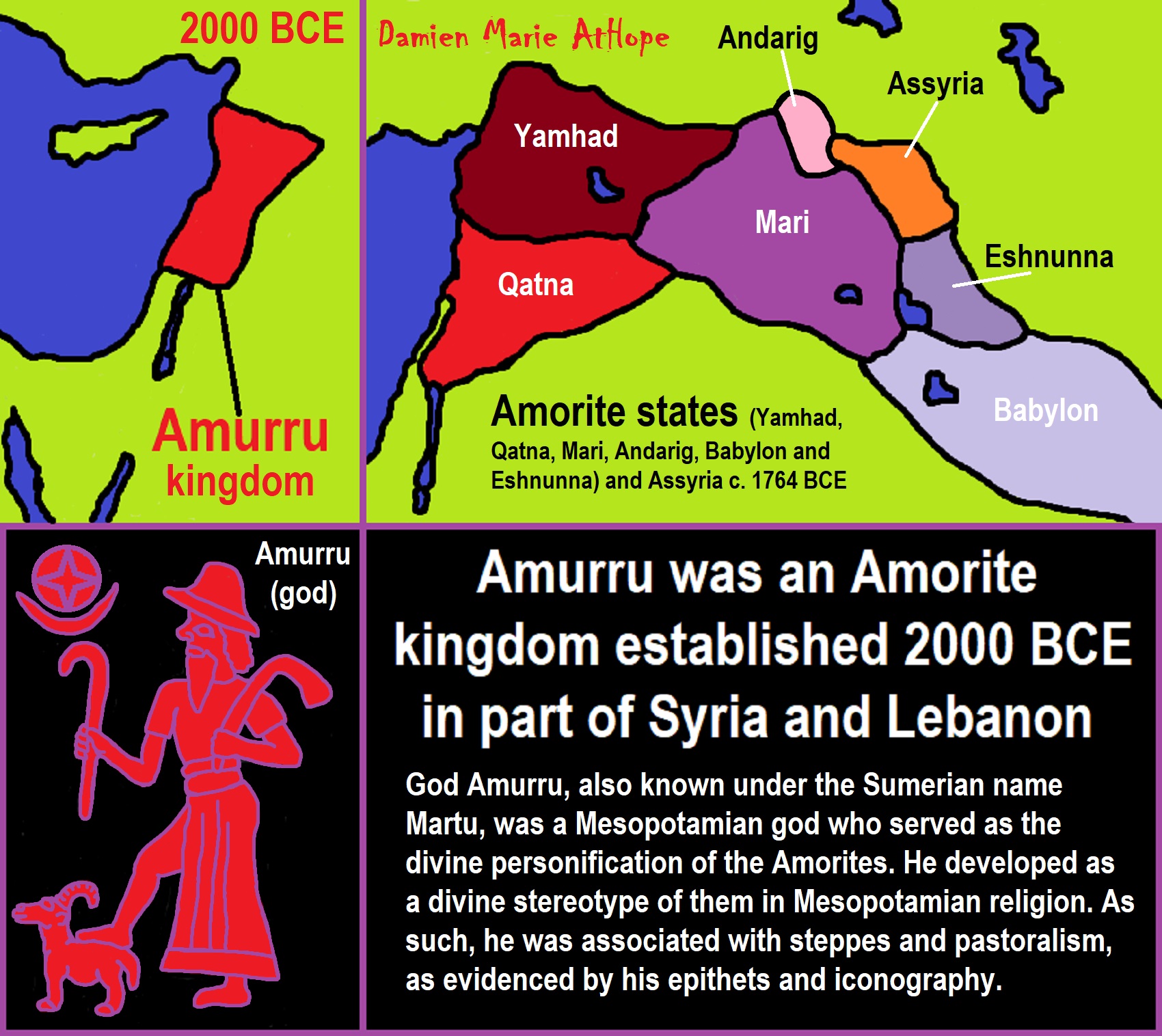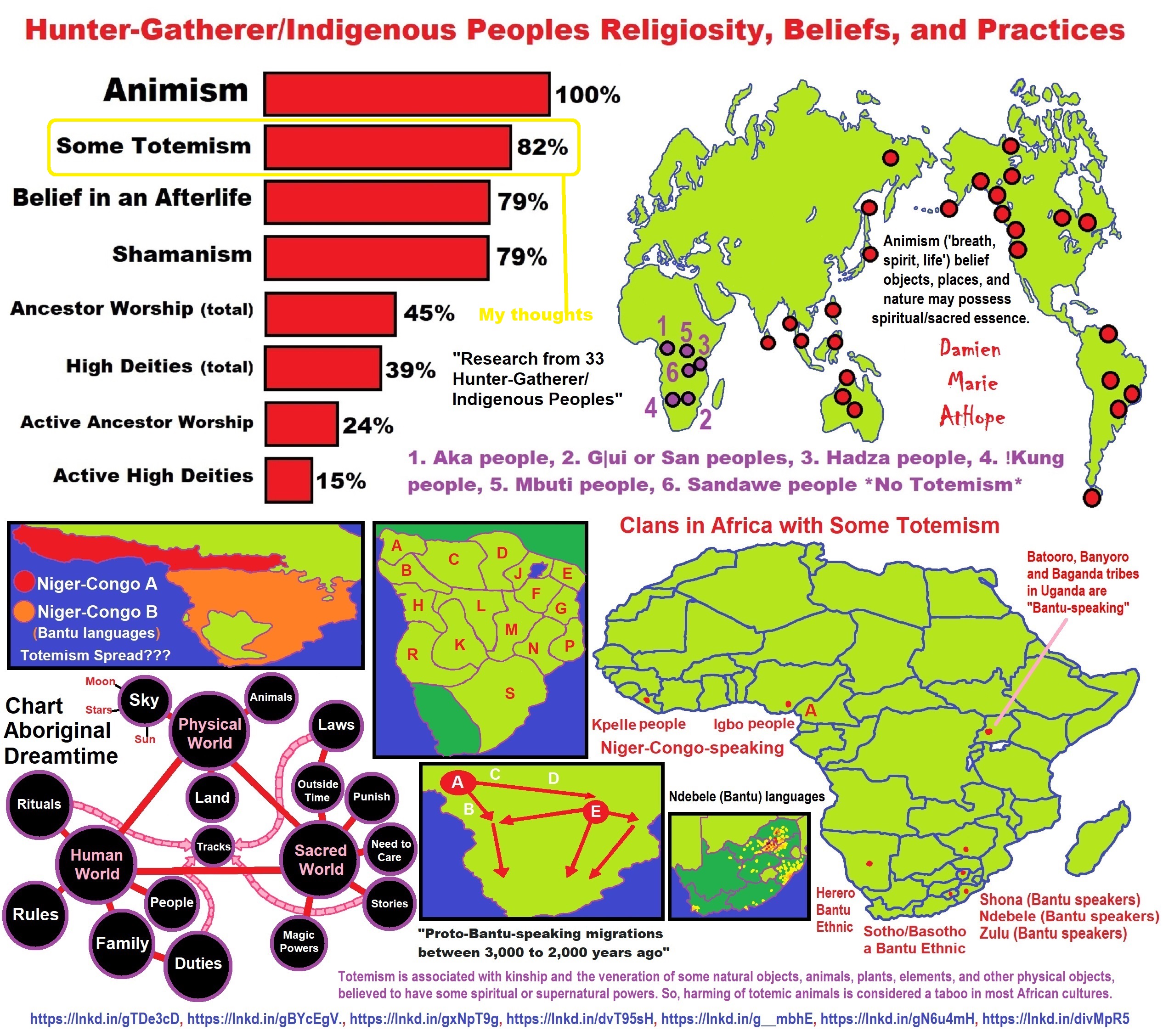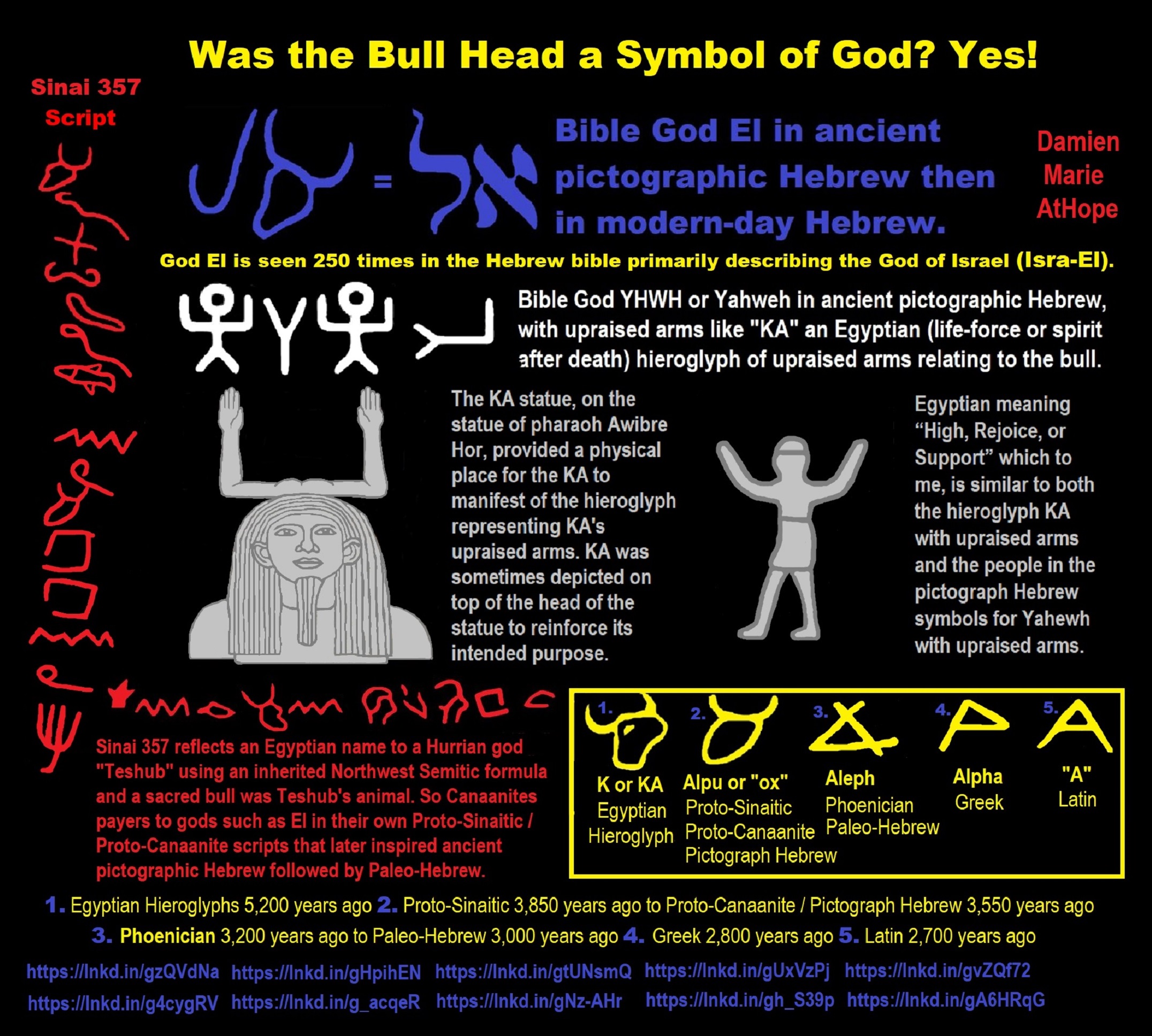
· Bible God El in ancient pictographic Hebrew then in modern-day Hebrew.
· God El is seen 250 times in the Hebrew bible primarily describing the God of Israel (Isra-El).
· Bible God YHWH or Yahweh in ancient pictographic Hebrew, with upraised arms like “KA” an Egyptian (life-force or spirit after death) hieroglyph of upraised arms relating to the bull.
· Egyptian with upraised arms means High, Rejoice, or Support, which to me, is similar to both the hieroglyph KA with upraised arms and the people pictographic Hebrew symbols (meaning Lo, Behold, “The”) for Yahweh with upraised arms.
· The KA statue, on the statue of pharaoh Awibre Hor, provided a physical place for the KA to manifest of the hieroglyph representing KA’s upraised arms. KA was sometimes depicted on top of the head of the statue to reinforce its intended purpose.
· Egyptian meaning “High, Rejoice, or Support” which to me, is similar to both the hieroglyph KA with upraised arms and the people in the pictograph Hebrew symbols for Yahewh with upraised arms.
· Sinai 357 reflects an Egyptian name to a Hurrian god “Teshub” using an inherited Northwest Semitic formula and a sacred bull was Teshub’s animal. So Canaanites payers to gods such as El in their own Proto-Sinaitic / Proto-Canaanite scripts that later inspired ancient pictographic Hebrew followed by Paleo-Hebrew.
· 1. Egyptian Hieroglyphs 5,200 years ago 2. Proto-Sinaitic 3,850 years ago to Proto-Canaanite / Pictograph Hebrew 3,550 years ago 3. Phoenician 3,200 years ago to Paleo-Hebrew 3,000 years ago 4. Greek 2,800 years ago 5. Latin 2,700 years ago. ref, ref, ref, ref, ref, ref, ref, ref, ref, ref, ref, ref, ref, ref
Here is my quick evolution of the Bible God’s names:
A Sky god, later named EL, was turned into El-Shaddai and El-ohim, then Yahweh, and later, the New Testament claimed Jesus.
“The sky often has important religious significance. Many polytheistic religions have deities associated with the sky. Daytime gods and nighttime gods are frequently deities of an “upper world” or “celestial world” as opposed to the earth and a “netherworld” (gods of the underworld are sometimes called “chthonic” deities). Any masculine sky god is often also king of the gods, taking the position of patriarch within a pantheon. Such king gods are collectively categorized as “sky father” deities, with a polarity between sky and earth often being expressed by pairing a “sky father” god with an “earth mother” goddess.” ref
“There is evidence that the Canaanite/Phoenician and Aramaic conception of El is essentially the same as the Amorite conception of El, which was popularized in the 18th century BCE but has origins in the pre-Sargonic period.” ref
“The Amorites are regarded as one of the ancient Semitic-speaking peoples. The Amorites were an ancient Northwest Semitic-speaking Bronze Age people from the Levant. Initially appearing in Sumerian records c. 2500 BCE, they expanded and ruled most of the Levant, Mesopotamia, and parts of Egypt from the 21st century BC to the late 17th century BCE.” ref
“Amurru, Amorite deity, occasionally called “lord of the steppe” or “lord of the mountain.” ref
“The term “El Shaddai” may mean “god of the mountains,” referring to the Mesopotamian divine mountain.” ref
“Elohim, morphologically, is the plural form of the word אֱלוֹהַּ[a] (eloah) and is related to El. It is cognate to the word ‘l-h-m, which is found in Ugaritic, where it is used as the pantheon for Canaanite gods, the children of El, and conventionally vocalized as “Elohim.” Rabbinic scholar Maimonides wrote that Elohim “Divinity” and elohim “gods” are commonly understood to be homonyms. One modern theory suggests that the notion of divinity underwent radical changes in the early period of Israelite identity and the development of Ancient Hebrew religion. In this view, the ambiguity of the term elohim is the result of such changes, cast in terms of “vertical translatability”, i.e. the re-interpretation of the gods of the earliest recalled period as the national god of monolatrism as it emerged in the 7th to 6th century BCE in the Kingdom of Judah and during the Babylonian captivity, and further in terms of monotheism by the emergence of Rabbinical Judaism in the 2nd century CE.” ref
“Yahweh[a] was an ancient Levantine deity worshiped in Israel and Judah as the primary deity and the head of the pantheon of the polytheistic religion of Yahwism. In later centuries, El and Yahweh became conflated, and El-linked epithets, such as ʾĒl Šadday (אֵל שַׁדַּי), came to be applied to Yahweh alone. Characteristics of other deities, such as Asherah and Baal, were also selectively “absorbed” in conceptions of Yahweh. In monotheistic Judaism the existence of other deities was denied outright, and Yahweh was proclaimed the creator deity and the sole deity to be worthy of worship. During the Second Temple period, Judaism began to substitute other Hebrew words, primarily ăḏōnāy (אֲדֹנָי, lit. ’My Lords’). By the time of the Jewish–Roman wars—namely following the Roman siege of Jerusalem and the concomitant destruction of the Second Temple in 70 CE—the original pronunciation of Yahweh’s name was forgotten entirely.” ref
“Yahwism is the name given by modern scholars to the religion of ancient Israel and Judah. An ancient Semitic religion of the Iron Age, Yahwism was essentially polytheistic and had a pantheon, with various gods and goddesses being worshipped by the Israelites. At the head of this pantheon was Yahweh, held in an especially high regard as the two Israelite kingdoms’ national god. Some scholars hold that the goddess Asherah was worshipped as Yahweh’s consort, though other scholars disagree. Following this duo were second-tier gods and goddesses, such as Baal, Shamash, Yarikh, Mot, and Astarte, each of whom had their own priests and prophets and numbered royalty among their devotees.” ref
To have faith is to make a presumption of faith towards something, and the most common use of faith is toward things that relate to concepts of gods, such as their names. Another way to have faith would mean to understand why a god would change their name. In the Jewish and Christian religions, their god’s name was changed. In the beginning, god’s eternal name is El, Near East god is the most holy and the father of all gods. El is a Semitic word meaning “god” or may relate to multiple ancient Near Eastern deities such as Hebrew: el, Amorite: il, Arabic ilah, Akkadian and Ugaritic: ilu, Aramaic and Phoenician: l, and is the known name of the original god to the Abrahamic religions. ref, ref, ref
In Judaism, the later Hebrew and Aramaic texts, as well as the Dead Sea Scrolls, dating around 2,408 to 1,700 years ago, used El or Elohim for the names of God and sometimes were in written paleo-Hebrew script dating about 3,000 years ago, and used in the ancient kingdoms of Israel and Judah, which shows that El was still treated as special. ref, ref
In the first statement of the Muslim confession of faith in the Quran, it states that “There is no god (ilah) except God (al-Lah or Allah).” And al-ilah, “the god” relates to El and Elah, the Hebrew and Aramaic words for God. ref, ref
Also what is interesting is that Hebrew is a Semitic language and according to a popular Israeli news source the Haaretz, the country Isra-El (Israel) expresses the relationship with the 3,300 years old Canaanite deity El who was the head of the Canaanite pantheon. ref
However, El’s name changed in the human-made Bible to El Shaddai. El Shaddai was the Bible-God’s name as first seen in Genesis 17:1, “God appeared to Abram, saying I am El Shaddai.” Similarly, in Genesis 35:11, Bible-God says to Jacob, “I am El Shaddai.” And seen in Exodus 6:2–3, El Shaddai was God’s name known to Abraham, Isaac, and Jacob. All must follow El and Baal whose features were absorbed into the Yahweh religion. ref
God El, the Semitic god, and the creator have a son named Baal “The Lord,” who is the governor of all adversaries to the fake god of the Jews, Yahweh or his other name El Shaddai. Bible-God, the Abrahamic god and the creator have a son named Jesus “The Lord.” It is interesting how people say that Jesus is “Lord” because Jesus is the son of Bible-God and without realizing they seem to be referencing Baal, which can mean “Lord” and is the son of El. No? Okay, let me try again! Why would a god go and change its name anyway? Some religious scholars have stated that the early Hebrews used the names Baʿal (“Lord”) and Baʿali (“My Lord”) to refer to the Lord of Israel, who is El and Yahweh. This use of Baʿal and Baʿali occurred both directly and as the divine element of some Hebrew theophoric names, which means consisting of the name of a deity and a verb. A few names that included the element Baʿal and presumably referring to Yahweh, including Saul’s son Eshbaʿal (“The Lord is Great”), and David’s son Beeliada (“The Lord Knows”). The name Bealiah is the combination of Baal and Yahweh (“The Lord is Jah” + “Yahweh is Baʿal” = “Yahweh is Lord”). ref
To have faith would mean you would have to believe that you already know all of your god’s different names and believe you have the right god and not some other religions’ god or a combination of gods.
Picture link: ref
Archaeological findings at Serabit el-Khadim
“Serabit el-Khadim is a locality in the southwest Sinai Peninsula, Egypt, where turquoise was mined extensively in antiquity, mainly by the ancient Egyptians. Archaeological excavation, initially by Sir Flinders Petrie, revealed ancient mining camps and a long-lived Temple of Hathor, the Egyptian goddess who was favored as a protector in desert regions. Thirty incised graffiti in a “Proto-Sinaitic script” shed light on the history of the alphabet. The mines were worked by prisoners of war from southwest Asia who presumably spoke a Northwest Semitic language, such as the Canaanite that was ancestral to Phoenician and Hebrew. After a century of study and the initial publication by Sir Flinders Petrie, researchers agree on the decipherment of a single phrase, cracked in 1916 by Alan Gardiner: לבעלת l bʿlt (to the Lady) [baʿlat (Lady) being a title of Hathor and the feminine of the title Baʿal (Lord) given to the Semitic god], although the word m’hb (loved) is frequently cited as a second word. The script has graphic similarities with the Egyptian hieratic script, the less elaborate form of the hieroglyphs.” ref
“Hathor was often depicted as a cow, symbolizing her maternal and celestial aspect, although her most common form was a woman wearing a headdress of cow horns and a sun disk. She could also be represented as a lioness, cobra, or sycamore tree. Cattle goddesses similar to Hathor were portrayed in Egyptian art in the fourth millennium BC, but she may not have appeared until the Old Kingdom (c. 2686–2181 BC). With the patronage of Old Kingdom rulers she became one of Egypt’s most important deities. More temples were dedicated to her than to any other goddess; her most prominent temple was Dendera in Upper Egypt. She was also worshipped in the temples of her male consorts. The Egyptians connected her with foreign lands such as Nubia and Canaan and their valuable goods, such as incense and semiprecious stones, and some of the peoples in those lands adopted her worship. In Egypt, she was one of the deities commonly invoked in private prayers and votive offerings, particularly by women desiring children.” ref
“Hathor is an ancient Egyptian goddess associated, later, with Isis and, earlier, with Sekhmet but eventually was considered the primeval goddess from whom all others were derived. She is usually depicted as a woman with the head of a cow, ears of a cow, or simply in cow form. In her form as Hesat she is shown as a pure white cow carrying a tray of food on her head as her udders flow with milk. She is closely associated with the primeval divine cow Mehet-Weret, a sky goddess whose name means “Great Flood” and who was thought to bring the inundation of the Nile River which fertilized the land.” ref
Sinai 357 reflects an Egyptian name fulfills a vow to a Hurrian god “Teššob/Teshub” using an inherited Northwest Semitic formula and a sacred bull was also his signature animal. Sinai 357 shows how the Canaanites try to write their payers to their gods such as El in their own Proto-Sinaitic / Proto-Canaanite scripts that later inspired ancient pictographic Hebrew that was followed by Paleo-Hebrew. ref, ref
“In the Hurrian schema, Hurrian god “Teššob/Teshub” was paired with Hebat the mother goddess; in the Hittite, with the sun goddess Arinniti of Arinna—a cultus of great antiquity which has similarities with the venerated bulls and mothers at Çatalhöyük in the Neolithic era. His son was called Sarruma, the mountain god.” ref
“The Hurrians worshipped a great number of gods derived from various different cultures, especially Mesopotamia and Syria. Many gods were syncretised with Mesopotamian and Syrian deities over time; for example, Šauška was identified with Ishtar of Nineveh, Teššub with the Weather god of Aleppo [de], Kušuḫ with the moon god Sîn von Ḫarran [de] and the Sun god Šimige with Šamaš of Sippar.[1] This syncretism also embraced the native partners of the gods, like the Syrian Ḫebat as wife of Teššub among the western Hurrians, Nikkal as wife of the moon god, and Aya as wife of the sun god. The chief god of the Hurrians was the weather god Teššub. All of the Hurrians also worshiped Šauška, god of love and war, the fertility-god Kumarbi, the moon god Kušuḫ and the sun god Šimige.[2] Only the western Hurrians worshipped Ḫebat and her son Šarruma, who were of Syrian origin. Other important deities were the mother goddesses Ḫudena Ḫudellura, the Syrian oath-goddess Išḫara [de] and Kubaba, as well as the Mesopotamian god of wisdom, Ea (Eya-šarri), and the death god Ugur. At least among the western Hurrians, the gods were divided into male and female groups, as is clear in the kaluti lists [de] from Hattusa. The male gods (enna turroḫena) were led by Teššub in his various manifestations, while the female gods (enna aštoḫena) were led by Ḫebat and her children. The order of the gods and goddesses in these lists is not entirely fixed, but lists of gods from Hattusa and Ugarit show clear similarities. Also, the presence of groups of gods, especially the father gods (enna attenevena) is shared in these lists. No similar lists of gods are known from the eastern Hurrian area. Dyads or double gods sharing a single cult are also typical of the Hurrians. For example, Ḫebat and her son Šarruma formed the dyad Ḫebat-Šarruma.” ref
“Although Sinai 357 is one of the longest and best-preserved early alphabetic inscriptions from Serabit el-Khadem, these characteristics have not made it any easier to interpret. Most scholars read it as a command from a mining foreman to one of his subordinates, but this reading creates logical and contextual problems. To avoid these problems, I read Sinai 357 as a votive inscription to the Hurrian deity Teššob that employs language similar to first-millennium Northwest Semitic dedicatory inscriptions. Such a reading reflects cultural and linguistic contact between speakers of Egyptian, Hurrian, and a Northwest Semitic language at the site of Serabit el-Khadem.” ref
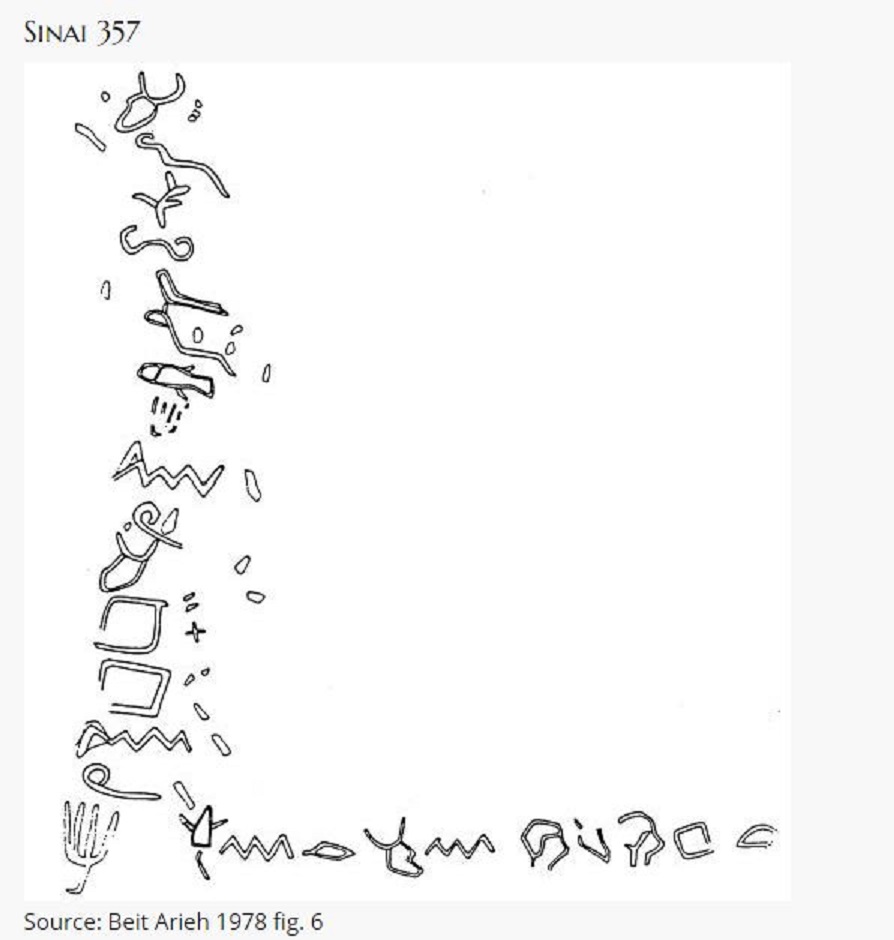
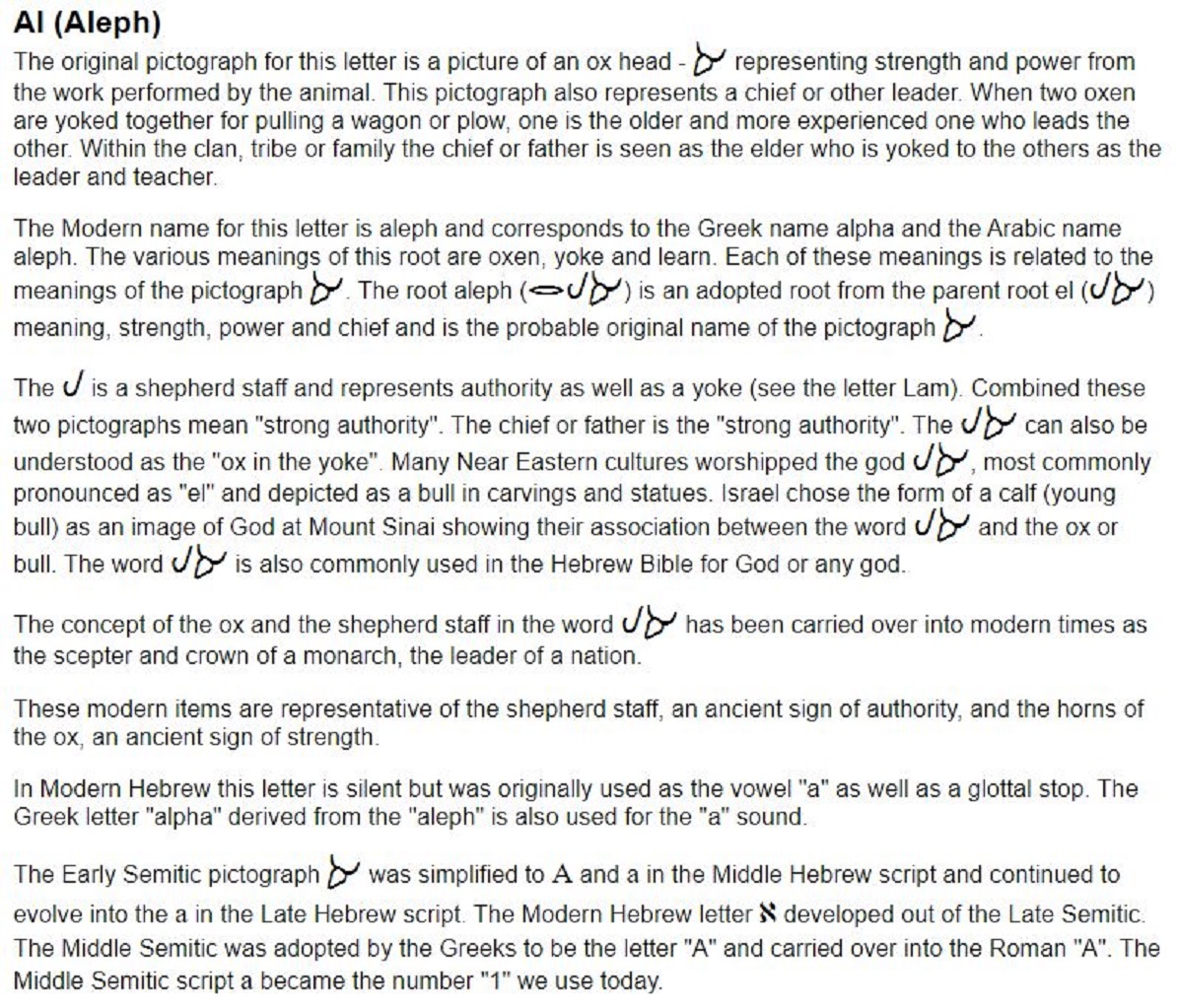
Picture link: ref
Bible Lexicons: Ancient Hebrew Alphabet
“The Ancient Hebrew letters form the foundation to the Ancient Hebrew language and a thorough study of these letters is essential to understanding the cultural background to the words they form. The process of reconstructing the original Hebrew alphabet is similar to the field of archeology, which digs down to hidden depths to determine the origins, culture or way of life of ancient civilizations. As artifacts are found, they are compared to artifacts of other cultures and other time periods to determine the distinctive characteristics of the culture and civilization. When studying Ancient alphabets, one digs down into the depths of time and compares the artifacts of pictographic and non-pictographic scripts to determine dates, meaning, and sound. We usually associate two characteristics for each letter, a form and a sound, as in the first letter of our alphabet whose form is “A” and has the sound “a”. The Ancient Hebrew alphabet has four characteristics: form, sound, name, and meaning.” ref
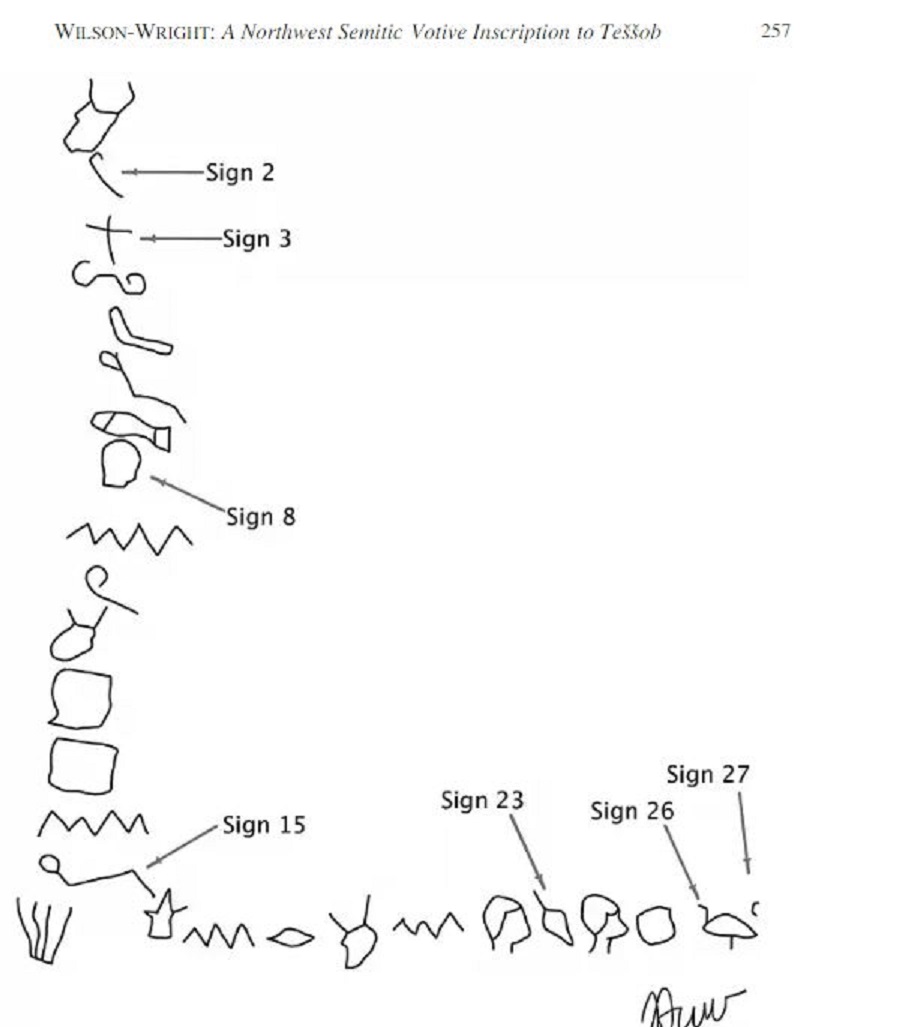
Picture link: ref
CONCLUSION
“Judging from the Egyptian inscriptions at Serabit el-Khadem, the Egyptian mining expeditions to the Sinai Peninsula were a multicultural affair. During the reigns of Amenemhat IIIand Amenemhat IV, Asiatics (ʿꜢmw), men of Reṯenu (rṯnw), and foreign dignitaries like Ḥabīdadu (m), brother of the prince of Reṯenu, all took part in such ventures. These individuals probably came from northern Syria and included speakers of Hurrian and a West Semitic language. The presence of so many foreigners in the expeditionary forces necessitated the use of translators (ʿw). It is within this culturally diverse context that the early alphabetic inscriptions at Serabit el-Khadem were most likely produced and Sinai 357 reflects this. In this inscription, someone with an Egyptian name fulfills a vow to a Hurrian god using an inherited Northwest Semitic formula.” ref
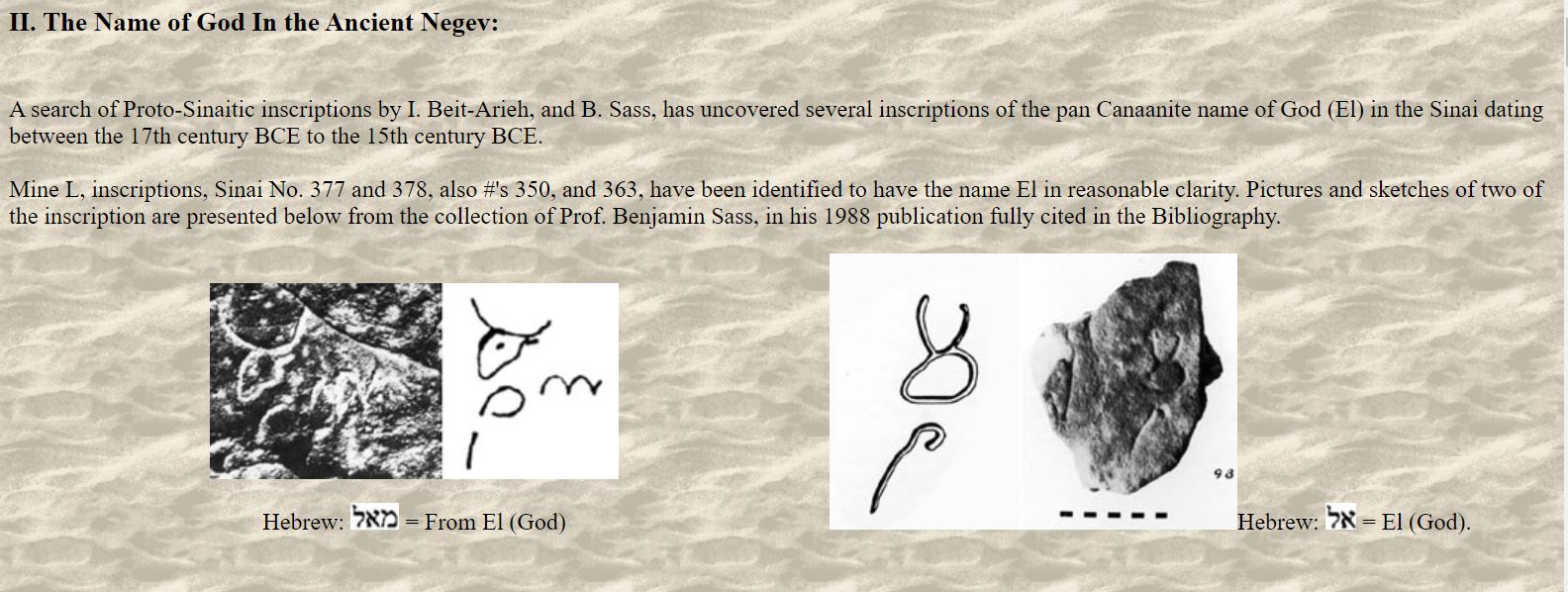
Picture link: ref
“A search of Proto-Sinaitic inscriptions by I. Beit-Arieh, and B. Sass, has uncovered several inscriptions of the pan Canaanite name of God (El) in the Sinai dating between the 17th century BCE to the 15th century BCE.” ref
“Mine L, inscriptions, Sinai No. 377 and 378, also #’s 350, and 363, have been identified to have the name El in reasonable clarity. Pictures and sketches of two of the inscription are presented below from the collection of Prof. Benjamin Sass, in his 1988 publication. Short inscriptions are very valuable in that they leave critics with little or nothing to argue about. El was the widely recognized God of all the Canaanite people and his name is coupled with Yah in some Proto-Canaanite inscriptions. But the name of Yah has not yet been found in the Sinai, or has it just gone unrecognized? The earliest El Yah inscription (late Late Bronze Age) was found on a beautiful Ewer, discovered in a rubbish heap of a temple at Lachish in 1934. A more recent article on the subject was a BAR, Sept/Oct. 1991, p. 50. work of Ruth Hestrin, titled “Understanding Asherah–Exploring Semitic Iconography.” Hestrin viewed the seven branched tree as an icon that favored the translation of “Elath”, as a female consort of El “Asherah.” We have numerous examples of the seven branched tree used as an icon for Yah (Yahweh) and sometimes in an El/Yah combination with such a tree and/or a ram. Also, the “Taw” after the El was an archaic ending for El. The “Yah of Gat” ligatures were recognized and translated by Harris and Hone. The Lachish Ewer,; (1220 BCE): Icon connection, a menorah, and a ram: It is also possible to begin reading at the rams head, left to right then right to left over the same line of signs across and down to the last two signs g-t.” ref
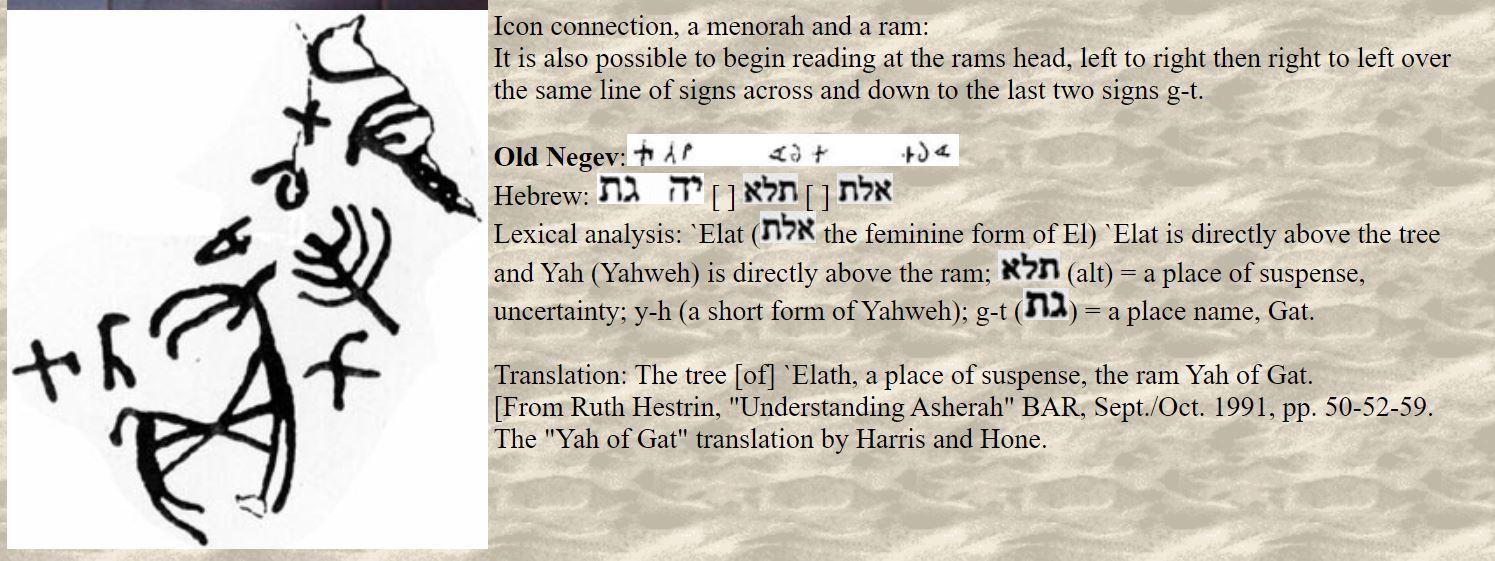
Picture link: ref
Picture link: ref
Ah-Lap = Ox Head, Cattle
“The original pictograph for this letter is a picture of an ox or bull head – representing strength and power from the work performed by the animal. This pictograph also represents a chief or other leader. When two oxen are yoked together for pulling a wagon or plow, one is the older and more experienced one who leads the other. Within the clan, tribe or family the chief or father is seen as the elder who is yoked to the others as the leader and teacher. The Early Semitic pictograph Ox Head was simplified to the image shown in the Middle Hebrew script and continued to evolve into the Assyrian script and then later in the Late Yiddish script.” ref
“The Modern Yiddish name for this letter is aleph and corresponds to the Greek name Alpha and the Arabic name Aleph. In Ancient Hebrew this letter is pronounce as “Ah”, in Modern Yiddish this letter is silent but was originally used as the vowel “A” as well as a glottal stop. The Greek letter “Alpha” derived from the “Aleph” is also used for the “A” sound. And the Modern Yiddish letter א developed out of the Late Semitic. The Middle Semitic was adopted by the Greeks to be the letter “A” and carried over into the Roman “A”. The Middle Semitic script became the number “1” we use today.” ref
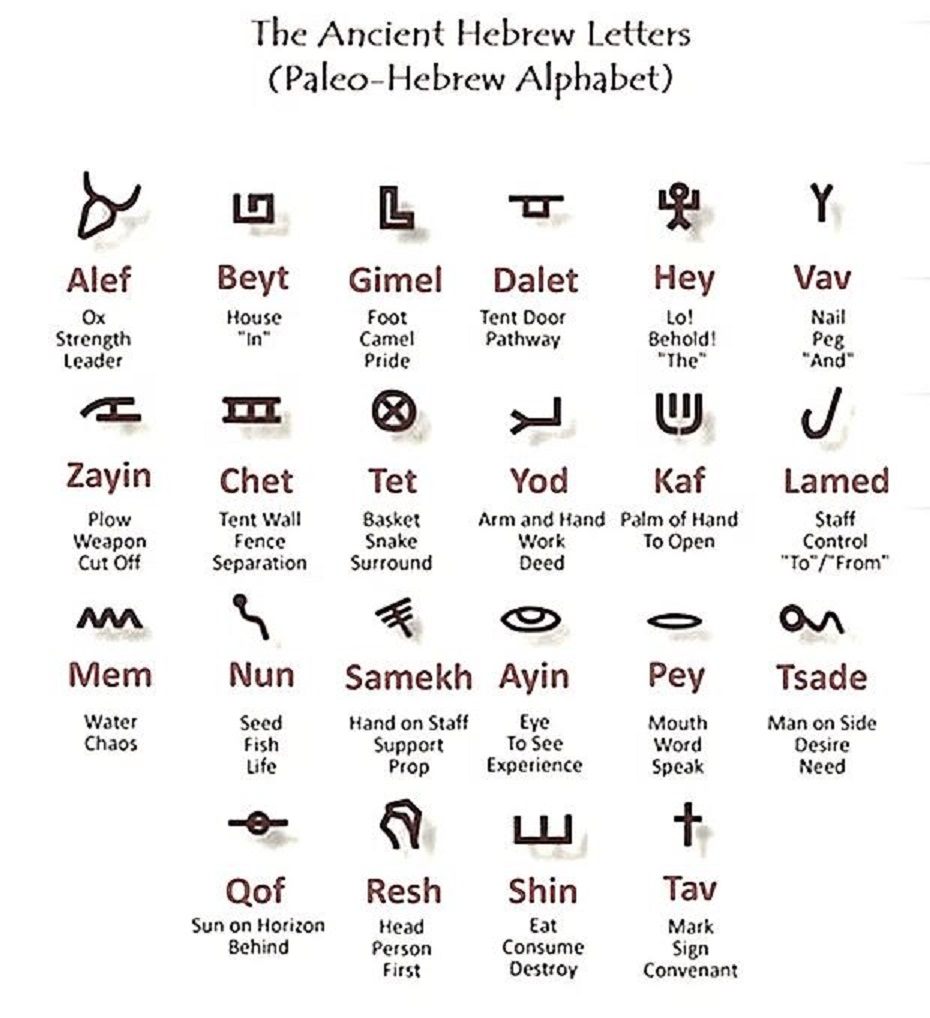
Picture link: ref
“Here is a chart of the Paleo Hebrew Aleph-Bet. (Aleph is the first letter of the Hebrew language and Bet is the second letter).” ref
“Proto-Canaanite script Precursor to Paleo-Hebrew Script Discovered in Jerusalem. The inscription—carved on a storage jar—is written in the Proto-Canaanite script and dates to the 11th or 10th century B.C.E. This lettered inscription featuring the earliest alphabet ever found in Jerusalem. The inscription precedes the development of the Paleo-Hebrew script used by the Israelites in the First Temple period. This Jerusalem Proto-Canaanite inscription precedes the development of the Paleo-Hebrew script, which was used by the Israelites until the Babylonians destroyed the First Temple in 586 B.C.E. When the Judean exiles returned from Babylon, they brought back the square Aramaic script, which ultimately replaced the Paleo-Hebrew script. Both the Paleo-Hebrew and the square Aramaic scripts, however, were used together for hundreds of years. This Proto-Canaanite Jerusalem inscription dates to a time before the direction of letters (whether they were read right to left or left to right) had been firmly determined and before a distinction between Hebrew, Aramaic and Phoenician had been established.” ref
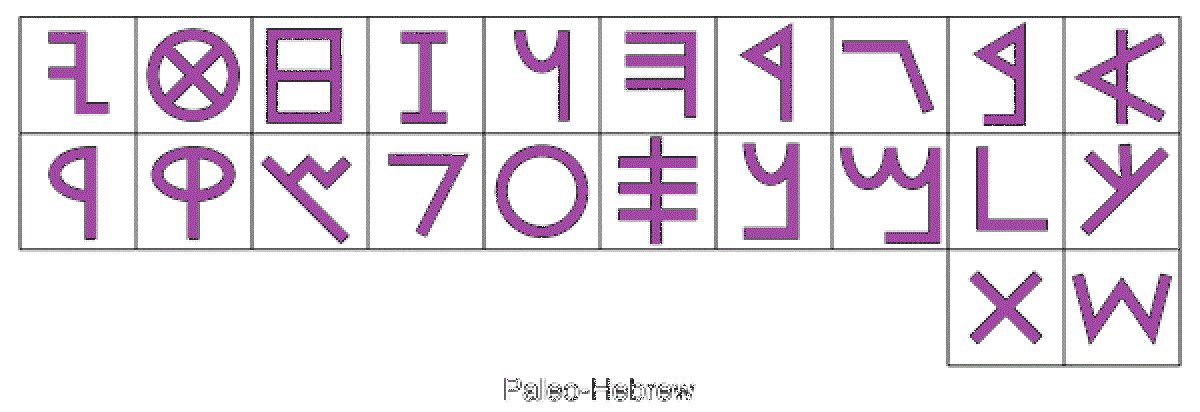
Picture link: ref
“Paleo-Hebrew was completely abandoned around the time of the destruction of the Second Temple in the year 70 C.E. Except for the inscriptions on a few ancient Jewish coins, no remnant of Paleo-Hebrew remained. The Babylonian Talmud (Sanhedrin 21b) has a pertinent discussion about these two forms of Hebrew writing: Mar Zutra3 or, some say, Mar Ukba said: Originally the Torah was given to Israel in Ivri (Paleo-Hebrew) letters and in the sacred Hebrew language. Later, in the times of Ezra,4 the Torah was given in Ashuri script and Aramaic language. Finally, they selected for Israel the Ashuri script and Hebrew language, leaving the original Hebrew5 characters and Aramaic language for the ignorant people. Rebbe Yose said: Why is it called Ashuri (Assyrian) script? Because they brought it with them from Assyria. This opinion coincides with the findings of modern archeologists, who maintain that around the year 1800 B.C.E., Egyptian hieroglyphics had inspired Phoenicians living and working in Egypt to develop Proto-Canaanite, a phonetic alphabet. Proto-Canaanite then evolved as Paleo-Hebrew and was the script used by all the peoples of the Middle East, including the Phoenicians, the Canaanites, the Moabites, and also the Hebrews. Archeologists have unearthed Paleo-Hebrew inscriptions on stone and pottery dating as far back as the twelfth century B.C.E. Around the year 800 B.C.E., Paleo-Hebrew letters became reworked in Babylon and the surrounding region8 and evolved as the native Aramaic script. Around 275 years later (circa 525 B.C.E.) the Jews in Babylon, notably Ezra the Scribe, refined the native Aramaic letters and developed Ashuri, the script recognized today as Hebrew.” ref

“Proto-Canaanite, ancestor of the Phoenician or Paleo-Hebrew script, is the name given to the Proto-Sinaitic script (c. 16th century BC), when found in Canaan. Attempts have repeatedly been made to derive the letters from Egyptian hieroglyphics, but with limited success. Other theories held that the Phoenician script developed from Akkadian cuneiform, Cretan hieroglyphs, the Cypriot syllabary, and Anatolian hieroglyphs. The Proto-Sinaitic inscriptions, along with the contemporary parallels found in Canaan and Wadi el-Hol, are thus hypothesized to show an intermediate step between Egyptian Hieratic and the Phoenician alphabet. Brian Colless (2014) notes that 18 of the 22 letters of the Phoenician alphabet have counterparts in the Byblos syllabary, and it seems that the proto-alphabet evolved as a simplification of the syllabary, moving from syllabic to consonantal writing, in the style of the Egyptian script (which did not normally indicate vowels); this goes against the Goldwasser hypothesis (2010) that the original alphabet was invented by miners in Sinai. According to the “alphabet theory”, the early Semitic proto-alphabet reflected in the Proto-Sinaitic inscriptions would have given rise to both the Ancient South Arabian script and the Proto-Canaanite alphabet by the time of the Late Bronze Age collapse (1200–1150 BCE). The theory centers on Albright’s hypothesis that only the graphic form of the Proto-Sinaitic characters derive from Egyptian hieroglyphs, and that they were given the sound value of the first consonant of the Semitic translation of the hieroglyph as many hieroglyphs had already been used acrophonically in Egyptian.” ref
“After the Babylonian capture of Judea, when most of the nobles were taken into exile, the Paleo-Hebrew alphabet continued to be used by the people who remained. One example of such writings are the 6th-century BCE jar handles from Gibeon, on which the names of winegrowers are inscribed. Beginning from the 5th century BCE onward, the Aramaic language and script became an official means of communication. Paleo-Hebrew was still used by scribes and others. Some Paleo-Hebrew fragments of the Torah were found among the Dead Sea Scrolls: manuscripts 4Q12, 6Q1: Genesis. 4Q22: Exodus. 1Q3, 2Q5, 4Q11, 4Q45, 4Q46, 6Q2: Leviticus. In some Qumran documents, YHWH is written in Paleo-Hebrew while the rest of the text is in Aramaic square script.” ref
“In the Dead Sea Scrolls dating from around 2,408 to 1,700 years ago and other Hebrew as well as Aramaic texts, sometimes names of God in Judaism (such as El or Elohim) were written in paleo-Hebrew script, around 3,000 years ago used in the ancient kingdoms of Israel and Judah, showing that El was still treated as special.” ref, ref
Canaanite God El and Mesopotamian God Anu
“In Sumerian, the designation “An” was used interchangeably with “the heavens” so that in some cases it is doubtful whether, under the term, the god An or the heavens is being denoted. In Mesopotamian religion, Anu was the personification of the sky, the utmost power, the supreme god, the one “who contains the entire universe”. Anu briefly appears in the Akkadian Epic of Gilgamesh, in which his daughter Ishtar (the East Semitic equivalent to Inanna) persuades him to give her the Bull of Heaven so that she may send it to attack Gilgamesh. Anu[a] or An[b] is the divine personification of the sky, supreme god, and ancestor of all the deities in ancient Mesopotamian religion. Anu was believed to be the supreme source of all authority, for the other gods and for all mortal rulers, and he is described in one text as the one “who contains the entire universe”. He is identified with the north ecliptic pole centered in the constellation Draco and, along with his sons Enlil and Enki, constitutes the highest divine triad personifying the three bands of constellations of the vault of the sky. Anu is commonly described as the “father of the gods”, and a vast array of deities were thought to have been his offspring over the course of Mesopotamian history. By the time of the earliest written records, Anu was rarely worshipped, and veneration was instead devoted to his son Enlil, but, throughout Mesopotamian history, the highest deity in the pantheon was always said to possess the anûtu, meaning “Heavenly power”. Although Anu was a very important deity, his nature was often ambiguous and ill-defined; he almost never appears in Mesopotamian artwork and has no known anthropomorphic iconography. During the Kassite Period (c. 1600 BC — c. 1155 BC) and Neo-Assyrian Period (911 BC — 609 BC), Anu was represented by a horned cap. In ancient Hittite religion, Anu is a former ruler of the gods, who was overthrown by his son Kumarbi, who bit off his father’s genitals and gave birth to the storm god Teshub. Teshub overthrew Kumarbi, avenged Anu’s mutilation, and became the new king of the gods. The Canaanites seem to have ascribed Anu’s attributes to El, the current ruler of the gods. In later times, the Canaanites equated El with Kronos rather than with Ouranos, and El’s son Baal with Zeus. A narrative from Canaanite mythology describes the warrior-goddess Anat coming before El after being insulted, in a way that directly parallels Ishtar coming before Anu in the Epic of Gilgamesh. El is characterized as the malk olam (“the eternal king”) and, like Anu, he is “consistently depicted as old, just, compassionate, and patriarchal”. In the same way that Anu was thought to wield the Tablet of Destinies, Canaanite texts mentions decrees issued by El that he alone may alter. In late antiquity, writers such as Philo of Byblos attempted to impose the dynastic succession framework of the Hittite and Hesiodic stories onto Canaanite mythology, but these efforts are forced and contradict what most Canaanites seem to have actually believed.” ref
“God El “strong controller” seen 250 times in the Hebrew bible primarily when describing the God of Israel (Isra-el).” ref
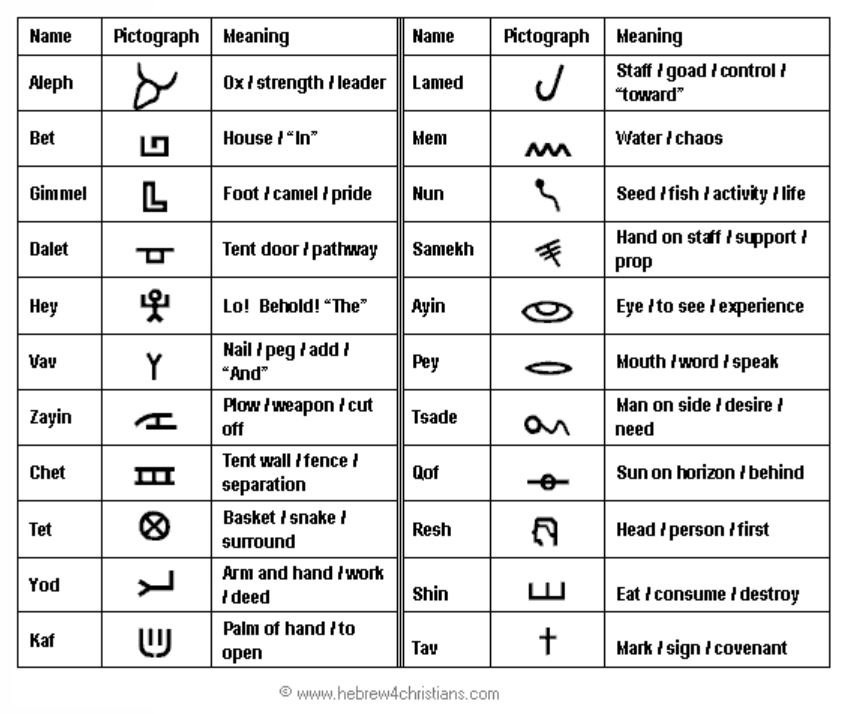
Picture link: ref
“Ka statue of the pharaoh Awibre Hor, on display at the Egyptian Museum, Cairo.” ref
“The ka statue, here that of pharaoh Hor, provided a physical place for the ka to manifest. The hieroglyph representing the ka is composed of a pair of upraised arms. It is sometimes depicted on top of the head of the statue to reinforce its intended purpose. A ka statue is a type of ancient Egyptian statue intended to provide a resting place for the ka (life-force or spirit) of the person after death. The ancient Egyptians believed the ka along with the physical body, the name, the ba (personality or soul), and the šwt (shadow), made up the five aspects of a person. After death, the ethereal aspects of the soul were believed to be released from the body, free to roam the earth, but required the physical body or a surrogate, such as the ka statue, to return to as a permanent home.” ref
“The most interesting belief of the Egyptians was that of the life force that they believed controlled all human beings. The “KA” as they believed was the life force responsible for animation, which is to say that as long as it’s present the person remains alive. Upon death the “KA” acquires a separate existence.” ref
“The Egyptian hieroglyph for cattle was a cow head with horns and is pronounced “KA”, but the Hebrew word for cattle was “ALEPH.” For example, the English letter “A” is derived directly from the Egyptian pictograph of a “cow head” (F1) and has a “K” sound. As we can see the phonic correspondence is broken, even though the same pictograph is used. Yet in Hebrew, the letter “A” corresponds to the Hebrew word for “cow/cattle”: Aleph.” ref
“The earliest known examples of writing in Egypt have been dated to 3,400 BC. The latest dated inscription in hieroglyphs was made on the gate post of a temple at Philae in 396 AD.” ref
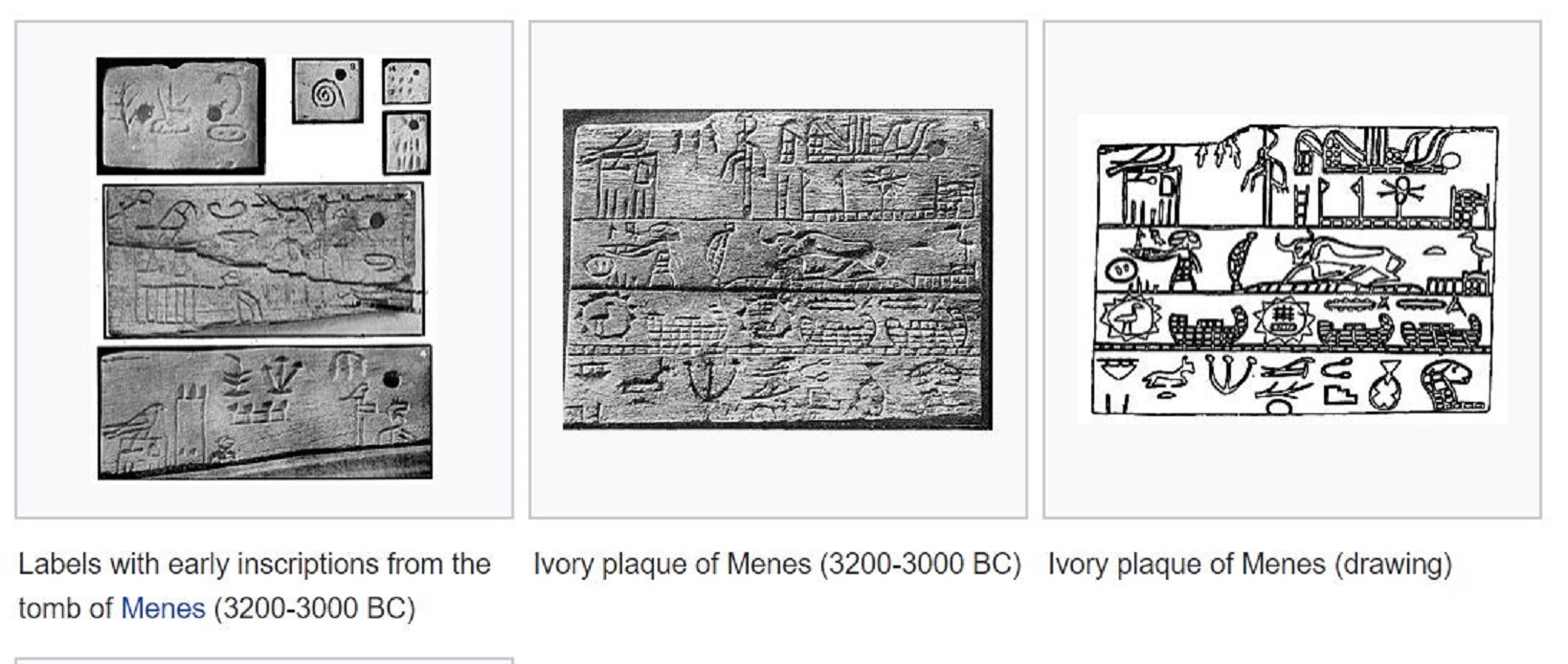
“Labels with early inscriptions from the tomb of Menes (3200-3000 BC)” ref
“Hieroglyphics developed out of the early pictographs. People used symbols, pictures to represent concepts such as a person or event. The problem with a pictogram, however, is that the information it contains is quite limited. Ancient Egyptian writing is known as hieroglyphics (‘sacred carvings’) and developed at some point prior to the Early Dynastic Period (c. 3150 -2613 BCE). Sometime in the latter part of the Predynastic Period in Egypt (c. 6000 – c. 3150 BCE), they began to use symbols to represent simple concepts. Egyptologist Miriam Lichtheim writes how this early script “was limited to the briefest notations designed to identify a person or a place, an event or a possession”. Most likely the earliest purpose writing served was in trade, to convey information about goods, prices, purchases, between one point and another. The first actual extant evidence of Egyptian writing, however, comes from tombs in the form of Offering Lists in the Early Dynastic Period. Death was not the end of life for the ancient Egyptians; it was only a transition from one state to another. The dead lived on in the afterlife and relied upon the living to remember them and present them with offerings of food and drink. An Offering List was an inventory of the gifts due to a particular person and inscribed on the wall of their tomb. Someone who had performed great deeds, held a high position of authority, or led troops to victory in battle were due greater offerings than another who had done relatively little with their lives. Along with the list was a brief epitaph stating who the person was, what they had done, and why they were due such offerings.” ref
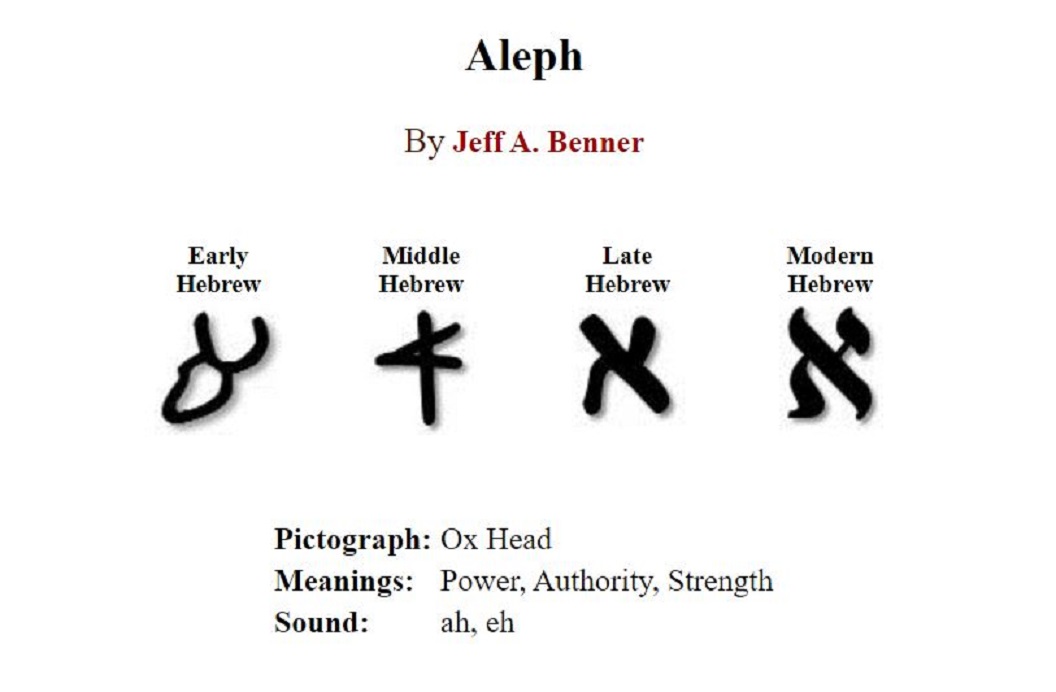
History & Reconstruction
“The original pictograph for this letter is a picture of an ox head () representing strength and power from the work performed by the animal. This pictograph also represents a chief or other leader. When two oxen are yoked together for pulling a wagon or plow, one is the older and more experienced one who leads the other. Within the clan, tribe or family the chief or father is seen as the elder who is yoked to the others as the leader and teacher. The Modern name for this letter is aleph and corresponds to the Greek name alpha and the Arabic name aleph. The various meanings of this root are oxen, yoke and learn. Each of these meanings is related to the meanings of the pictograph. The root (אלף) is an adopted root from the parent root אל (el), written as in the original script, meaning, strength, power, and chief and is the probable original name of the pictograph. The is a shepherd staff and represents authority as well as a yoke (see the letter lamed). When combined these two pictographs mean “strong authority.” The chief or father is the “strong authority.” They can also be understood as the “ox in the yoke.” Many Near Eastern cultures worshipped the god El () and were depicted as a bull in carvings and statues. Israel chose the form of a calf (young bull) as an image of God at Mount Sinai showing their association between the word and the ox or bull and is also commonly used in the Hebrew Bible for “God” or “god.” The concept of the ox and the shepherd staff in the word has been carried over into modern times as the scepter (as a staff) and crown (as horns) of a monarch, the leader of a nation. These modern items are representative of the shepherd staff, an ancient sign of authority, and the horns of the ox, an ancient sign of strength. In Modern Hebrew, this letter is silent but was originally used as the vowels “a” and “e.” The Greek letter alpha, derived from the aleph, is also used for the “a” sound. The Early Semitic pictograph was simplified to and in the Middle Hebrew script and continued to evolve into the in the Late Hebrew script. The Modern Hebrew letter א developed out of the Late Semitic. The Middle Semitic was adopted by the Greeks to be the letter “A” (alpha) and carried over into the Roman “A.” The Middle Semitic became the number “1” that we use today.” ref
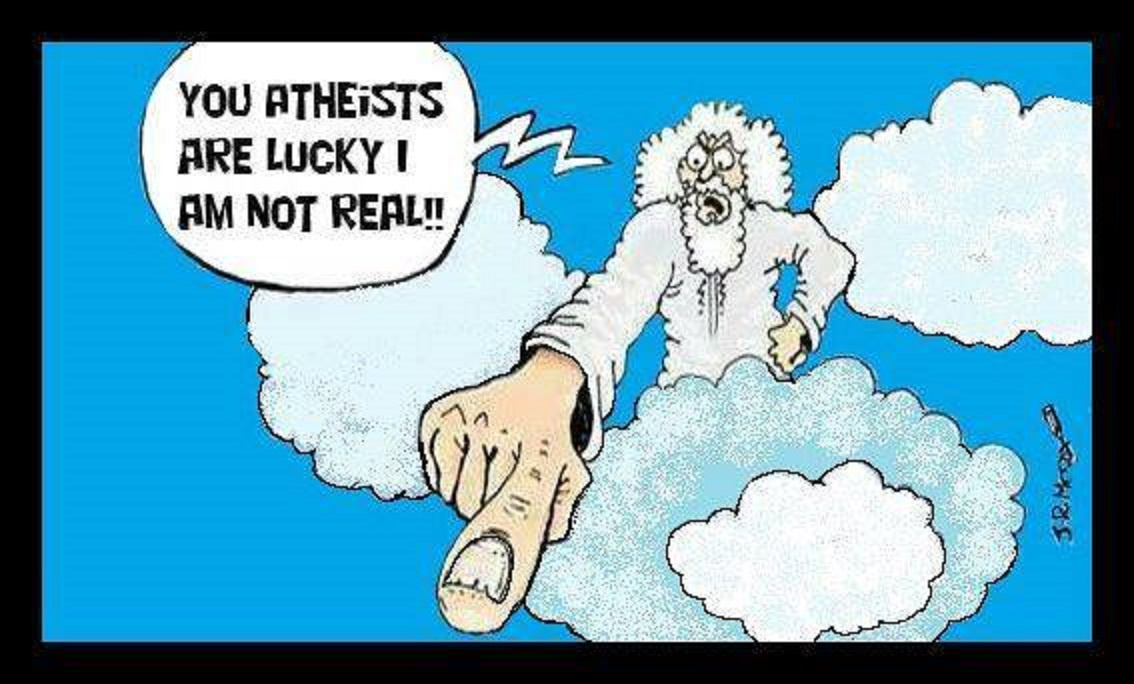
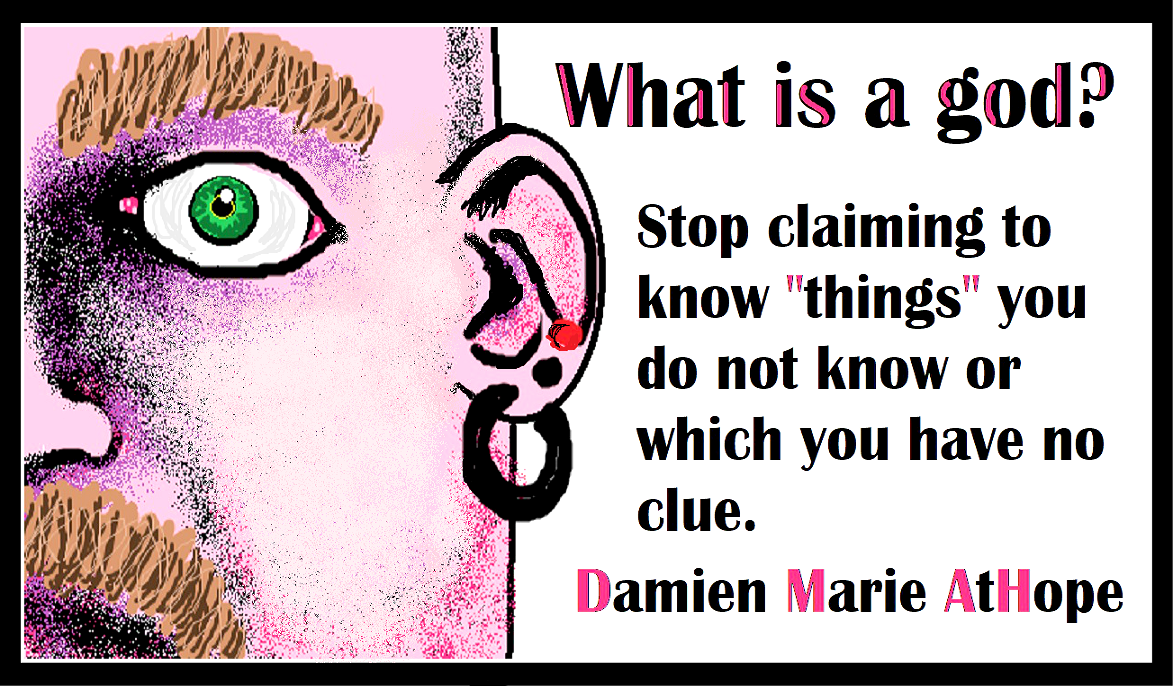
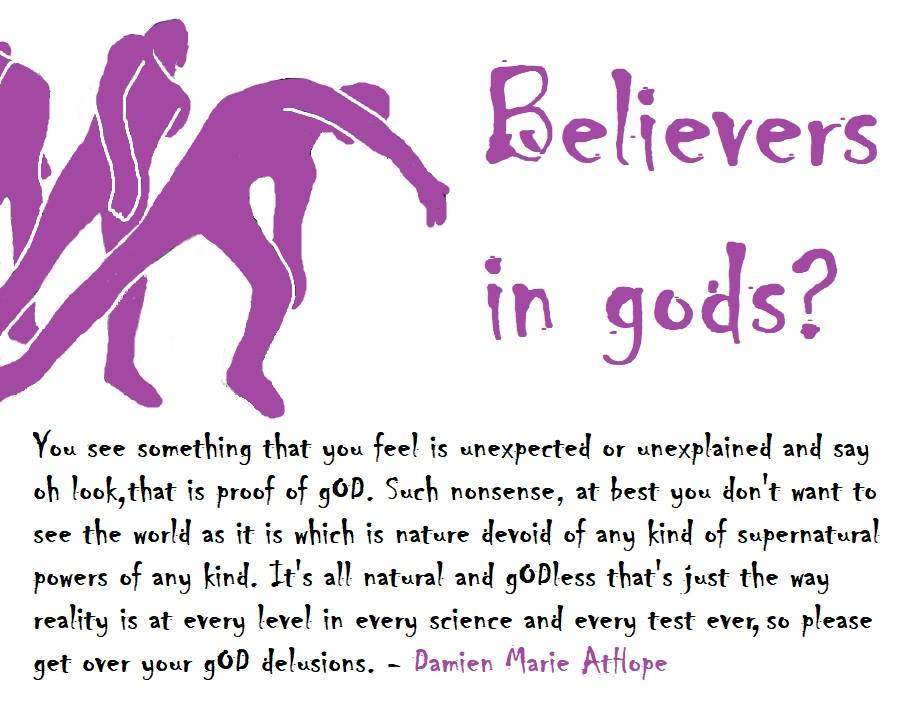
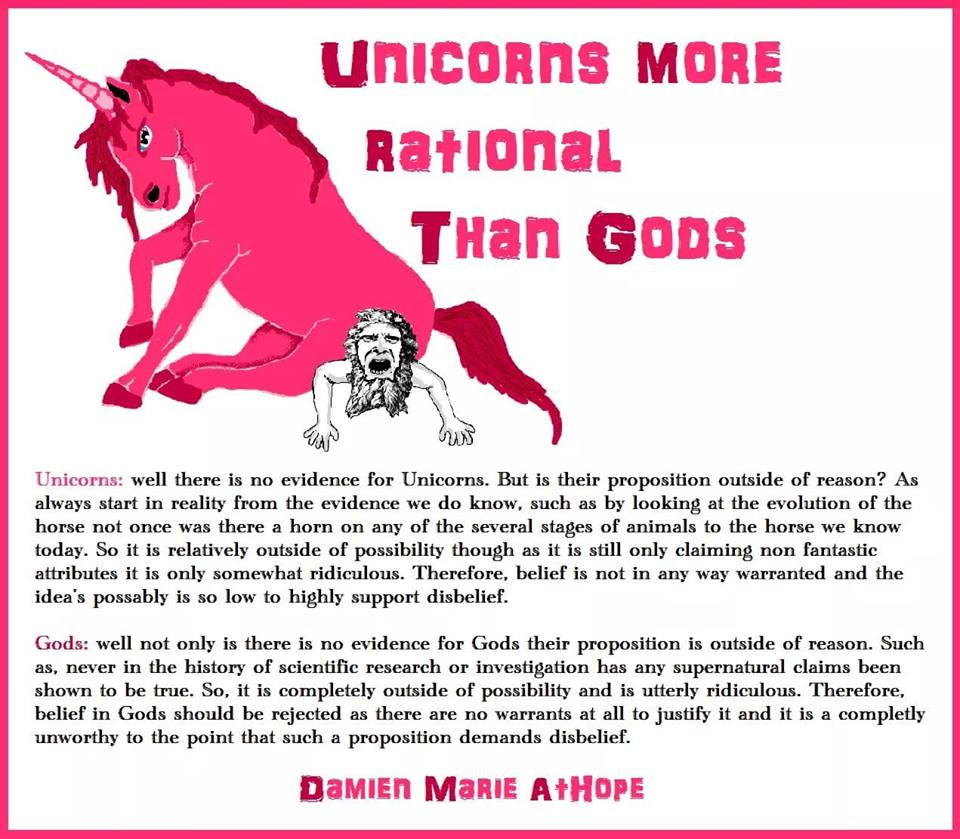
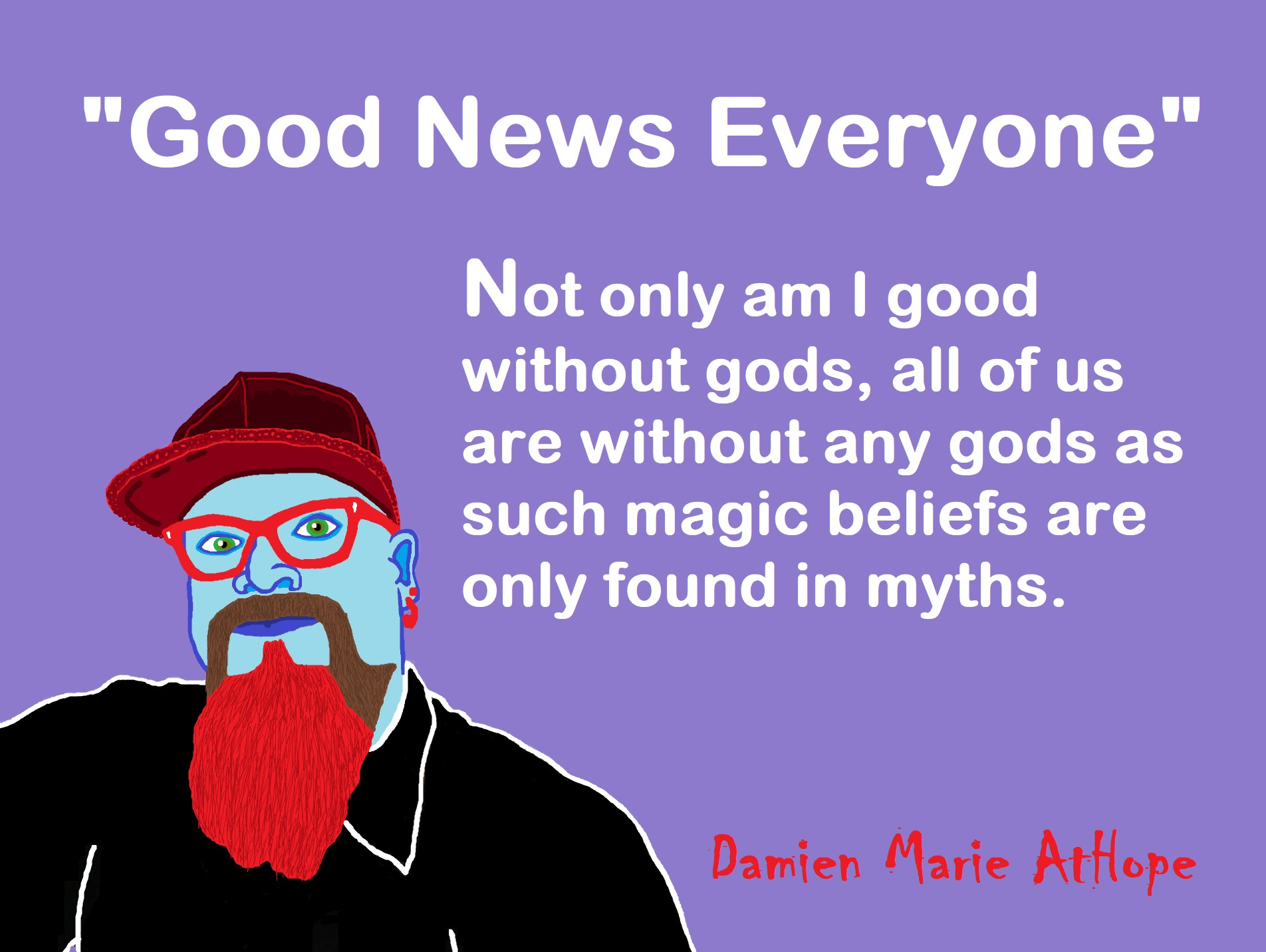
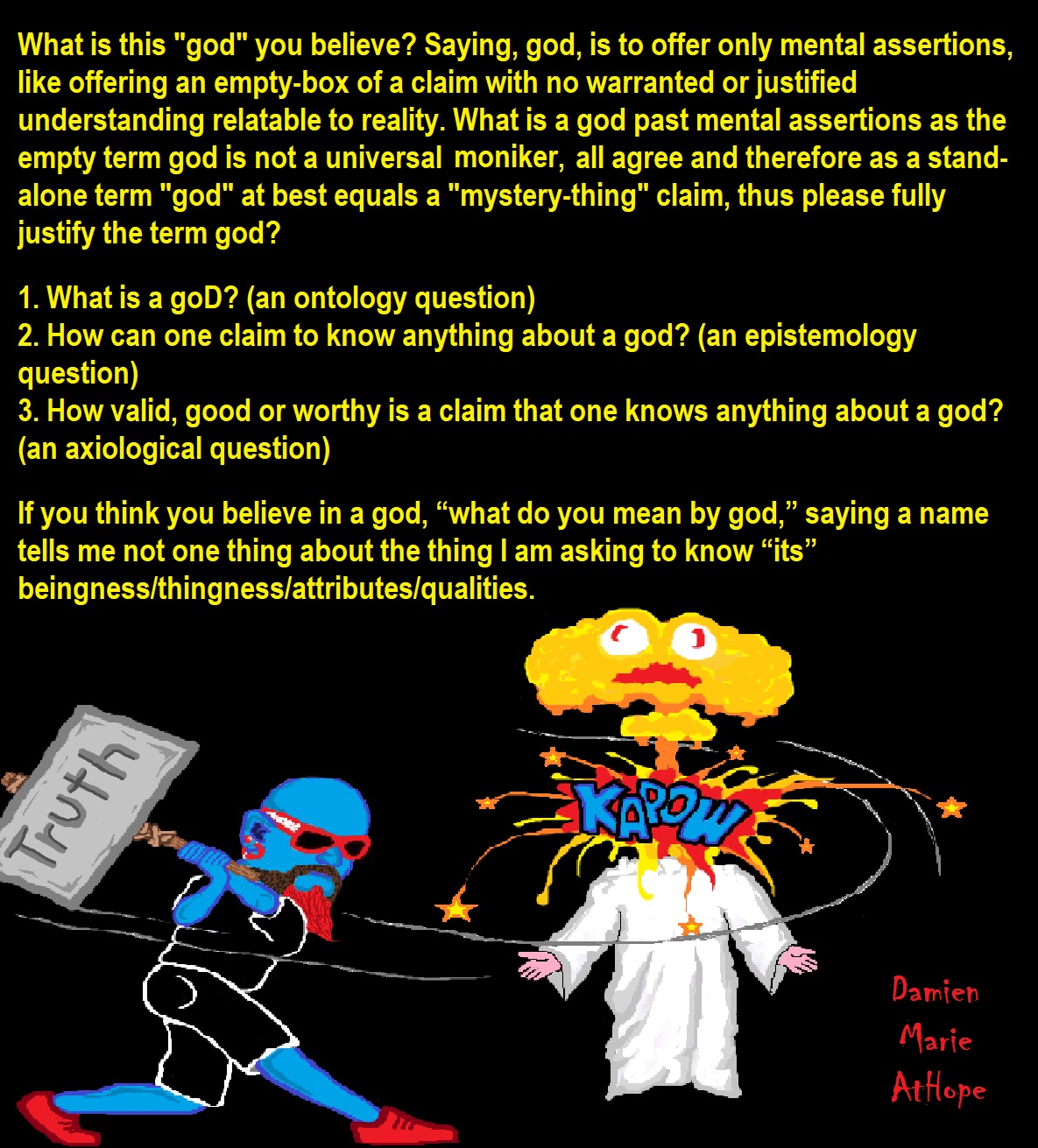
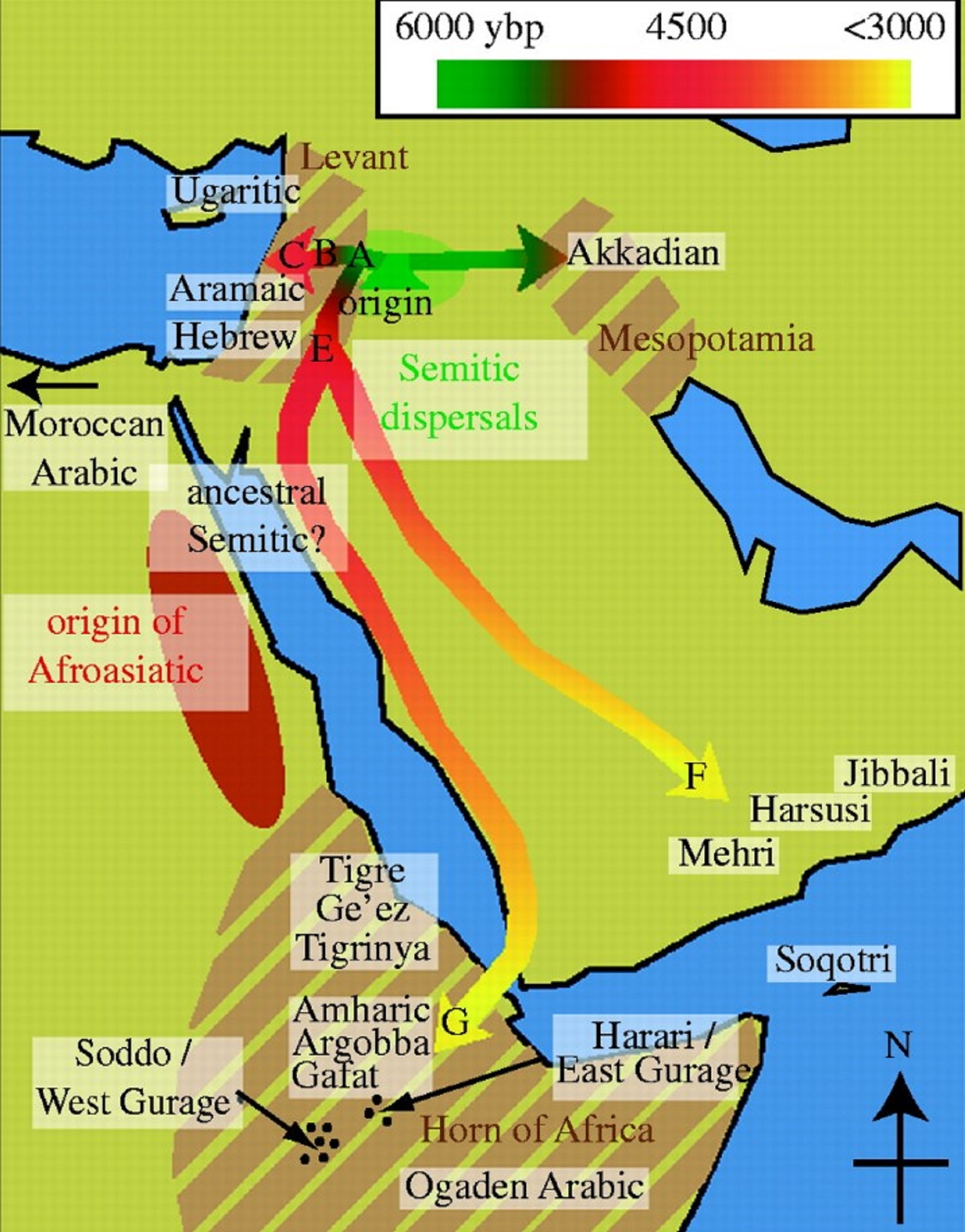
“Proto-Semitic itself must have been spoken before the emergence of its daughters, so sometime before the earliest attestation of Akkadian, and sufficiently long so for the changes leading from it to Akkadian to have taken place, which would place it in the 4th millennium BCE or earlier. A Bayesian analysis performed in 2009 suggests an origin for all known Semitic languages in the Levant around 3750 BCE.” ref
4th millennium BCE (4000 to 3000 BCE or 6,022 to 5,022 years ago)
“Some of the major changes in human culture during this time included the beginning of the Bronze Age and the invention of writing, which played a major role in starting recorded history. 3761 BCE – Since the Middle Ages (12th century), the Hebrew calendar has been based on rabbinic calculations of the year of creation from the Hebrew Masoretic text of the bible. This calendar is used within Jewish communities for religious and other purposes. The calendar’s epoch, corresponding to the calculated date of the world’s creation, is equivalent to sunset on the Julian proleptic calendar date 6 October 3761 BCE or 5,783 years ago.” ref
- Mesopotamia
- 4100–3100 BCE: the Uruk period, with emerging Sumerian hegemony and development of “proto-cuneiform“ writing; base-60 mathematics, astronomy and astrology, civil law, complex hydrology, the sailboat, potter’s wheel, and wheel; the Chalcolithic proceeds into the Early Bronze Age.
- 3500–2340 BCE; Sumer: wheeled carts, potter’s wheel, White Temple ziggurat, bronze tools, and weapons.
- First to the Fourth dynasty of Kish in Mesopotamia.
- Sumerian temple of Janna at Eridu was erected.
- Temple at Al-Ubaid and tomb of Mes-Kalam-Dug built near Ur, Chaldea.
- 3000 BCE – Tin is in use in Mesopotamia soon after this time.
- 3500–2340 BCE – First cities developed in Southern Mesopotamia. Inhabitants migrated from north.
- The cuneiform script proper emerges from pictographic proto-writing in the later 4th millennium BCE. Mesopotamia’s “proto-literate” period spans the 35th to 32nd centuries BCE. The first documents unequivocally written in the Sumerian language date to the 31st century BCE, found at Jemdet Nasr.
- Dams, canals, stone sculptures using inclined plane and lever in Sumer.
- Urkesh (northern Syria) founded during the fourth millennium BC possibly by the Hurrians.
- The Courtyard was introduced to Mesopotamia.
- Persian plateau
- 4000 BCE – Susa is a center of pottery production.
- c. 4000 BCE – Beaker from Susa (modern Shush, Iran) is made. It is now at Musée du Louvre, Paris.
- Proto-Elamite from 3200 BCE.
- Anatolia and Caucasus
- The Maykop culture of the Caucasus (c. 3700 BC to 3000 BCE), contemporary to the Kurgan culture, is a candidate for the origin of Bronze production and thus the Bronze Age.
- Kura-Araxes 3400–2000 BCE – earliest evidence found on the Ararat plain. ref
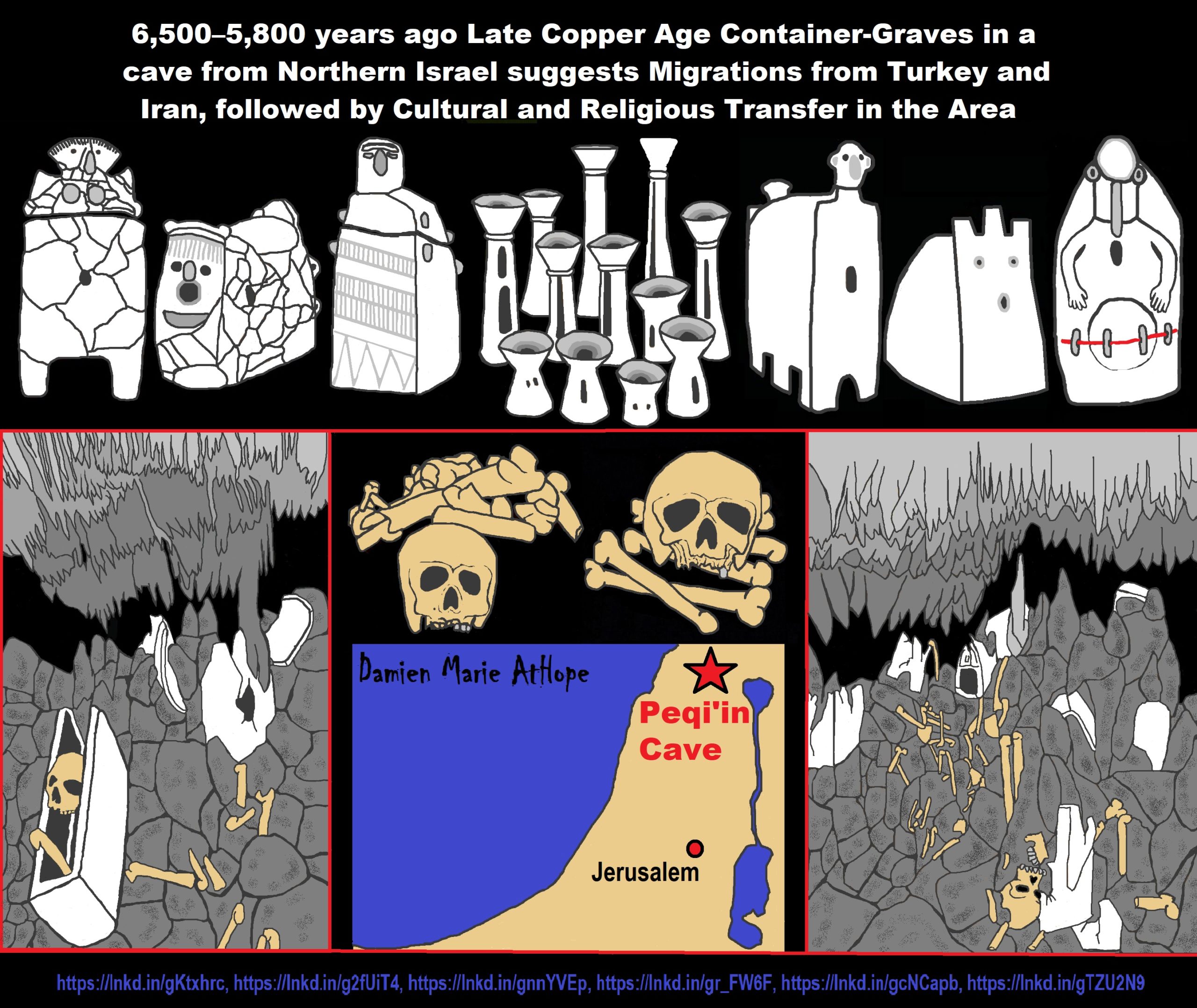
ref, ref, ref, ref, ref, ref, ref
DNA evidence expresses waves of migration from Anatolia and the Zagros mountains (today’s Turkey and Iran) to the Levant helped develop the Chalcolithic culture that existed in Israel’s Upper Galilee region some 6,500 years ago. ref
Ancient DNA from 22 Israel Late Chalcolithic Period individuals from Peqi’in Cave, Israel. These individuals were part of a homogeneous population that can be modeled as deriving ~57% of its ancestry from groups related to those of the local Levant Neolithic, ~17% from groups related to those of the Iran Chalcolithic, and ~26% from groups related to those of the Anatolian Neolithic. The Peqi’in population also appears to have contributed differently to later Bronze Age groups, one of which we show cannot plausibly have descended from the same population as that of Peqi’in Cave. These results provide an example of how population movements propelled cultural changes in the deep past. ref
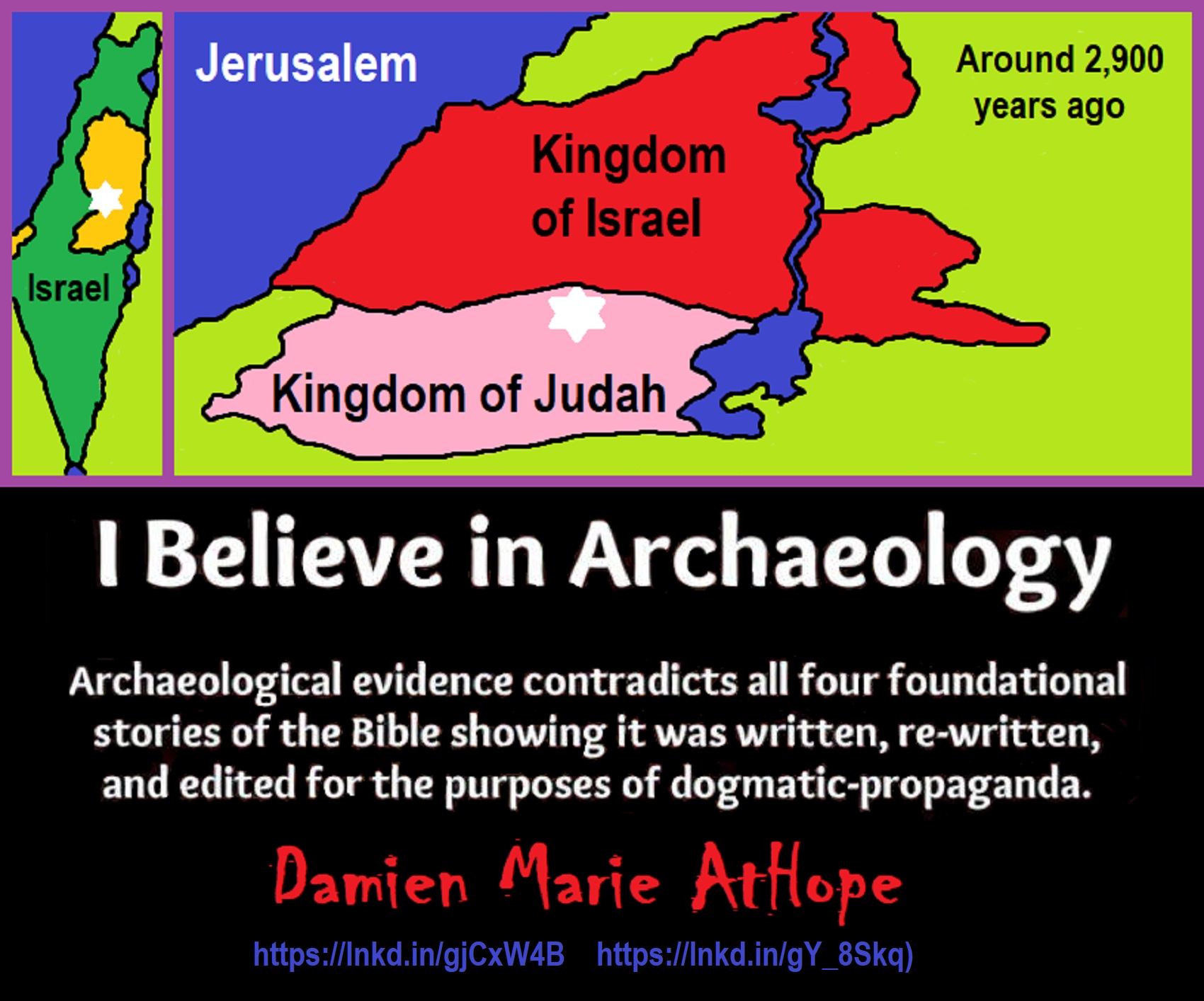
Archaeology Disproves the Bible:
1. Adm and Eve 6,000-Year-Old humanity Myth:
Genetic ‘Adam’ and ‘Eve’ Uncovered: https://www.livescience.com/38613-genetic-adam-and-eve-uncovered.html
“Researchers believe that modern humans left Africa between 60,000 and 200,000 years ago, and that the mother of all women likely emerged from East Africa. But beyond that, the details get fuzzy.” ref
Y-chromosomal Adam or human genetics Y-DNA most recent common ancestor (160,000-300,000 years ago): https://en.wikipedia.org/wiki/Y-chromosomal_Adam
Mitochondrial Eve or human genetics mt-DNA most recent common ancestor (100,000–230,000 years ago): https://en.wikipedia.org/wiki/Mitochondrial_Eve
Did a discrete event 200,000-100,000 years ago produce modern humans: https://www.ncbi.nlm.nih.gov/m/pubmed/22658331/?fbclid=IwAR1BjrR4iyHHaDebdPobOJY9jhJJCF2tsAmjp-WUPjMVosvHNs0UPzgkbIU
“Scenarios for modern human origins are often predicated on the assumption that modern humans arose 200,000-100,000 years ago in Africa. This assumption implies that something ‘special’ happened at this point in time in Africa, such as the speciation that produced Homo sapiens, a severe bottleneck in human population size, or a combination of the two. The common thread is that after the divergence of the modern human and Neandertal evolutionary lineages ∼400,000 years ago, there was another discrete event near in time to the Middle-Late Pleistocene boundary that produced modern humans. Alternatively, modern human origins could have been a lengthy process that lasted from the divergence of the modern human and Neandertal evolutionary lineages to the expansion of modern humans out of Africa, and nothing out of the ordinary happened 200,000-100,000 years ago in Africa. Three pieces of biological (fossil morphology and DNA sequences) evidence are typically cited in support of discrete event models. First, living human mitochondrial DNA haplotypes coalesce ∼200,000 years ago. Second, fossil specimens that are usually classified as ‘anatomically modern’ seem to appear shortly afterward in the African fossil record. Third, it is argued that these anatomically modern fossils are morphologically quite different from the fossils that preceded them.” ref
2. The Bible flood myth:
Flood Accounts: Gilgamesh epic (4,100 years ago) Noah in Genesis (2,600 years ago)
Everyone Killed in the Bible Flood? “Nephilim” (giants)?
Was Noah’s Ark found on Mount Ararat as claimed by Ron Wyatt? No, of course not.
3. The myth of the Exodus:
Hey, Damien dude, I have a question for you regarding “the bible” Exodus.
Is there EXODUS ARCHAEOLOGY? The short answer is “no.”
4. The myth of conquering the land of Canaan; the land which the tribes of Israel supposedly conquered after the supposed Exodus from Egypt (such as the lie of Jericho):
Canaanites and Israelites?
The Jericho Conquest lie?
Bible Battle, Just More, Bible Babble
5. The bible myth about a ‘United Monarchy’ full of splendor and power – the period of Saul, David and Solomon–as presented in the biblical account.
‘United Monarchy’ full of splendor and power – Saul, David, and Solomon? Most likely not.
Archaeology disproves all the beginning of the bible and thus discredits all
Abrahamic religions are based on it, so this includes Jewish, Christian, Muslim, Mormon, etc.
Faith seems to be found among the foolish but is an imprisoned tormented fool among the wise. Faith is like the Gloryhole of bad thinking and the Champion of unsupported beliefs. I reject the notion that humans are born with the inclination for Religion. Rather, we are born with a superstitious Animism thinking mind until the age of about 7 years old and it is out of this childlike daydreaming that Religion emerges with the help of people desiring to control.
The Bible Unearthed: Archaeology’s New Vision of Ancient Israel and the Origin of Its Sacred Texts, involves leading scholars Israel Finkelstein and Neil Asher Silberman who draw on recent archaeological research to present a dramatically revised portrait of ancient Israel and its neighbors. They argue that crucial evidence (or a telling lack of evidence) at digs in Israel, Egypt, Jordan, and Lebanon suggests that many of the most famous stories in the Bible—the wanderings of the patriarchs, the Exodus from Egypt, Joshua’s conquest of Canaan, and David and Solomon’s vast empire—reflect the world of the later authors rather than actual historical facts. What they argue, in chapter after chapter, is that these books of the Bible make the most sense as coming out of a seventh-century (BC) context. A lot of the Bible is royal and elite propaganda to justify empire expanding through conquest. Overall the differing archaeology evidence and the complete lack of any confirming archaeology evidence is devastating to all the Abrahamic religions. Ref
Some stories in the Bible were meant to be history, others fiction. But modernity has obscured the original distinction between the two kinds of biblical writing, depriving readers of the depth of the text. Perhaps surprisingly, this confusion lies at the heart of the History Channel’s miniseries “The Bible,” which continues the pattern of blurring history and fiction, and thereby misrepresenting the nature of the Bible to its viewers. One way to understand the difference between history and fiction in the Bible is through the Old Testament’s natural division into three parts:
- The world and its nature (Adam to Terah).
- The Israelites and their purpose (Abraham to Moses).
- The Kingdom of Israel and life in Jerusalem (roughly from King David onward).
Even a cursory look reveals a clear and significant pattern. In the first section, characters live many hundreds of years, and in the second, well into their second century. Only in the third section do biblical figures tend to live biologically reasonable lives. For example, Adam, in the first section, lives to the symbolic age of 930, and Noah lives even twenty years longer than that. Abraham, from the second section, lives to be 175, his son Issac to 180, and Jacob “dies young” at the age of 147. But the lifespans from King David onward, in the third section, are in line with generally accepted human biology. Furthermore, historians mostly agree that only the third section represents actual history. The reasonable ages in the third section of the Bible, and, in particular, the wildly exaggerated ages in the first, suggest that the authors of the Old Testament intended only the third part as history. Underscoring this crucial difference, some of the lifespans in the first two sections are so absurd as to defy literal interpretation. These hugely advanced ages are central clues about the point of the stories. The Old Testament contains a wide range of texts in addition to stories: laws, prayers, moral codes, and more. But even the stories come in more than one variety. Noah and the Great Flood are not in the same category as Moses and the Ten Commandments, and both are different than King David and the First Temple. History and fiction mingle throughout the Old Testament, so these divisions are just rough guides. Jeremiah’s historical description of the siege on Jerusalem is not the same as Ezekiel’s non-historical vision of the dry bones, just as there are historical elements (like the invention of fire-hardened bricks) even in the non-historical account of the Tower of Babel. The interesting point here is not that some of these stories happened and some didn’t (though that’s almost certainly true). The point is that the Bible itself portrays them differently, only presenting some of them as having happened. In other words, sometimes “believing the Bible” means believing that a story in it didn’t happen. The situation not unlike a modern newspaper, which combines news with opinion, puzzles, comics, etc. The news can be accurate even if the comics are not. The same is true for the different parts of the Bible. The New Testament similarly offers more than just stories, and, as with the Old Testament, only some of the stories in the New Testament were meant as history. Others were intended to convey things like theology and morality. The account of Jesus’ life in the Gospels is not the same as the beast in Revelation or Adam’s life in Genesis. (The issue of different categories for Jesus and Adam is a matter of fierce modern debate because of its potential theological significance and its interaction with the theory of evolution.) All of this is important for people who want to believe, for instance, that a man named Jesus was crucified in ancient Jerusalem (as described in the Gospels) even if they don’t believe that a donkey spoke aloud (Numbers); or that Jews lived in Jerusalem during the first millennium BC (Kings, for example) even if they didn’t leave Egypt 600,000 strong (Exodus). Ref
Pagan Yahwism: The Folk Religion of Ancient Israel
The Bible imagines the religion of ancient Israel as purely monotheistic. And doubtless there were Israelites, particularly those associated with the Jerusalem Temple, who were strict monotheists. But the archaeological evidence (and the Bible, too, if you read it closely enough) suggests that the monotheism of many Israelites was far from pure. For them, Yahweh (the name of the Israelite god) was not the only divinity. Some Israelites believed that Yahweh had a female consort. And many Israelites invoked the divinity with the help of images, particularly figurines. I call this Israelite religion pagan Yahwism. The archaeological evidence we will look at comes mostly from Judah in what is known in archaeological terms as the Assyrian period, the span from 721 B.C.E., when the Assyrians destroyed the northern kingdom of Israel, until 586 B.C.E., when the Babylonians conquered Jerusalem, destroyed the Temple and brought an end to the Davidic dynasty in Judah. This period, to put it into perspective, is several centuries after King Solomon built the Jerusalem Temple in about 950 B.C.E. So the archaeological evidence we are about to discuss documents a level of Israelite paganism long after Solomon built an exclusive home for Israel’s god. While Yahweh was the god of the Israelites, other nations had their own national gods. The chief god of the Phoenicians was Ba‘al. For the Philistines, the chief god was at first Dagon and later also Ba‘al (Judges 16:23; 2 Kings 1:2). For the Ammonites it was Milkom. For the Moabites, Chemosh. For the Edomites, Qos. And for the Israelites and Judahites—Yahweh. Except for the Edomite god Qos, who appears only in the archaeological record, all of these gods are mentioned in the Bible (1 Kings 11:5, 7, 33). Interestingly, while each nation’s chief god had a distinctive name, his consort, the chief female deity, had the same name in all these cultures: Asherah or its variants Ashtoreth or Astarte. (As we shall see, this was even true of Yahweh’s consort.) Not only was the female consort the same, the various nations used the same cult objects, the same types of incense altars made of stone and clay, the same bronze and clay censers, cult stands and incense burners, the same chalices and goblets and the same bronze and ivory rods adorned with pomegranates. It was easy to take cult vessels of one deity and place them in the service of another one—and this was commonly done. Ref
How Should We Study Ancient Israelite Religion?
If we propose to study the history of the religion of ancient Israel, we must be governed by the same postulates that are the basis of modern historical method. Our task must be a historical, not a theological, enterprise. We must trace the origins and development of Israel’s religion, its emergence from its West Semitic, particularly Canaanite, past, its continuities with the past, its innovations, individual or peculiar configurations, its new emergent whole, and its subsequent changes and evolution. In the past historical questions of “origins” or “emergence” of the ancient Israelite religion could not be answered satisfactorily and indeed were rarely addressed. Today, thanks to the archaeological exploration of Israel and neighboring lands, the history of Israel has become part of the history of the ancient Near Eastern world. Israel’s ancient literature can be viewed increasingly as evolving out of the genres of kindred literatures. We possess Northwest Semitic epic literature from a century or so before Moses. The religion of Israel can now be described in its continuities with, and in its contrasts with, contemporary Near Eastern and especially West Semitic mythology and cult. Ref
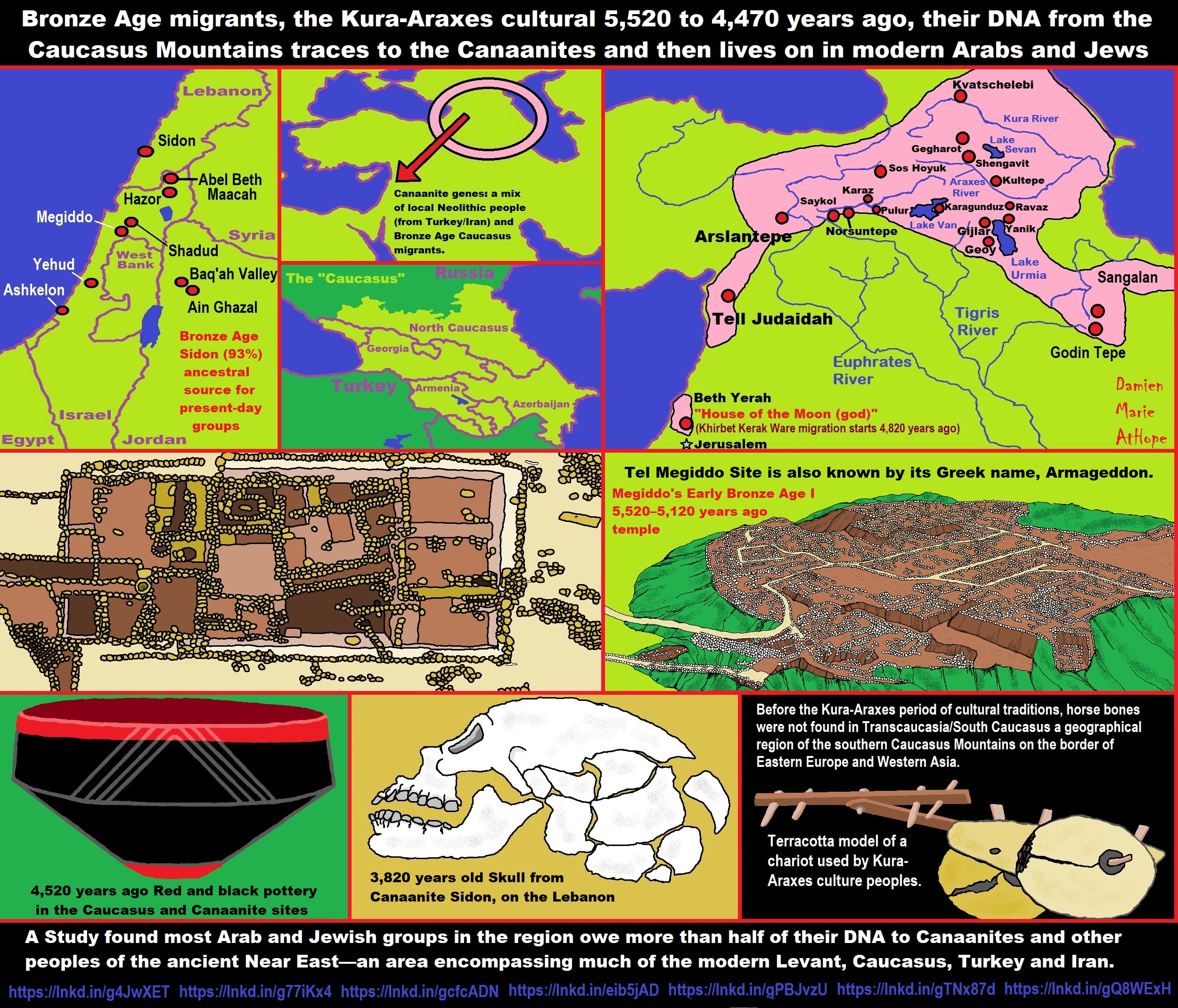
ref, ref, ref, ref, ref, ref, ref, ref, ref, ref, ref, ref
Bronze Age migrants, the Kura-Araxes cultural 5,520 to 4,470 years ago, their DNA from the Caucasus Mountains traces to the Canaanites and then lives on in modern Arabs and Jews. A Study found most Arab and Jewish groups in the region owe more than half of their DNA to Canaanites and other peoples of the ancient Near East—an area encompassing much of the modern Levant, Caucasus, Turkey, and Iran. Before the Kura-Araxes period of cultural traditions, horse bones were not found in Transcaucasia/South Caucasus a geographical region of the southern Caucasus Mountains on the border of Eastern Europe and Western Asia.
“The Kura–Araxes culture, also named Kur–Araz culture, or the Early Transcaucasian culture was a civilization that existed from about 4000 BCE until about 2000 BCE or around 6,020 to 4,020 years ago, which has traditionally been regarded as the date of its end; in some locations, it may have disappeared as early as 2600 or 2700 BCE or around 4,620 to 4,720 years ago. The earliest evidence for this culture is found on the Ararat plain; it spread northward in Caucasus by 3000 BCE or around 5,020 years ago). Altogether, the early Transcaucasian culture enveloped a vast area and mostly encompassed, on modern-day territories, the Southern Caucasus (except western Georgia), northwestern Iran, the northeastern Caucasus, eastern Turkey, and as far as Syria. The name of the culture is derived from the Kura and Araxes river valleys. Kura–Araxes culture is sometimes known as Shengavitian, Karaz (Erzurum), Pulur, and Yanik Tepe (Iranian Azerbaijan, near Lake Urmia) cultures. Furthermore, it gave rise to the later Khirbet Kerak-ware culture found in Syria and Canaan after the fall of the Akkadian Empire. While it is unknown what cultures and languages were present in Kura-Araxes, the two most widespread theories suggest a connection with Hurro-Urartian and/or Anatolian languages.” ref
“The Kura-Araxes cultural tradition existed in the highlands of the South Caucasus from 3500 to 2450 BCE or 5,520 to 4,470 years ago. This tradition represented an adaptive regime and a symbolically encoded common identity spread over a broad area of patchy mountain environments. By 3000 BCE or around 5,020 years ago, groups bearing this identity had migrated southwest across a wide area from the Taurus Mountains down into the southern Levant, southeast along the Zagros Mountains, and north across the Caucasus Mountains. In these new places, they became effectively ethnic groups amid already heterogeneous societies. This paper addresses the place of migrants among local populations as ethnicities and the reasons for their disappearance in the diaspora after 2450 BCE.” ref
“DNA from the Bible’s Canaanites lives on in modern Arabs and Jews: A new study of ancient DNA traces the surprising heritage of these mysterious Bronze Age people. Tel Megiddo was an important Canaanite city-state during the Bronze Age, approximately 3500 to 1200 B.CE or 5,520 to 3,220 years ago. DNA analysis reveals that the city’s population included migrants from the distant Caucasus Mountains. They are best known as the people who lived “in a land flowing with milk and honey” until they were vanquished by the ancient Israelites and disappeared from history. But a scientific report published today reveals that the genetic heritage of the Canaanites survives in many modern-day Jews and Arabs. The study in Cell also shows that migrants from the distant Caucasus Mountains combined with the indigenous population to forge the unique Canaanite culture that dominated the area between Egypt and Mesopotamia during the Bronze Age. The team extracted ancient DNA from the bones of 73 individuals buried over the course of 1,500 years at five Canaanite sites scattered across Israel and Jordan. They also factored in data from an additional 20 individuals from four sites previously reported. “Individuals from all sites are highly genetically similar,” says co-author and molecular evolutionist Liran Carmel of Jerusalem’s Hebrew University.” ref
“So while the Canaanites lived in far-flung city-states, and never coalesced into an empire, they shared genes as well as a common culture. The researchers also compared the ancient DNA with that of modern populations and found that most Arab and Jewish groups in the region owe more than half of their DNA to Canaanites and other peoples who inhabited the ancient Near East—an area encompassing much of the modern Levant, Caucasus, and Iran. The study—a collaborative effort between Carmel’s lab, the ancient DNA lab at Harvard University headed by geneticist David Reich, and other groups—was by far the largest of its type in the region. Its findings are the latest in a series of recent breakthroughs in our understanding of this mysterious people who left behind few written records. Marc Haber, a geneticist at the Wellcome Trust’s Sanger Institute in Hinxton, United Kingdom, co-led a 2017 study of five Canaanite individuals from the coastal town of Sidon. The results showed that modern Lebanese can trace more than 90 percent of their genetic ancestry to Canaanites.” ref
“As Egyptians built pyramids and Mesopotamians constructed ziggurats some 4,500 years ago, the Canaanites began to develop towns and cities between these great powers. They first appear in the historical record around 1800 B.C., when the king of the city-state of Mari in today’s eastern Syria complained about “thieves and Canaanites.” Diplomatic correspondence written five centuries later mentions several Canaanite kings, who often struggled to maintain independence from Egypt. “The land of Canaan is your land and its kings are your servants,” acknowledged one Babylonian monarch in a letter to the Egyptian pharaoh Akhenaten. Biblical texts, written many centuries later, insist that Yahweh promised the land of Canaan to the Israelites after their escape from Egypt. Jewish scripture says the newcomers eventually triumphed, but archaeological evidence doesn’t show widespread destruction of Canaanite populations. Instead, they appear to have been gradually overpowered by later invaders such as the Philistines, Greeks, and Romans.” ref
“Red and black pottery circa 2500 BCE or around 4,520 years old was found in the Caucasus Mountains, as well as at Canaanite sites far to the southwest. The Canaanites spoke a Semitic language and were long thought to derive from earlier populations that settled in the region thousands of years before. But archaeologists have puzzled over red-and-black pottery discovered at Canaanite sites that closely resembles ceramics found in the Caucasus Mountains, some 750 miles to the northwest. Historians also have noted that many Canaanite names derive from Hurrian, a non-Semitic language originating in the Caucasus. Whether this resulted from long-distance trade or migration was uncertain. The new study demonstrates that significant numbers of people, and not just goods, were moving around during humanity’s first era of cities and empires. The genes of Canaanite individuals proved to be a mix of local Neolithic people and the Caucasus migrants, who began showing up in the region around the start of the Bronze Age. Carmel adds that the migration appears to have been more than a one-time event, and “could have involved multiple waves throughout the Bronze Age.” One brother and sister who lived around 1500 B.C. in Megiddo, in what is now northern Israel, were from a family that had migrated relatively recently from the northeast. The team also noted that individuals at two coastal sites—Ashkelon in Israel and Sidon in Lebanon—show slightly more genetic diversity. That may be the result of broader trade links in Mediterranean port towns than inland settlements.” ref
“Glenn Schwartz, an archaeologist at Johns Hopkins University who was not involved in the study, said that the biological data provides important insight into how Canaanites shared a notable number of genes as well as cultural traits. And Haber from the Wellcome Trust noted that the quantity of DNA results is particularly impressive, given the difficulty of extracting samples from old bones buried in such a warm climate that can quickly degrade genetic material. Both Israeli and Palestinian politicians claim the region of Israel and the Palestinian territories is the ancestral home of their people, and maintain that the other group was a late arrival. “We are the Canaanites,” asserted Palestinian Authority President Mahmoud Abbas last year. “This land is for its people…who were here 5,000 years ago.” Israeli Prime Minister Benjamin Netanyahu, meanwhile, said recently that the ancestors of modern Palestinians “came from the Arabian peninsula to the Land of Israel thousands of years” after the Israelites. The new study suggests that despite tumultuous changes in the area since the Bronze Age, “the present-day inhabitants of the region are, to a large extent, descended from its ancient residents,” concludes Schwartz—although Carmel adds that there are hints of later demographic shifts. Carmel hopes to soon expand the findings by collecting DNA from the remains of those who can be identified as Judean, Moabite, Ammonite, and other groups mentioned in the Bible and other texts. “One could analyze ‘Canaanite’ as opposed to ‘Israelite’ individuals,” adds archaeologist Mary Ellen Buck, who wrote a book on the Canaanites. “The Bible claims that these are distinct and mutually antagonistic groups, yet there’s reason to believe that they were very closely related.” ref
“As reported from genome-wide DNA data for 73 individuals from five archaeological sites across the Bronze and Iron Ages Southern Levant. These individuals, who share the “Canaanite” material culture, can be modeled as descending from two sources: (1) earlier local Neolithic populations and (2) populations related to the Chalcolithic Zagros (mountain range in Iran, northern Iraq, and southeastern Turkey) or the Bronze Age Caucasus (mountain range in Armenia, Azerbaijan, Georgia, and parts of Southern Russia). The non-local contribution increased over time, as evinced by three outliers who can be modeled as descendants of recent migrants. We show evidence that different “Canaanite” groups genetically resemble each other more than other populations. We find that Levant-related modern populations typically have substantial ancestry coming from populations related to the Chalcolithic Zagros and the Bronze Age Southern Levant. These groups also harbor ancestry from sources we cannot fully model with the available data, highlighting the critical role of post-Bronze-Age migrations into the region over the past 3,000 years.” ref
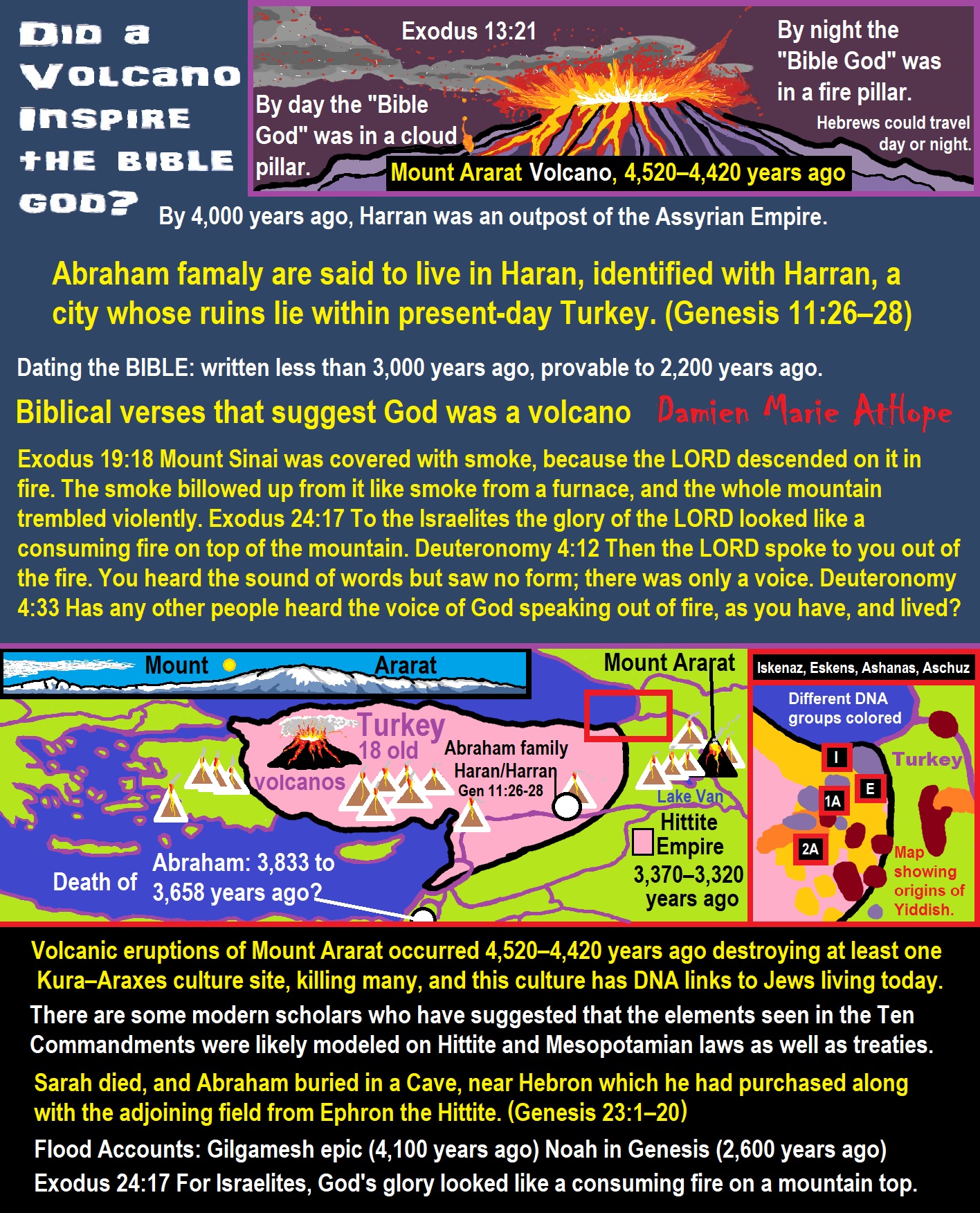
ref, ref, ref, ref, ref, ref, ref, ref, ref, ref, ref, ref, ref
By day the LORD went ahead of them in a pillar of cloud to guide them on their way and by night in a pillar of fire to give them light, so that they could travel by day or night.
- By day the “Bible God” was in a cloud pillar.
- By night the “Bible God” was in a fire pillar.
Volcano deity
“A volcano deity is a deification of a volcano, including:
- Vulcan, in ancient Roman religion and myth, the god of fire including the fire of volcanoes, deserts, metalworking, and the forge.
- Volos, Slavic god of earth, waters, and the underworld.
- Rūaumoko, in Māori mythology, god of earthquakes, volcanoes, and seasons.
- Pele, in the Hawaiian religion, goddess of volcanoes and fire and the creator of the Hawaiian Islands.
- Lalahon, in Philippine mythology, Goddess of fire, volcanoes, and harvest.
- Kan-Laon, Visayan god of time associated with the volcano Kanlaon
- Hephaestus, Greek god of blacksmiths, metalworking, carpenters, craftsmen, artisans, sculptors, metallurgy, fire, and volcanoes.
- Gugurang, in Philippine mythology, Bicolano god of fire and volcanoes who lives inside Mayon Volcano which erupts whenever he’s enraged
- Guayota, Guanche, malignant deity which lived inside the Teide volcano.
- Aganjú, Yoruban deity, Orisha of volcanoes, the wilderness, and rivers.
- Aganju, in Cuba, is a volcano deity for the practitioners of the Lucumi, Santeria religion.” ref
New DNA tech traces origins of Yiddish to… Turkey
“Genetic data shows speakers of Jewish language came from ancient Silk Road crossroads and may have been traders, Israeli researcher says. DNA shows that Yiddish, the historic language of Ashkenazi Jews, may have originated in northeastern Turkey, according to a study by an Israeli-born researcher. The study by the University of Sheffield’s Dr. Eran Elhaik, which was published recently in scientific journal Genome Biology, used a Geographic Population Structure (GPS) tool to locate the origins of Yiddish speakers’ DNA.” ref
“We identified 367 people who claim they have two parents who are Ashkenazic Jews and we divided them into people whose parents only speak Yiddish and then everyone else,” Elhaik told WIRED. The researchers then used the GPS algorithms to analyze participants’ DNA and predict their most likely geographical origin. The results, Elhaik said, showed that many of them came from the vicinity of four ancient villages in northern Turkey whose names are conspicuously similar to “Ashkenaz” — Askenaz, Eskenaz, Ashanaz, and Ashkuz — and which are all located near a crossroads of the ancient Silk Road trade route.” ref
“The researchers have surmised that the language may have been invented by Iranian and Slavic Jews who traded on the Silk Road around the 9th century. “We were able to predict the possible ancestral location where Yiddish originated over 1,000 years ago — a question which linguists have debated over for many years,” Elhaik said. “Northeast Turkey is the only place in the world where these place names exist — which strongly implies that Yiddish was established around the first millennium at a time when Jewish traders who were plying the Silk Road moved goods from Asia to Europe wanted to keep their monopoly on trade.” ref
https://www.youtube.com/watch?v=rpwmqUnj7vc
“They did this by inventing Yiddish — a secret language that very few can speak or understand other than Jews. Our findings are in agreement with an alternative theory that suggests Yiddish has Iranian, Turkish, and Slavic origins and explains why Yiddish contains 251 words for the terms ‘buy’ and ‘sell’. This is what we can expect from a language of experienced merchants.” ref
The study suggests that as Jews spread throughout Europe, their language acquired words from other languages in the continent, mainly German. “Yiddish is such a wonderful and complex language, which was inappropriately called ‘bad German’ by both its native and non-native speakers because the language consists of made-up German words and a non-German grammar,” Elhaik said. “Yiddish is truly a combination of familiar and adapted German words using Slavic grammar.” Elhaik told WIRED he hoped to be able to refine and improve the technology, which can currently analyze data from the last millennium or so. “We’re probably going to do a really good job for 2,000 to 10,000 years ago due to the availability of the DNA from these time periods,” he said.” ref
Scientists reveal Jewish history’s forgotten Turkish roots
Israeli-born geneticist believes the Turkish villages of Iskenaz, Eskenaz, and Ashanaz were part of the original homeland for Ashkenazic Jews
“Research suggests that the majority of the world’s modern Jewish population is descended mainly from people from ancient Turkey, rather than predominantly from elsewhere in the Middle East. The new research suggests that most of the Jewish population of northern and eastern Europe – normally known as Ashkenazic Jews – are the descendants of Greeks, Iranians, and others who colonized what is now northern Turkey more than 2000 years ago and were then converted to Judaism, probably in the first few centuries AD by Jews from Persia. At that stage, the Persian Empire was home to the world’s largest Jewish communities. According to research carried out by the geneticist, Dr Eran Elhaik of the University of Sheffield, over 90 percent of Ashkenazic ancestors come from that converted partially Greek-originating ancient community in north-east Turkey.” ref
“His research is based on genetic, historical, and place-name evidence. For his geographic genetic research, Dr Elhaik used a Geographic Population Structure computer modeling system to convert Ashkenazic Jewish DNA data into geographical information. Dr Elhaik, an Israeli-born geneticist who gained his doctorate in molecular evolution from the University of Houston, believes that three still-surviving Turkish villages – Iskenaz, Eskenaz, and Ashanaz – on the western part of an ancient Silk Road route were part of the original Ashkenazic homeland. He believes that the word Ashkenaz originally comes from Ashguza – the ancient Assyrian and Babylonian name for the Iron Age Eurasian steppe-land people, the Scythians. Referring to the names of the three Turkish villages, Dr Elhaik points out that “north-east Turkey is the only place in the world where these place-names exist”.” ref
“From the 690s AD onwards, anti-Jewish persecution by the Christian Byzantine Empire seems to have played a part in forcing large numbers of Jews to flee across the Black Sea to a more friendly state – the Turkic-ruled Khazar Empire with its large Slav and other populations. Some analyses of Yiddish suggests that it was originally a Slavic language, and Dr Elhaik and others believe that it was developed, probably in the 8th and 9th centuries AD, by Jewish merchants trading along some of the more northerly Silk Roads linking China and Europe. By the 730s, the Khazar Empire had begun to convert to Judaism – and more people converted to the faith.” ref
“But when the Khazar Empire declined in or around the 11th century, some of the Jewish population almost certainly migrated west into Central Europe. There, as Yiddish-speaking Jewish merchants came into contact with central European, often German-speaking, peoples, they began to replace the Slav words in Yiddish with large numbers of German and German-derived words, while retaining some of its Slav-originating grammar. Many Hebrew words also appear to have been added by that stage. The genetic modeling used in the research was based on DNA data from 367 Jews of northern and eastern European origin and more than 600 non-Jewish people mainly from Europe and western Asia. Dr Elhaik says it is the largest genomic study ever carried out on Ashkenazic Jews. His research will be published in the UK-based scientific journal, Genome Biology, and Evolution. Further research is planned to try to measure the precise size of the Semitic genetic input into Jewish and non-Jewish genomes.” ref
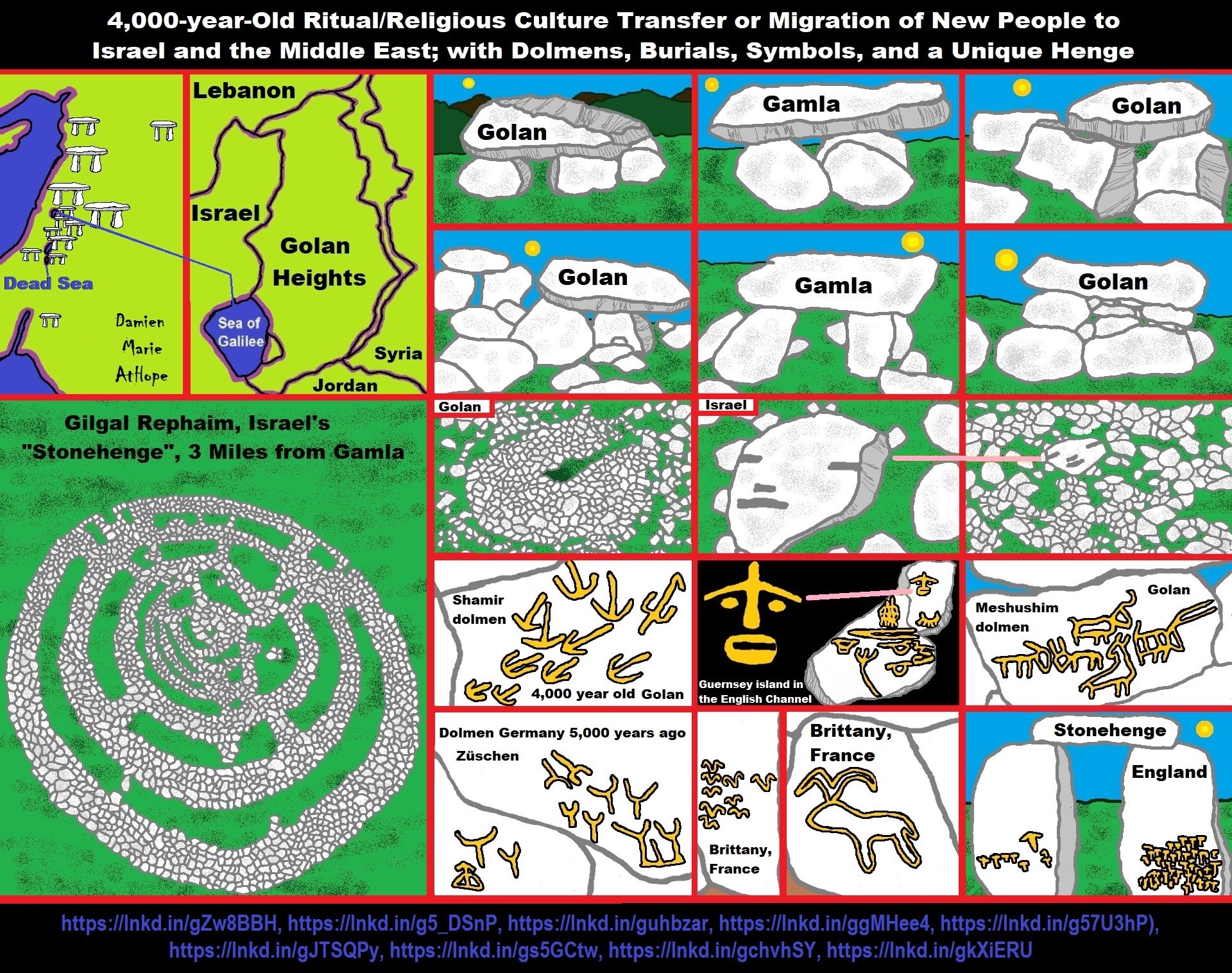
“The presence of dolmens are found in a few areas of Israel, with most dolmens known to the public found in the Golan Heights. Gamla is part of the Golan
There is a gigantic dolmen, with a 50-ton capstone over 4,000 years old with unique artistic carvings in its ceiling has been found in the Golan Heights. What makes this dolmen so unique is its huge dimensions, the structure surrounding it, and most importantly the artistic decorations engraved in its ceiling. ref, ref
“The Galilee dolmens date from roughly the same time as other mysterious, monumental structures discovered nearby in the Golan, most notably the extraordinary circular megalithic monument called Rujm el-Hiri, in the middle of a large plateau also covered with hundreds of dolmen shown above.” ref
“Gilgal Rephaim (Hebrew for “Circle of the Giants”) is a large megalithic monument that is just three miles east of the site of Gamla in the Golan. This area is known as the land of Bashan, where King Og lived and is located east of the Jordan River, and the Sea of Galilee in what would be the land of the tribe Mannaseh. King Og of Bashan, who according to Deuteronomy 3:11, “was the last of the Rephaim (giants), whose bed was decorated with iron and was more than nine cubits long (13 1/2 feet) and four cubits wide (six feet).” The structure has been dated by archaeologists to the Early Bronze Age (3000 – 2700 BCE), thus would have existed prior to the flood of Noah.” ref
“There is over 42,000 tons of boulders, partly worked, and stacked up to 2 meters (nearly 7 feet) high. The outermost circle is 520 feet in diameter. In order to see the entire structure, an aerial view is required. It is possible that the ancient inhabitants of this area practiced excarnation, that is the burial practice of removing the flesh from the bones of the deceased, perhaps leaving the body exposed for scavengers such as vultures. It is interesting that just three miles from this location is the Gamla Nature Reserve, at the site of ancient Gamla, which hosts one of the world’s largest known populations of Griffon vultures, and other birds of prey. Certainly, the later inhabitants of Gamla were very familiar with this site as it is a mere 3 mile walk up the Daliyot Stream. An interesting fact about Gamla is that, although thousands were have said to have died there during the Jewish Revolt in what is called “The Masada of the North”, unlike at Masada, no bodies have ever been found.” ref
The Amorite/Amurru people’s God Amurru “Lord of the Steppe”,
relates to the Origins of the Bible God?
“Amurru and Martu are names given in Akkadian and Sumerian texts to the god of the Amorite/Amurru people, often forming part of personal names. He is sometimes called Ilu Amurru (DMAR.TU). He was the patron god of the Mesopotamian city of Ninab, whose exact location is unknown. He was occasionally called “lord of the steppe” or “lord of the mountain.” ref
“Amurru/Martu was probably a western Semitic god originally. He is sometimes described as a ‘shepherd’ or as a storm god, and as a son of the sky-god Anu. He is sometimes called bêlu šadī or bêl šadê, ‘lord of the mountain’; dúr-hur-sag-gá sikil-a-ke, ‘He who dwells on the pure mountain’; and kur-za-gan ti-[la], ‘who inhabits the shining mountain’. In Cappadocian Zinčirli inscriptions he is called ì-li a-bi-a, ‘the god of my father‘.” ref
“Bêl Šadê could also have become the fertility-god ‘Ba’al‘, possibly adopted by the Canaanites, a rival and enemy of the Hebrew God YHWH, and famously combatted by the Hebrew prophet Elijah.” ref
“Amurru also has storm-god features. Like Adad, Amurru bears the epithet ramān ‘thunderer’, and he is even called bāriqu ‘hurler of the thunderbolt’ and Adad ša a-bu-be ‘Adad of the deluge’. Yet his iconography is distinct from that of Adad, and he sometimes appears alongside Adad with a baton of power or throwstick, while Adad bears a conventional thunderbolt.” ref
“Amurru’s wife is usually the goddess Ašratum (see Asherah) who in northwest Semitic tradition and Hittite tradition appears as wife of the god El which suggests that Amurru may indeed have been a variation of that god. If Amurru was identical with Ēl, it would explain why so few Amorite names are compounded with the name Amurru, but so many are compounded with Il; that is, with El.” ref
“Another tradition about Amurru’s wife (or one of Amurru’s wives) gives her name as Belit-Sheri, ‘Lady of the Desert’. A third tradition appears in a Sumerian poem in pastoral style, which relates how the god Martu came to marry Adg̃ar-kidug the daughter of the god Numushda of the city of Inab. It contains a speech expressing urbanite Sumerian disgust at uncivilized, nomadic Amurru life which Adg̃ar-kidug ignores, responding only: “I will marry Martu!.” ref
“Amorite (Sumerian ???????? MAR.TU, Akkadian Tidnum or Amurrūm, Egyptian Amar, Hebrew ’emōrî אמורי) refers to a Semitic people who occupied large parts of Mesopotamia from at least the second half of the third millennium BC. The term Amurru refers to them, as well as to their principal deity.” ref
“In the earliest Sumerian sources, beginning about 2400 BC, the land of the Amorites (“the Mar.tu land”) is associated with the West, including Syria and Canaan. They appear as nomadic people in the Mesopotamian sources, and they are especially connected with the mountainous region of Jebel Bishri in Syria called as the “mountain of the Amorites”. The ethnic terms Amurru and Amar were used for them in Assyria and Egypt respectively.” ref
“From the 21st century BC and likely triggered by the 22nd century BC drought, a large-scale migration of Amorite tribes infiltrated Mesopotamia, precipitating the downfall of the Neo-Sumerian Third Dynasty of Ur, and acquiring a series of powerful kingdoms, culminating in the triumph under Hammurabi of one of them, that of Babylon.” ref
“Known Amorites (mostly those of Mari) wrote in a dialect of Akkadian found on tablets dating from 1800–1750 BC showing many northwest Semitic forms and constructions. The Amorite language was presumably a northwest Semitic dialect. The main sources for our extremely limited knowledge about the language are proper names, not Akkadian in style, that are preserved in such texts.” ref
“In early inscriptions, all western lands, including Syria and Canaan, were known as “the land of the Amorites”. “The MAR.TU land” appears in the earliest Sumerian texts, such as Enmerkar and the Lord of Aratta, as well as early tablets from Ebla; and for the Akkadian kings Mar.tu was one of the “Four Quarters” surrounding Akkad, along with Subartu, Sumer, and Elam. The Akkadian king Naram-Sin records campaigns against them in northern Syria ca. 2240 BC, and his successor Shar-Kali-Sharri followed suit.” ref
“By the time of the Neo-Sumerian Ur-III empire, immigrating Amorites had become such a force that kings such as Shu-Sin were obliged to construct a 170-mile wall from the Tigris to the Euphrates to hold them off. These Amorites appear as nomadic clans ruled by fierce tribal chiefs, who forced themselves into lands they needed to graze their herds. Some of the Akkadian literature of this era speaks disparagingly of the Amorites, and implies that the neo-Sumerians viewed their nomadic way of life with disgust and contempt, for example:
“The MAR.TU who know no grain…. The MAR.TU who know no house nor town, the boors of the mountains…. The MAR.TU who digs up truffles… who does not bend his knees (to cultivate the land), who eats raw meat, who has no house during his lifetime, who is not buried after death…They have prepared wheat and gú-nunuz (grain) as a confection, but an Amorite will eat it without even recognizing what it contains!” ref
“As the centralized structure of the neo-Sumerian empire of Ur slowly collapsed, the component regions began to reassert their former independence, and places, where Amorites resided, were no exception. Elsewhere, armies of Elam were attacking and weakening the empire, making it vulnerable. Some Amorites aggressively took advantage of the failing empire to seize power for themselves. There was not an Amorite invasion as such, but Amorites did ascend to power in many locations, especially during the reign of the last king of the Ur-III Dynasty, Ibbi-Sin. Leaders with Amorite names assumed power in various places, including Isin, Larsa, and Babylon. The Elamites finally sacked Ur in ca. 2004 BC. Sometime later, the most powerful ruler in Mesopotamia (immediately preceding the rise of Hammurabi of Babylon) was Shamshi-Adad I, another Amorite.” ref
Effects on Mesopotamia
“The rise of the Amorite kingdoms in Mesopotamia brought about deep and lasting repercussions in its political, social, and economic structure. The division into kingdoms replaced the Sumerian city-state. Men, land, and cattle ceased to belong physically to the gods or to the temples and the king. The new monarchs gave, or let out for an indefinite period, numerous parcels of royal or sacerdotal land, freed the inhabitants of several cities from taxes and forced labor, and seem to have encouraged a new society to emerge, a society of big farmers, free citizens, and enterprising merchants which was to last throughout the ages. The priest assumed the service of the gods, and cared for the welfare of his subjects, but the economic life of the country was no longer exclusively (or almost exclusively) in their hands.” ref
“In general terms, Mesopotamian civilization survived the arrival of Amorites, as it had survived the Akkadian domination and the restless period that had preceded the rise of the Third Dynasty of Ur. The religious, ethical, and artistic directions in which Mesopotamia had been developing since earliest times, were not greatly impacted by the Amorites’ hegemony. They continued to worship the Sumerian gods, and the older Sumerian myths and epic tales were piously copied, translated, or adapted, generally with only minor alterations. As for the scarce artistic production of the period, there is little to distinguish it from the preceding Ur-III era.” ref
“The era of the Amorite kingdoms, ca. 2000–1600 BC, is sometimes known as the “Amorite period” in Mesopotamian history. The principal Amorite dynasties arose in Mari, Yamkhad, Qatna, Assur (under Shamshi-Adad I), Isin, Larsa, and Babylon. This era ended with the Hittite sack of Babylon (c. 1595 BC) which brought new ethnic groups—particularly Kassites and Hurrians—to the forefront in Mesopotamia. From the 15th century BC onward, the term Amurru is usually applied to the region extending north of Canaan as far as Kadesh on the Orontes.” ref
Biblical Amorites
“The term Amorites is used in the Bible to refer to certain highland mountaineers who inhabited the land of Canaan, described in Gen. 10:16 as descendants of Canaan, son of Ham. They are described as a powerful people of great stature “like the height of the cedars,” who had occupied the land east and west of the Jordan; their king, Og, being described as the last “of the remnant of the giants” (Deut. 3:11). The terms Amorite and Canaanite seem to be used more or less interchangeably, Canaan being more general, and Amorite a specific component among the Canaanites who inhabited the land.” ref
“The Biblical Amorites seem to have originally occupied the region stretching from the heights west of the Dead Sea (Gen. 14:7) to Hebron (13:8; Deut. 3:8; 4:46-48), embracing “all Gilead and all Bashan” (Deut. 3:10), with the Jordan valley on the east of the river (4:49), the land of the “two kings of the Amorites,” Sihon and Og (Deut. 31:4; Josh. 2:10; 9:10). Both Sihon and Og were independent kings.” ref
“These Amorites seem to have been linked to the Jerusalem region, and the Jebusites may have been a subgroup of them. The southern slopes of the mountains of Judea are called the “mount of the Amorites” (Deut. 1:7, 19, 20). Five kings of the Amorites were first defeated with great slaughter by Joshua (10:10). They were said to have been utterly destroyed at the waters of Merom by Joshua (Josh. 11:8).” ref
“It is mentioned that in the days of Samuel, there was peace between them and the Israelites (1 Sam. 7:14). The Gibeonites were said to be their descendants, being an offshoot of the Amorites that made a covenant with the Hebrews; when Saul would break that vow and kill some of the Gibeonites, God sent a famine to Israel.” ref
Indo-European Amorites
“The view that Amorites were fierce tall nomads led to an idiosyncratic theory among some writers in the 19th Century that they were a tribe of “Germanic” warriors who at one point dominated the Israelites. This was because the evidence fitted then-current models of Indo-European migrations. This theory originated with Felix von Luschan, who later abandoned it.” ref
Amorite Jesus and David
“Houston Stewart Chamberlain, claimed that King David and Jesus were both Aryans of Amorite extraction. This argument was repeated by the Nazi ideologist Alfred Rosenberg.” ref
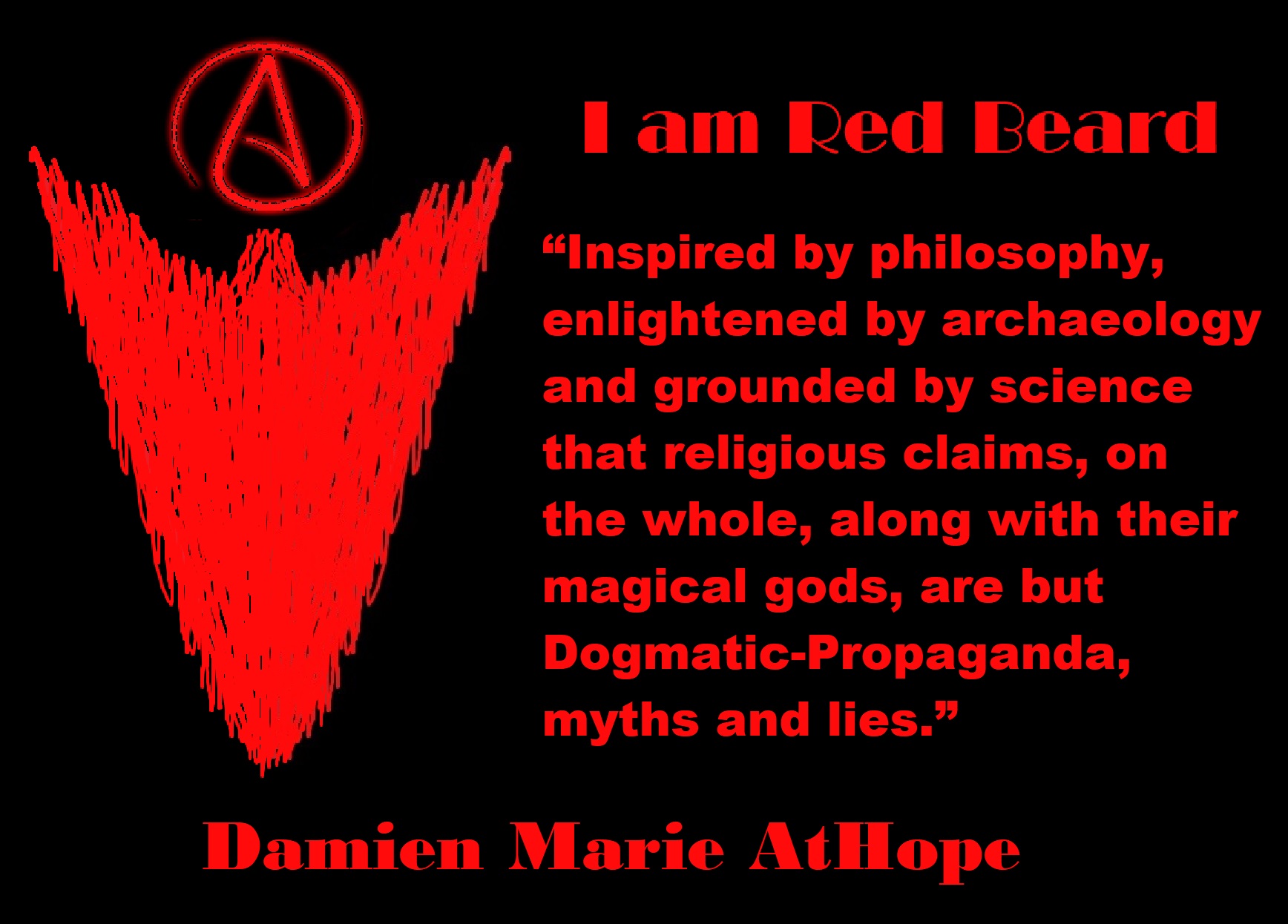
People don’t commonly teach religious history, even that of their own claimed religion. No, rather they teach a limited “pro their religion” history of their religion from a religious perspective favorable to the religion of choice.
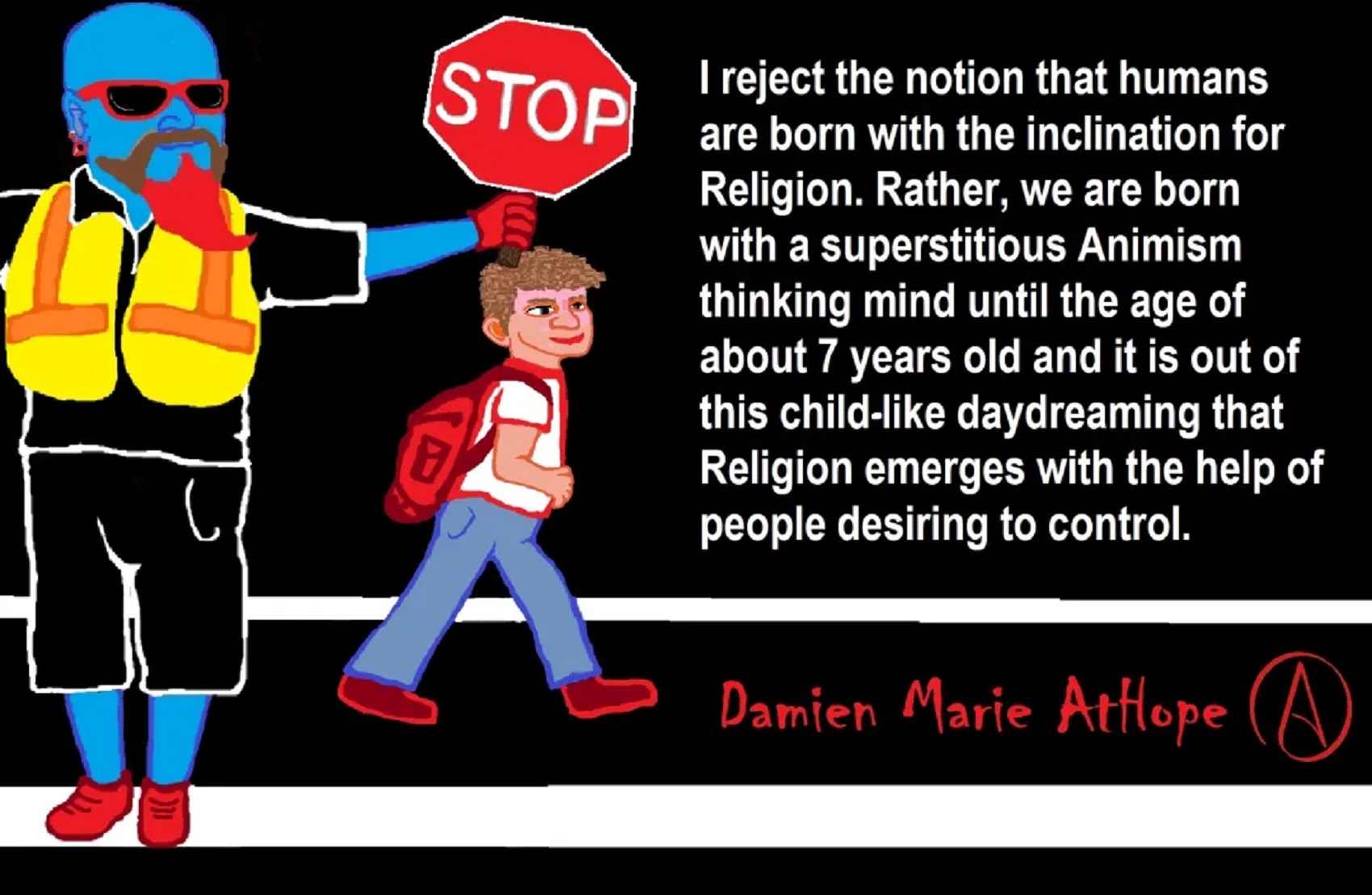
Do you truly think “Religious Belief” is only a matter of some personal choice?
Do you not see how coercive one’s world of choice is limited to the obvious hereditary belief, in most religious choices available to the child of religious parents or caregivers? Religion is more commonly like a family, culture, society, etc. available belief that limits the belief choices of the child and that is when “Religious Belief” is not only a matter of some personal choice and when it becomes hereditary faith, not because of the quality of its alleged facts or proposed truths but because everyone else important to the child believes similarly so they do as well simply mimicking authority beliefs handed to them. Because children are raised in religion rather than being presented all possible choices but rather one limited dogmatic brand of “Religious Belief” where children only have a choice of following the belief as instructed, and then personally claim the faith hereditary belief seen in the confirming to the belief they have held themselves all their lives. This is obvious in statements asked and answered by children claiming a faith they barely understand but they do understand that their family believes “this or that” faith, so they feel obligated to believe it too. While I do agree that “Religious Belief” should only be a matter of some personal choice, it rarely is… End Hereditary Religion!
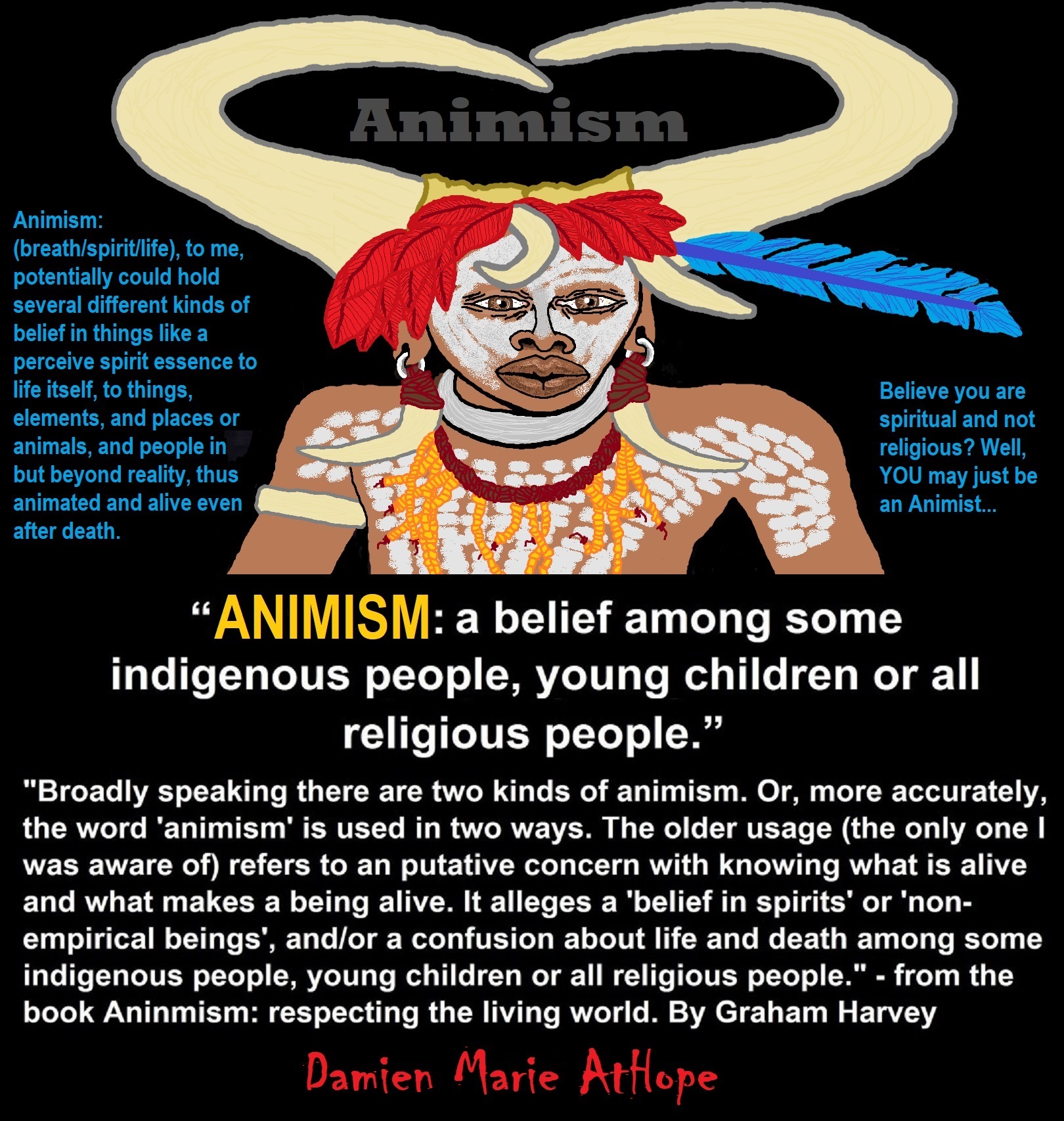
Animism: Respecting the Living World by Graham Harvey
“How have human cultures engaged with and thought about animals, plants, rocks, clouds, and other elements in their natural surroundings? Do animals and other natural objects have a spirit or soul? What is their relationship to humans? In this new study, Graham Harvey explores current and past animistic beliefs and practices of Native Americans, Maori, Aboriginal Australians, and eco-pagans. He considers the varieties of animism found in these cultures as well as their shared desire to live respectfully within larger natural communities. Drawing on his extensive casework, Harvey also considers the linguistic, performative, ecological, and activist implications of these different animisms.” ref
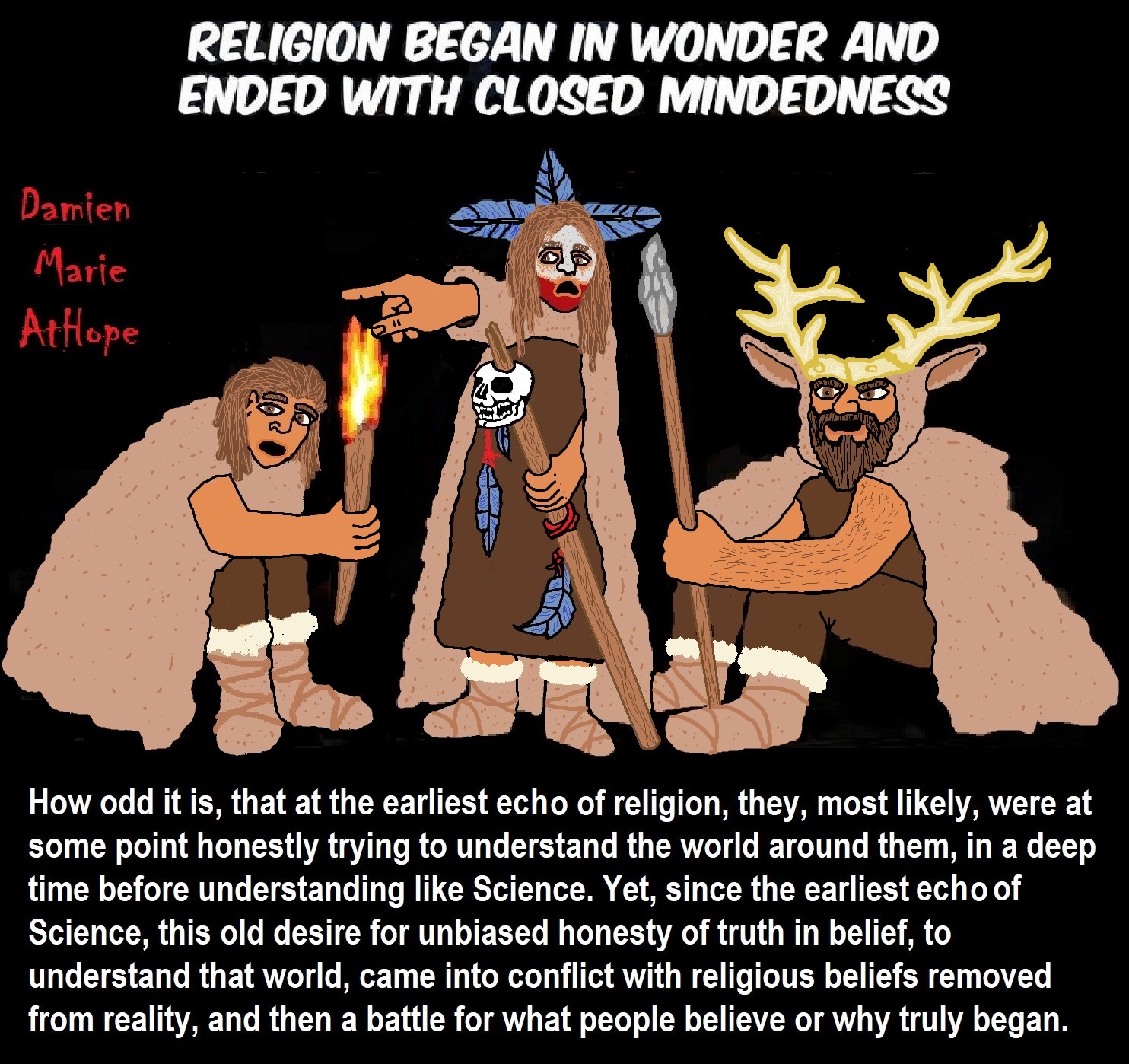
We are like believing machines we vacuum up ideas, like Velcro sticks to almost everything. We accumulate beliefs that we allow to negatively influence our lives, often without realizing it. Our willingness must be to alter skewed beliefs that impend our balance or reason, which allows us to achieve new positive thinking and accurate outcomes.
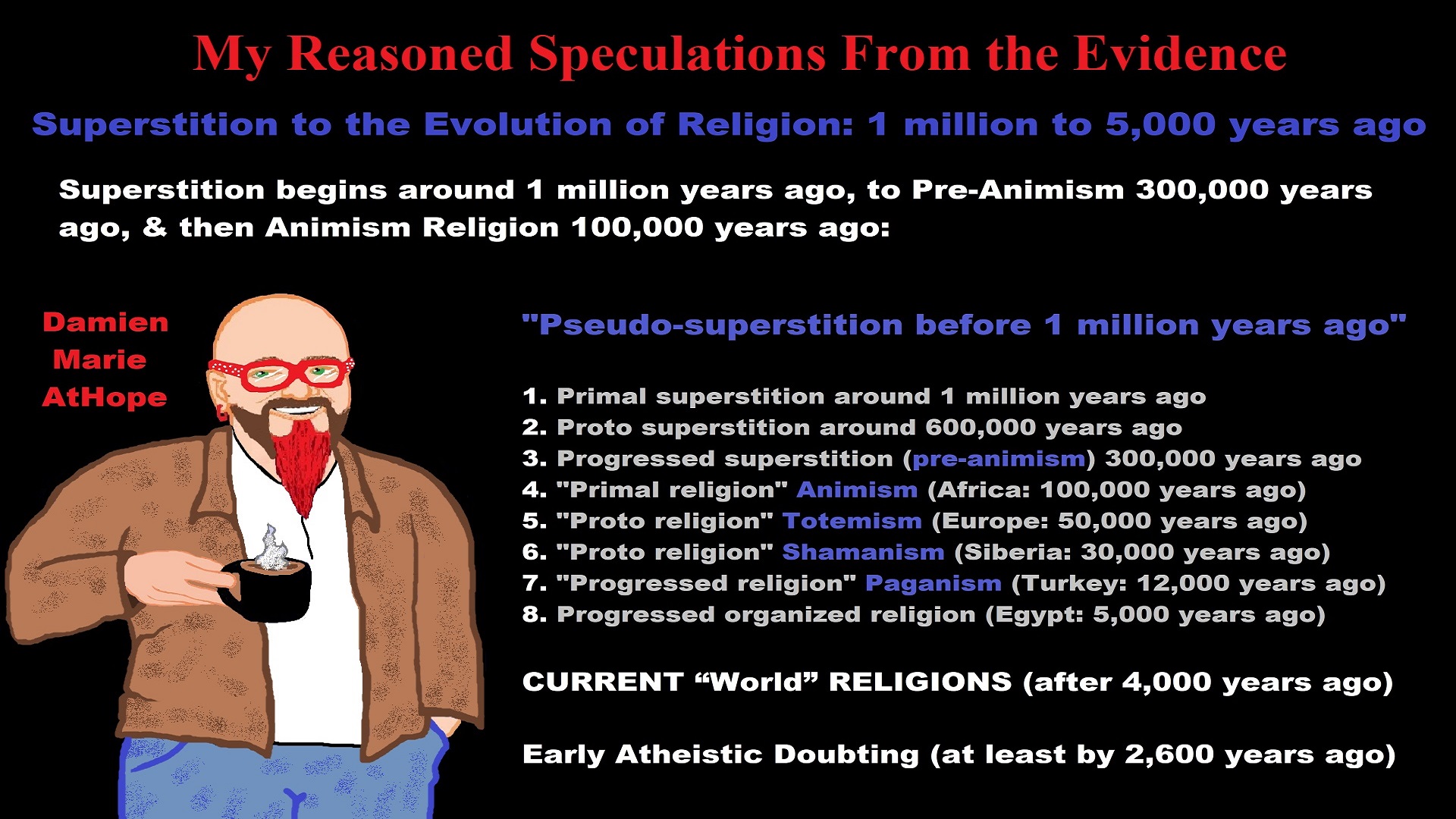
My thoughts on Religion Evolution with external links for more info:
- (Pre-Animism Africa mainly, but also Europe, and Asia at least 300,000 years ago), (Pre-Animism – Oxford Dictionaries)
- (Animism Africa around 100,000 years ago), (Animism – Britannica.com)
- (Totemism Europe around 50,000 years ago), (Totemism – Anthropology)
- (Shamanism Siberia around 30,000 years ago), (Shamanism – Britannica.com)
- (Paganism Turkey around 12,000 years ago), (Paganism – BBC Religion)
- (Progressed Organized Religion “Institutional Religion” Egypt around 5,000 years ago), (Ancient Egyptian Religion – Britannica.com)
- (CURRENT “World” RELIGIONS after 4,000 years ago) (Origin of Major Religions – Sacred Texts)
- (Early Atheistic Doubting at least by 2,600 years ago) (History of Atheism – Wikipedia)
“Religion is an Evolved Product” and Yes, Religion is Like Fear Given Wings…
Atheists talk about gods and religions for the same reason doctors talk about cancer, they are looking for a cure, or a firefighter talks about fires because they burn people and they care to stop them. We atheists too often feel a need to help the victims of mental slavery, held in the bondage that is the false beliefs of gods and the conspiracy theories of reality found in religions.
Understanding Religion Evolution:
- Pre-Animism (at least 300,000 years ago)
- Animism (Africa: 100,000 years ago)
- Totemism (Europe: 50,000 years ago)
- Shamanism (Siberia: 30,000 years ago)
- Paganism (Turkey: 12,000 years ago)
- Progressed organized religion (Egypt: 5,000 years ago), (Egypt, the First Dynasty 5,150 years ago)
- CURRENT “World” RELIGIONS (after 4,000 years ago)
- Early Atheistic Doubting (at least by 2,600 years ago)
“An Archaeological/Anthropological Understanding of Religion Evolution”
It seems ancient peoples had to survived amazing threats in a “dangerous universe (by superstition perceived as good and evil),” and human “immorality or imperfection of the soul” which was thought to affect the still living, leading to ancestor worship. This ancestor worship presumably led to the belief in supernatural beings, and then some of these were turned into the belief in gods. This feeble myth called gods were just a human conceived “made from nothing into something over and over, changing, again and again, taking on more as they evolve, all the while they are thought to be special,” but it is just supernatural animistic spirit-belief perceived as sacred.
Quick Evolution of Religion?
Pre-Animism (at least 300,000 years ago) pre-religion is a beginning that evolves into later Animism. So, Religion as we think of it, to me, all starts in a general way with Animism (Africa: 100,000 years ago) (theoretical belief in supernatural powers/spirits), then this is physically expressed in or with Totemism (Europe: 50,000 years ago) (theoretical belief in mythical relationship with powers/spirits through a totem item), which then enlists a full-time specific person to do this worship and believed interacting Shamanism (Siberia/Russia: 30,000 years ago) (theoretical belief in access and influence with spirits through ritual), and then there is the further employment of myths and gods added to all the above giving you Paganism (Turkey: 12,000 years ago) (often a lot more nature-based than most current top world religions, thus hinting to their close link to more ancient religious thinking it stems from). My hypothesis is expressed with an explanation of the building of a theatrical house (modern religions development). Progressed organized religion (Egypt: 5,000 years ago) with CURRENT “World” RELIGIONS (after 4,000 years ago).
Historically, in large city-state societies (such as Egypt or Iraq) starting around 5,000 years ago culminated to make religion something kind of new, a sociocultural-governmental-religious monarchy, where all or at least many of the people of such large city-state societies seem familiar with and committed to the existence of “religion” as the integrated life identity package of control dynamics with a fixed closed magical doctrine, but this juggernaut integrated religion identity package of Dogmatic-Propaganda certainly did not exist or if developed to an extent it was highly limited in most smaller prehistoric societies as they seem to lack most of the strong control dynamics with a fixed closed magical doctrine (magical beliefs could be at times be added or removed). Many people just want to see developed religious dynamics everywhere even if it is not. Instead, all that is found is largely fragments until the domestication of religion.
Religions, as we think of them today, are a new fad, even if they go back to around 6,000 years in the timeline of human existence, this amounts to almost nothing when seen in the long slow evolution of religion at least around 70,000 years ago with one of the oldest ritual worship. Stone Snake of South Africa: “first human worship” 70,000 years ago. This message of how religion and gods among them are clearly a man-made thing that was developed slowly as it was invented and then implemented peace by peace discrediting them all. Which seems to be a simple point some are just not grasping how devastating to any claims of truth when we can see the lie clearly in the archeological sites.
I wish people fought as hard for the actual values as they fight for the group/clan names political or otherwise they think support values. Every amount spent on war is theft to children in need of food or the homeless kept from shelter.
Here are several of my blog posts on history:
- To Find Truth You Must First Look
- (Magdalenian/Iberomaurusian) Connections to the First Paganists of the early Neolithic Near East Dating from around 17,000 to 12,000 Years Ago
- Natufians: an Ancient People at the Origins of Agriculture and Sedentary Life
- Possible Clan Leader/Special “MALE” Ancestor Totem Poles At Least 13,500 years ago?
- Jewish People with DNA at least 13,200 years old, Judaism, and the Origins of Some of its Ideas
- Baltic Reindeer Hunters: Swiderian, Lyngby, Ahrensburgian, and Krasnosillya cultures 12,020 to 11,020 years ago are evidence of powerful migratory waves during the last 13,000 years and a genetic link to Saami and the Finno-Ugric peoples.
- The Rise of Inequality: patriarchy and state hierarchy inequality
- Fertile Crescent 12,500 – 9,500 Years Ago: fertility and death cult belief system?
- 12,400 – 11,700 Years Ago – Kortik Tepe (Turkey) Pre/early-Agriculture Cultic Ritualism
- Ritualistic Bird Symbolism at Gobekli Tepe and its “Ancestor Cult”
- Male-Homosexual (female-like) / Trans-woman (female) Seated Figurine from Gobekli Tepe
- Could a 12,000-year-old Bull Geoglyph at Göbekli Tepe relate to older Bull and Female Art 25,000 years ago and Later Goddess and the Bull cults like Catal Huyuk?
- Sedentism and the Creation of goddesses around 12,000 years ago as well as male gods after 7,000 years ago.
- Alcohol, where Agriculture and Religion Become one? Such as Gobekli Tepe’s Ritualistic use of Grain as Food and Ritual Drink
- Neolithic Ritual Sites with T-Pillars and other Cultic Pillars
- Paganism: Goddesses around 12,000 years ago then Male Gods after 7,000 years ago
- First Patriarchy: Split of Women’s Status around 12,000 years ago & First Hierarchy: fall of Women’s Status around 5,000 years ago.
- Natufians: an Ancient People at the Origins of Agriculture and Sedentary Life
- J DNA and the Spread of Agricultural Religion (paganism)
- Paganism: an approximately 12,000-year-old belief system
- Paganism 12,000 years old: related to “Anarchism and Socialism” (Pre-Capitalism)
- Shaman burial in Israel 12,000 years ago and the Shamanism Phenomena
- Need to Mythicized: gods and goddesses
- 12,000 – 7,000 Years Ago – Paleo-Indian Culture (The Americas)
- 12,000 – 2,000 Years Ago – Indigenous-Scandinavians (Nordic)
- Norse did not wear helmets with horns?
- Pre-Pottery Neolithic Skull Cult around 11,500 to 8,400 Years Ago?
- 10,400 – 10,100 Years Ago, in Turkey the Nevail Cori Religious Settlement
- 9,000-6,500 Years Old Submerged Pre-Pottery/Pottery Neolithic Ritual Settlements off Israel’s Coast
- Catal Huyuk “first religious designed city” around 9,500 to 7,700 years ago (Turkey)
- Cultic Hunting at Catal Huyuk “first religious designed city”
- Special Items and Art as well as Special Elite Burials at Catal Huyuk
- New Rituals and Violence with the appearance of Pottery and People?
- Haplogroup N and its related Uralic Languages and Cultures
- Ainu people, Sámi people, Native Americans, the Ancient North Eurasians, and Paganistic-Shamanism with Totemism
- Ideas, Technology and People from Turkey, Europe, to China and Back again 9,000 to 5,000 years ago?
- First Pottery of Europe and the Related Cultures
- 9,000 years old Neolithic Artifacts Judean Desert and Hills Israel
- 9,000-7,000 years-old Sex and Death Rituals: Cult Sites in Israel, Jordan, and the Sinai
- 9,000-8500 year old Horned Female shaman Bad Dürrenberg Germany
- Neolithic Jewelry and the Spread of Farming in Europe Emerging out of West Turkey
- 8,600-year-old Tortoise Shells in Neolithic graves in central China have Early Writing and Shamanism
- Swing of the Mace: the rise of Elite, Forced Authority, and Inequality begin to Emerge 8,500 years ago?
- Migrations and Changing Europeans Beginning around 8,000 Years Ago
- My “Steppe-Anatolian-Kurgan hypothesis” 8,000/7,000 years ago
- Around 8,000-year-old Shared Idea of the Mistress of Animals, “Ritual” Motif
- Pre-Columbian Red-Paint (red ochre) Maritime Archaic Culture 8,000-3,000 years ago
- 7,522-6,522 years ago Linear Pottery culture which I think relates to Arcane Capitalism’s origins
- Arcane Capitalism: Primitive socialism, Primitive capital, Private ownership, Means of production, Market capitalism, Class discrimination, and Petite bourgeoisie (smaller capitalists)
- 7,500-4,750 years old Ritualistic Cucuteni-Trypillian culture of Moldova, Romania, and Ukraine
- Roots of a changing early society 7,200-6,700 years ago Jordan and Israel
- Agriculture religion (Paganism) with farming reached Britain between about 7,000 to 6,500 or so years ago and seemingly expressed in things like Western Europe’s Long Barrows
- My Thoughts on Possible Migrations of “R” DNA and Proto-Indo-European?
- “Millet” Spreading from China 7,022 years ago to Europe and related Language may have Spread with it leading to Proto-Indo-European
- Proto-Indo-European (PIE), ancestor of Indo-European languages: DNA, Society, Language, and Mythology
- The Dnieper–Donets culture and Asian varieties of Millet from China to the Black Sea region of Europe by 7,022 years ago
- Kurgan 6,000 years ago/dolmens 7,000 years ago: funeral, ritual, and other?
- 7,020 to 6,020-year-old Proto-Indo-European Homeland of Urheimat or proposed home of their Language and Religion
- Ancient Megaliths: Kurgan, Ziggurat, Pyramid, Menhir, Trilithon, Dolman, Kromlech, and Kromlech of Trilithons
- The Mytheme of Ancient North Eurasian Sacred-Dog belief and similar motifs are found in Indo-European, Native American, and Siberian comparative mythology
- Elite Power Accumulation: Ancient Trade, Tokens, Writing, Wealth, Merchants, and Priest-Kings
- Sacred Mounds, Mountains, Kurgans, and Pyramids may hold deep connections?
- Between 7,000-5,000 Years ago, rise of unequal hierarchy elite, leading to a “birth of the State” or worship of power, strong new sexism, oppression of non-elites, and the fall of Women’s equal status
- Paganism 7,000-5,000 years old: related to “Anarchism and Socialism” (Capitalism) (World War 0) Elite & their slaves
- Hell and Underworld mythologies starting maybe as far back as 7,000 to 5,000 years ago with the Proto-Indo-Europeans?
- The First Expression of the Male God around 7,000 years ago?
- White (light complexion skin) Bigotry and Sexism started 7,000 years ago?
- Around 7,000-year-old Shared Idea of the Divine Bird (Tutelary and/or Trickster spirit/deity), “Ritual” Motif
- Nekhbet an Ancient Egyptian Vulture Goddess and Tutelary Deity
- 6,720 to 4,920 years old Ritualistic Hongshan Culture of Inner Mongolia with 5,000-year-old Pyramid Mounds and Temples
- First proto-king in the Balkans, Varna culture around 6,500 years ago?
- 6,500–5,800 years ago in Israel Late Chalcolithic (Copper Age) Period in the Southern Levant Seems to Express Northern Levant Migrations, Cultural and Religious Transfer
- KING OF BEASTS: Master of Animals “Ritual” Motif, around 6,000 years old or older…
- Around 6000-year-old Shared Idea of the Solid Wheel & the Spoked Wheel-Shaped Ritual Motif
- “The Ghassulian Star,” a mysterious 6,000-year-old mural from Jordan; a Proto-Star of Ishtar, Star of Inanna or Star of Venus?
- Religious/Ritual Ideas, including goddesses and gods as well as ritual mounds or pyramids from Northeastern Asia at least 6,000 years old, seemingly filtering to Iran, Iraq, the Mediterranean, Europe, Egypt, and the Americas?
- Maykop (5,720–5,020 years ago) Caucasus region Bronze Age culture-related to Copper Age farmers from the south, influenced by the Ubaid period and Leyla-Tepe culture, as well as influencing the Kura-Araxes culture
- 5-600-year-old Tomb, Mummy, and First Bearded Male Figurine in a Grave
- Kura-Araxes Cultural 5,520 to 4,470 years old DNA traces to the Canaanites, Arabs, and Jews
- Minoan/Cretan (Keftiu) Civilization and Religion around 5,520 to 3,120 years ago
- Evolution Of Science at least by 5,500 years ago
- 5,500 Years old birth of the State, the rise of Hierarchy, and the fall of Women’s status
- “Jiroft culture” 5,100 – 4,200 years ago and the History of Iran
- Stonehenge: Paganistic Burial and Astrological Ritual Complex, England (5,100-3,600 years ago)
- Around 5,000-year-old Shared Idea of the “Tree of Life” Ritual Motif
- Complex rituals for elite, seen from China to Egypt, at least by 5,000 years ago
- Around 5,000 years ago: “Birth of the State” where Religion gets Military Power and Influence
- The Center of the World “Axis Mundi” and/or “Sacred Mountains” Mythology Could Relate to the Altai Mountains, Heart of the Steppe
- Progressed organized religion starts, an approximately 5,000-year-old belief system
- China’s Civilization between 5,000-3,000 years ago, was a time of war and class struggle, violent transition from free clans to a Slave or Elite society
- Origin of Logics is Naturalistic Observation at least by around 5,000 years ago.
- Paganism 5,000 years old: progressed organized religion and the state: related to “Anarchism and Socialism” (Kings and the Rise of the State)
- Ziggurats (multi-platform temples: 4,900 years old) to Pyramids (multi-platform tombs: 4,700 years old)
- Did a 4,520–4,420-year-old Volcano In Turkey Inspire the Bible God?
- Finland’s Horned Shaman and Pre-Horned-God at least 4,500 years ago?
- 4,000-year-Old Dolmens in Israel: A Connected Dolmen Religious Phenomenon?
- Creation myths: From chaos, Ex nihilo, Earth-diver, Emergence, World egg, and World parent
- Bronze Age “Ritual” connections of the Bell Beaker culture with the Corded Ware/Single Grave culture, which were related to the Yamnaya culture and Proto-Indo-European Languages/Religions
- Low Gods (Earth/ Tutelary deity), High Gods (Sky/Supreme deity), and Moralistic Gods (Deity enforcement/divine order)
- The exchange of people, ideas, and material-culture including, to me, the new god (Sky Father) and goddess (Earth Mother) religion between the Cucuteni-Trypillians and others which is then spread far and wide
- Koryaks: Indigenous People of the Russian Far East and Big Raven myths also found in Tlingit, Haida, Tsimshian, and other Indigenous People of North America
- 42 Principles Of Maat (Egyptian Goddess of the justice) around 4,400 years ago, 2000 Years Before Ten Commandments
- “Happy Easter” Well Happy Eostre/Ishter
- 4,320-3,820 years old “Shimao” (North China) site with Totemistic-Shamanistic Paganism and a Stepped Pyramid
- 4,250 to 3,400 Year old Stonehenge from Russia: Arkaim?
- 4,100-year-old beaker with medicinal & flowering plants in a grave of a woman in Scotland
- Early European Farmer ancestry, Kelif el Boroud people with the Cardial Ware culture, and the Bell Beaker culture Paganists too, spread into North Africa, then to the Canary Islands off West Africa
- Flood Accounts: Gilgamesh epic (4,100 years ago) Noah in Genesis (2,600 years ago)
- Paganism 4,000 years old: related to “Anarchism and Socialism” (First Moralistic gods, then the Origin time of Monotheism)
- When was the beginning: TIMELINE OF CURRENT RELIGIONS, which start around 4,000 years ago.
- Early Religions Thought to Express Proto-Monotheistic Systems around 4,000 years ago
- Kultepe? An archaeological site with a 4,000 years old women’s rights document.
- Single God Religions (Monotheism) = “Man-o-theism” started around 4,000 years ago with the Great Sky Spirit/God Tiān (天)?
- Confucianism’s Tiān (Shangdi god 4,000 years old): Supernaturalism, Pantheism or Theism?
- Yes, Your Male God is Ridiculous
- Mythology, a Lunar Deity is a Goddess or God of the Moon
- Sacred Land, Hills, and Mountains: Sami Mythology (Paganistic Shamanism)
- Horse Worship/Sacrifice: mythical union of Ruling Elite/Kingship and the Horse
- The Amorite/Amurru people’s God Amurru “Lord of the Steppe”, relates to the Origins of the Bible God?
- Bronze Age Exotic Trade Routes Spread Quite Far as well as Spread Religious Ideas with Them
- Sami and the Northern Indigenous Peoples Landscape, Language, and its Connection to Religion
- Prototype of Ancient Analemmatic Sundials around 3,900-3,150 years ago and a Possible Solar Connection to gods?
- Judaism is around 3,450 or 3,250 years old. (“Paleo-Hebrew” 3,000 years ago and Torah 2,500 years ago)
- The Weakening of Ancient Trade and the Strengthening of Religions around 3000 years ago?
- Are you aware that there are religions that worship women gods, explain now religion tears women down?
- Animistic, Totemistic, and Paganistic Superstition Origins of bible god and the bible’s Religion.
- Myths and Folklore: “Trickster gods and goddesses”
- Jews, Judaism, and the Origins of Some of its Ideas
- An Old Branch of Religion Still Giving Fruit: Sacred Trees
- Dating the BIBLE: naming names and telling times (written less than 3,000 years ago, provable to 2,200 years ago)
- Did a Volcano Inspire the bible god?
- Dené–Yeniseian language, Old Copper Complex, and Pre-Columbian Mound Builders?
- No “dinosaurs and humans didn’t exist together just because some think they are in the bible itself”
- Sacred Shit and Sacred Animals?
- Everyone Killed in the Bible Flood? “Nephilim” (giants)?
- Hey, Damien dude, I have a question for you regarding “the bible” Exodus.
- Archaeology Disproves the Bible
- Bible Battle, Just More, Bible Babble
- The Jericho Conquest lie?
- Canaanites and Israelites?
- Accurate Account on how did Christianity Began?
- Let’s talk about Christianity.
- So the 10 commandments isn’t anything to go by either right?
- Misinformed christian
- Debunking Jesus?
- Paulism vs Jesus
- Ok, you seem confused so let’s talk about Buddhism.
- Unacknowledged Buddhism: Gods, Savior, Demons, Rebirth, Heavens, Hells, and Terrorism
- His Foolishness The Dalai Lama
- Yin and Yang is sexist with an ORIGIN around 2,300 years ago?
- I Believe Archaeology, not Myths & Why Not, as the Religious Myths Already Violate Reason!
- Archaeological, Scientific, & Philosophic evidence shows the god myth is man-made nonsense.
- Aquatic Ape Theory/Hypothesis? As Always, Just Pseudoscience.
- Ancient Aliens Conspiracy Theorists are Pseudohistorians
- The Pseudohistoric and Pseudoscientific claims about “Bakoni Ruins” of South Africa
- Why do people think Religion is much more than supernaturalism and superstitionism?
- Religion is an Evolved Product
- Was the Value of Ancient Women Different?
- 1000 to 1100 CE, human sacrifice Cahokia Mounds a pre-Columbian Native American site
- Feminist atheists as far back as the 1800s?
- Promoting Religion as Real is Mentally Harmful to a Flourishing Humanity
- Screw All Religions and Their Toxic lies, they are all fraud
- Forget Religions’ Unfounded Myths, I Have Substantiated “Archaeology Facts.”
- Religion Dispersal throughout the World
- I Hate Religion Just as I Hate all Pseudoscience
- Exposing Scientology, Eckankar, Wicca and Other Nonsense?
- Main deity or religious belief systems
- Quit Trying to Invent Your God From the Scraps of Science.
- Archaeological, Scientific, & Philosophic evidence shows the god myth is man-made nonsense.
- Ancient Alien Conspiracy Theorists: Misunderstanding, Rhetoric, Misinformation, Fabrications, and Lies
- Misinformation, Distortion, and Pseudoscience in Talking with a Christian Creationist
- Judging the Lack of Goodness in Gods, Even the Norse God Odin
- Challenging the Belief in God-like Aliens and Gods in General
- A Challenge to Christian use of Torture Devices?
- Yes, Hinduism is a Religion
- Trump is One of the Most Reactionary Forces of Far-right Christian Extremism
- Was the Bull Head a Symbol of God? Yes!
- Primate Death Rituals
- Christian – “God and Christianity are objectively true”
- Australopithecus afarensis Death Ritual?
- You Claim Global Warming is a Hoax?
- Doubter of Science and Defamer of Atheists?
- I think that sounds like the Bible?
- History of the Antifa (“anti-fascist”) Movements
- Indianapolis Anti-Blasphemy Laws #Free Soheil Rally
- Damien, you repeat the golden rule in so many forms then you say religion is dogmatic?
- Science is a Trustable Methodology whereas Faith is not Trustable at all!
- Was I ever a believer, before I was an atheist?
- Atheists rise in reason
- Mistrust of science?
- Open to Talking About the Definition of ‘God’? But first, we address Faith.
- ‘United Monarchy’ full of splendor and power – Saul, David, and Solomon? Most likely not.
- Is there EXODUS ARCHAEOLOGY? The short answer is “no.”
- Lacking Proof of Bigfoots, Unicorns, and Gods is Just a Lack of Research?
- Religion and Politics: Faith Beliefs vs. Rational Thinking
- Hammer of Truth that lying pig RELIGION: challenged by an archaeologist
- “The Hammer of Truth” -ontology question- What do You Mean by That?
- Navigation of a bad argument: Ad Hominem vs. Attack
- Why is it Often Claimed that Gods have a Gender?
- Why are basically all monotheistic religions ones that have a male god?
- Shifting through the Claims in support of Faith
- Dear Mr. AtHope, The 20th Century is an Indictment of Secularism and a Failed Atheist Century
- An Understanding of the Worldwide Statistics and Dynamics of Terrorist Incidents and Suicide Attacks
- Intoxication and Evolution? Addressing and Assessing the “Stoned Ape” or “Drunken Monkey” Theories as Catalysts in Human Evolution
- Sacred Menstrual cloth? Inanna’s knot, Isis knot, and maybe Ma’at’s feather?
- Damien, why don’t the Hebrews accept the bible stories?
- Dealing with a Troll and Arguing Over Word Meaning
- Knowledge without Belief? Justified beliefs or disbeliefs worthy of Knowledge?
- Afrocentrism and African Religions
- Crecganford @crecganford offers history & stories of the people, places, gods, & culture
- Empiricism-Denier?
I am not an academic. I am a revolutionary that teaches in public, in places like social media, and in the streets. I am not a leader by some title given but from my commanding leadership style of simply to start teaching everywhere to everyone, all manner of positive education.
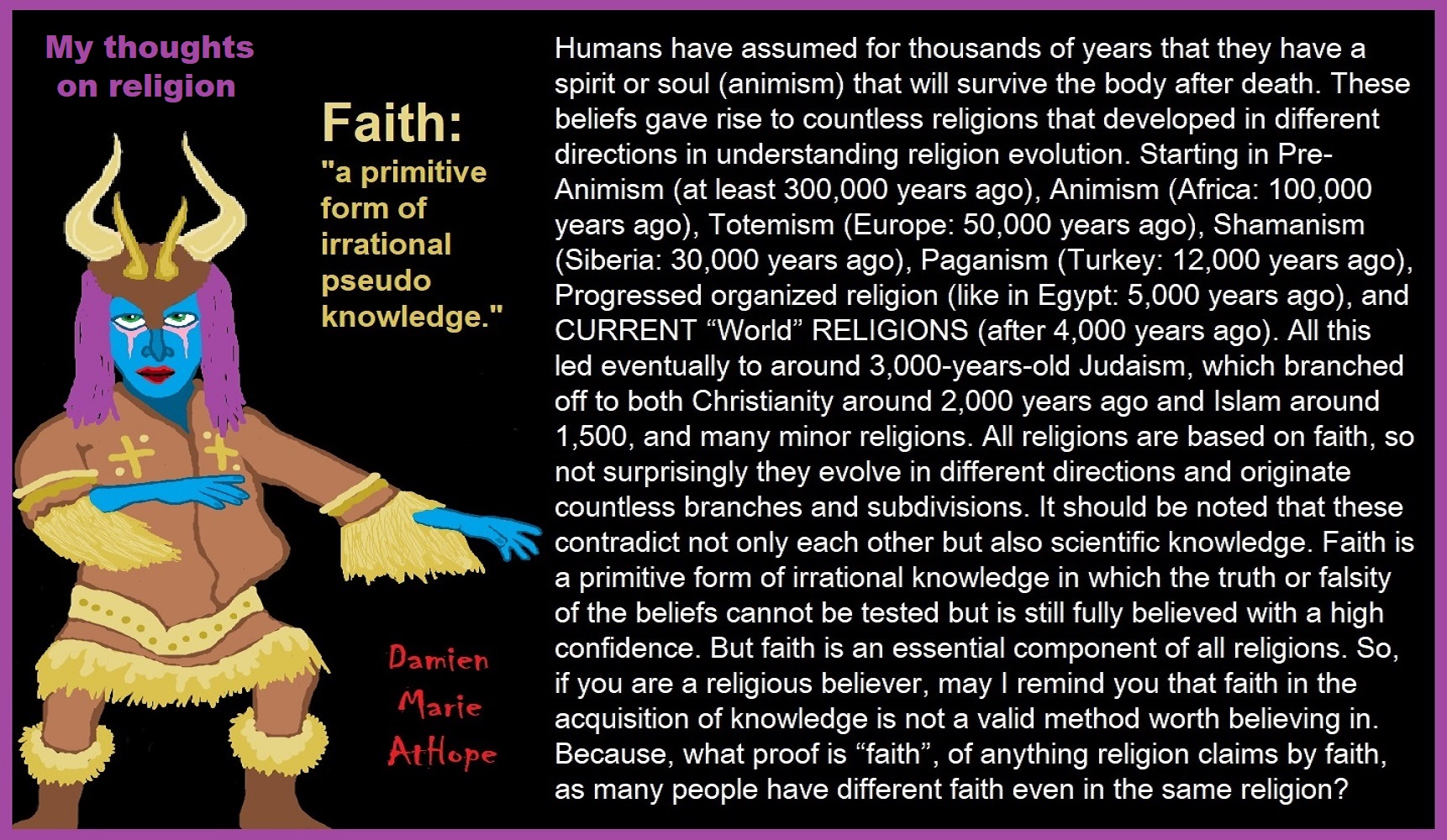
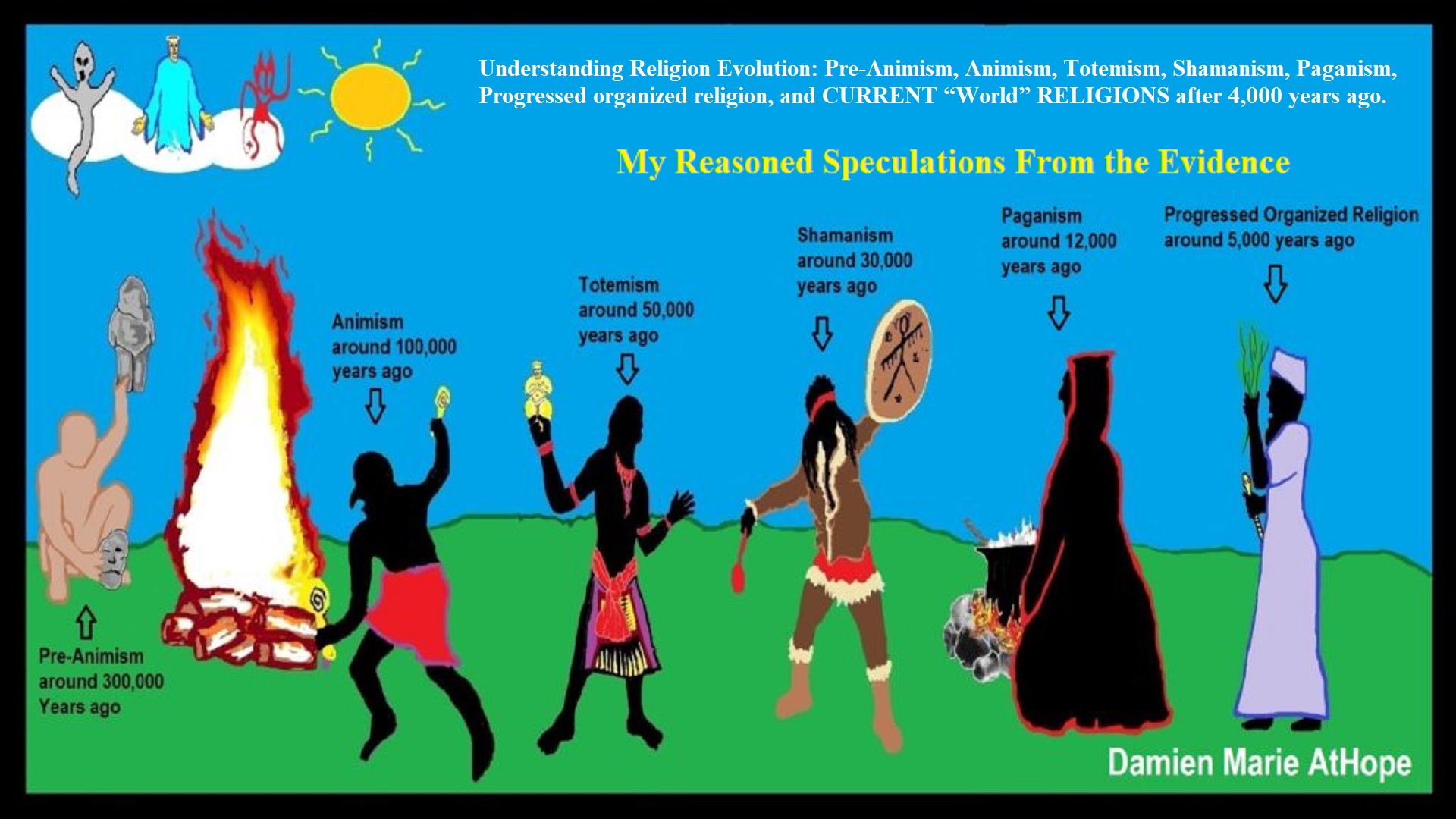
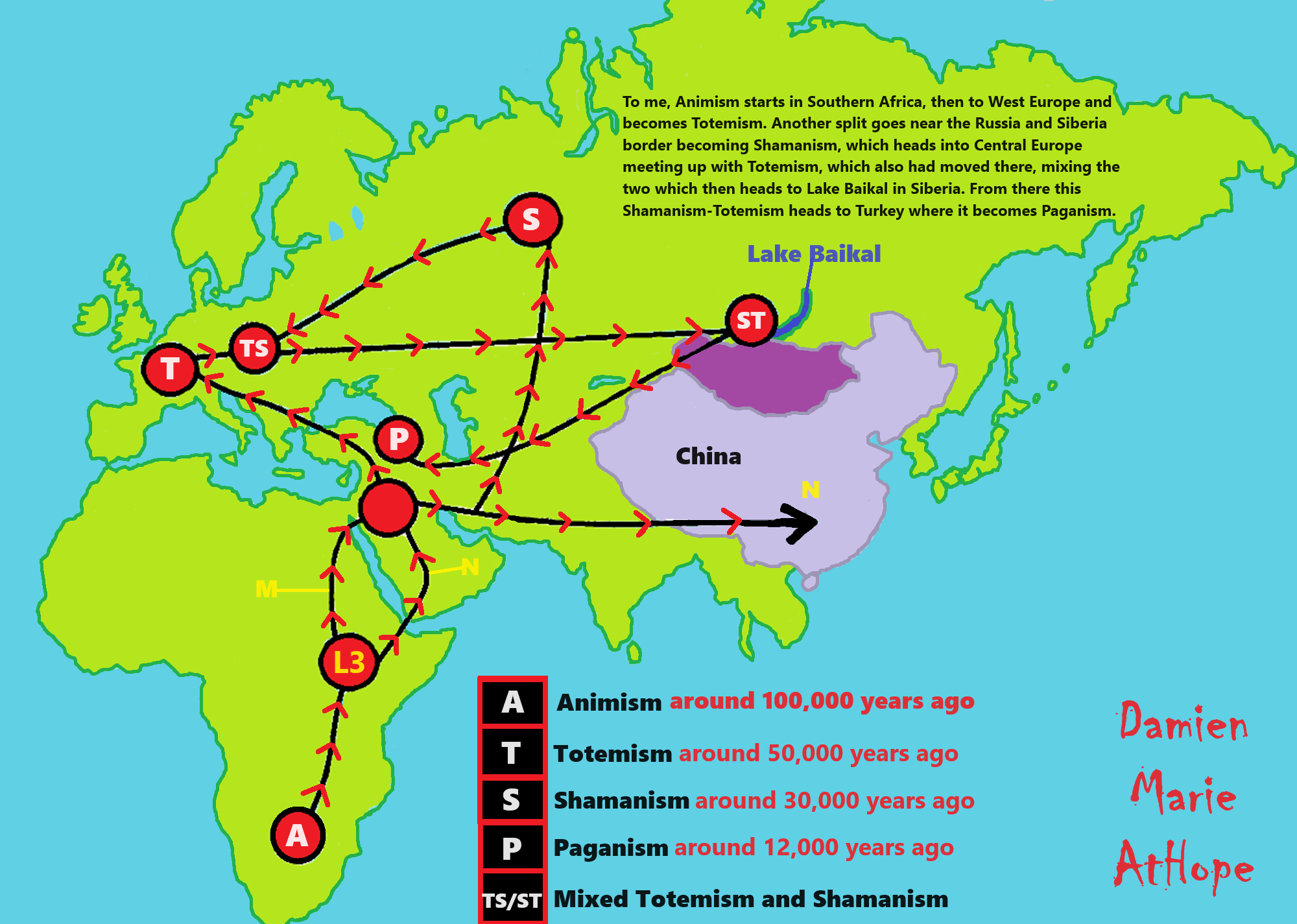
To me, Animism starts in Southern Africa, then to West Europe, and becomes Totemism. Another split goes near the Russia and Siberia border becoming Shamanism, which heads into Central Europe meeting up with Totemism, which also had moved there, mixing the two which then heads to Lake Baikal in Siberia. From there this Shamanism-Totemism heads to Turkey where it becomes Paganism.
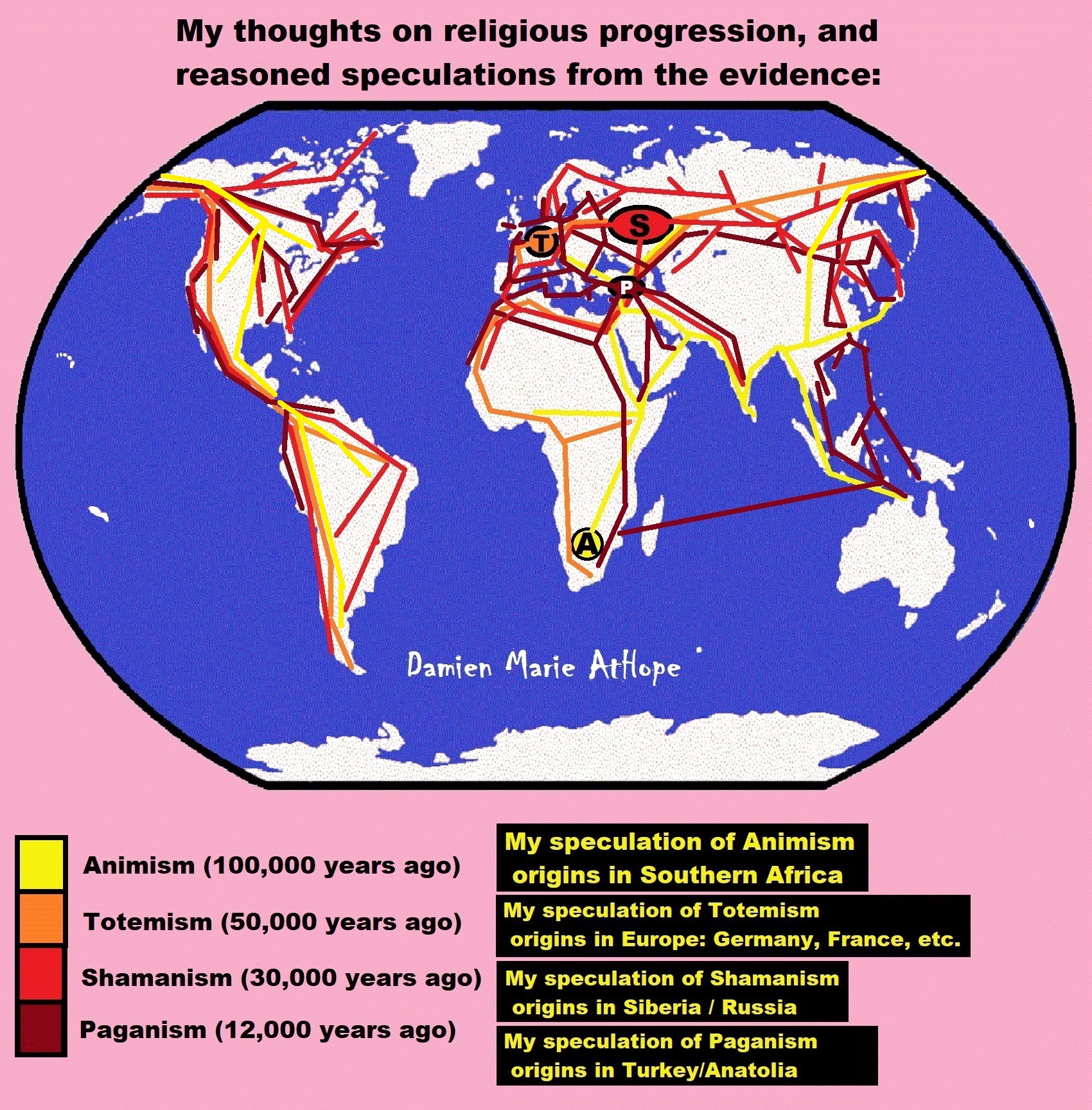
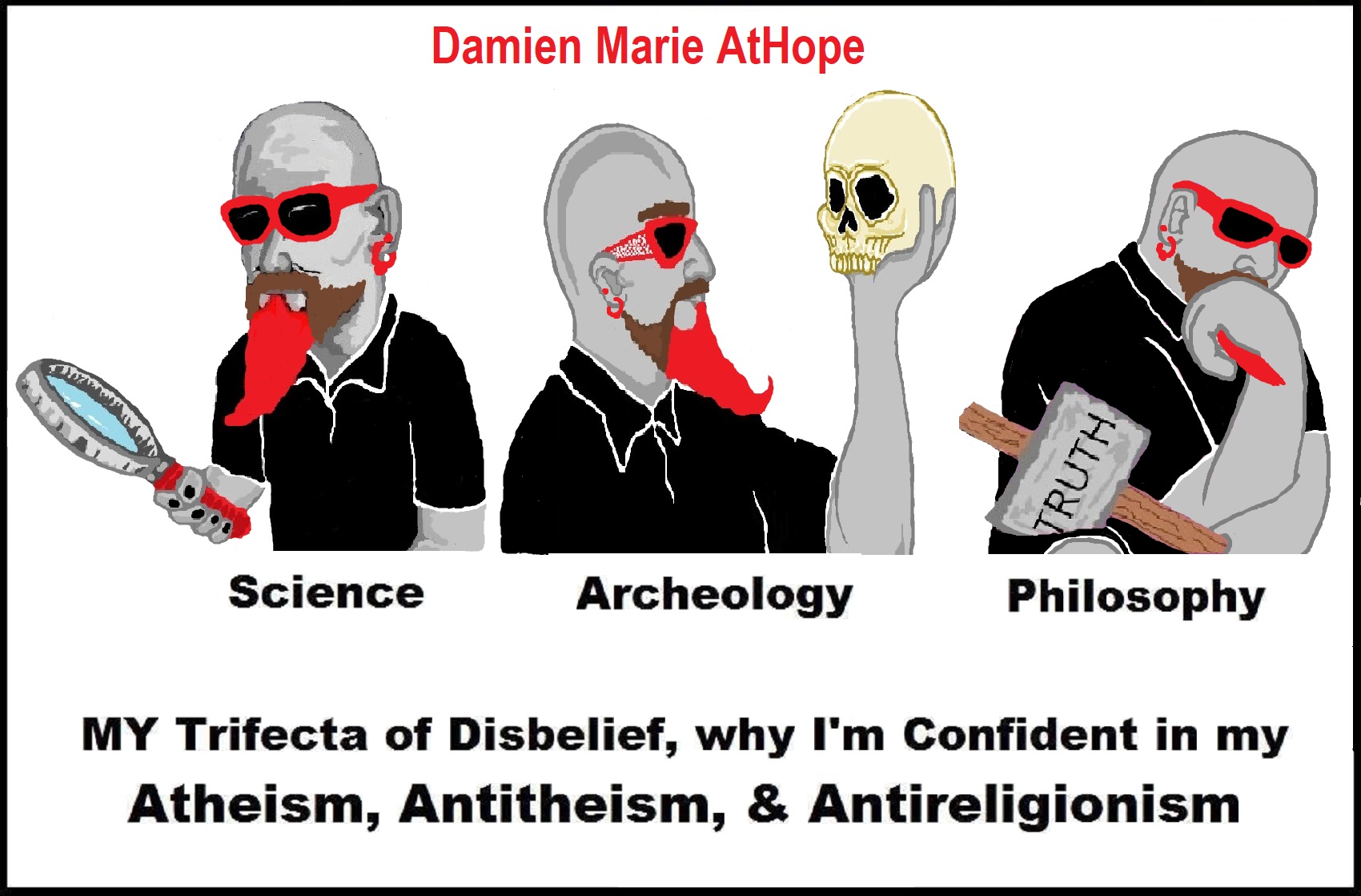
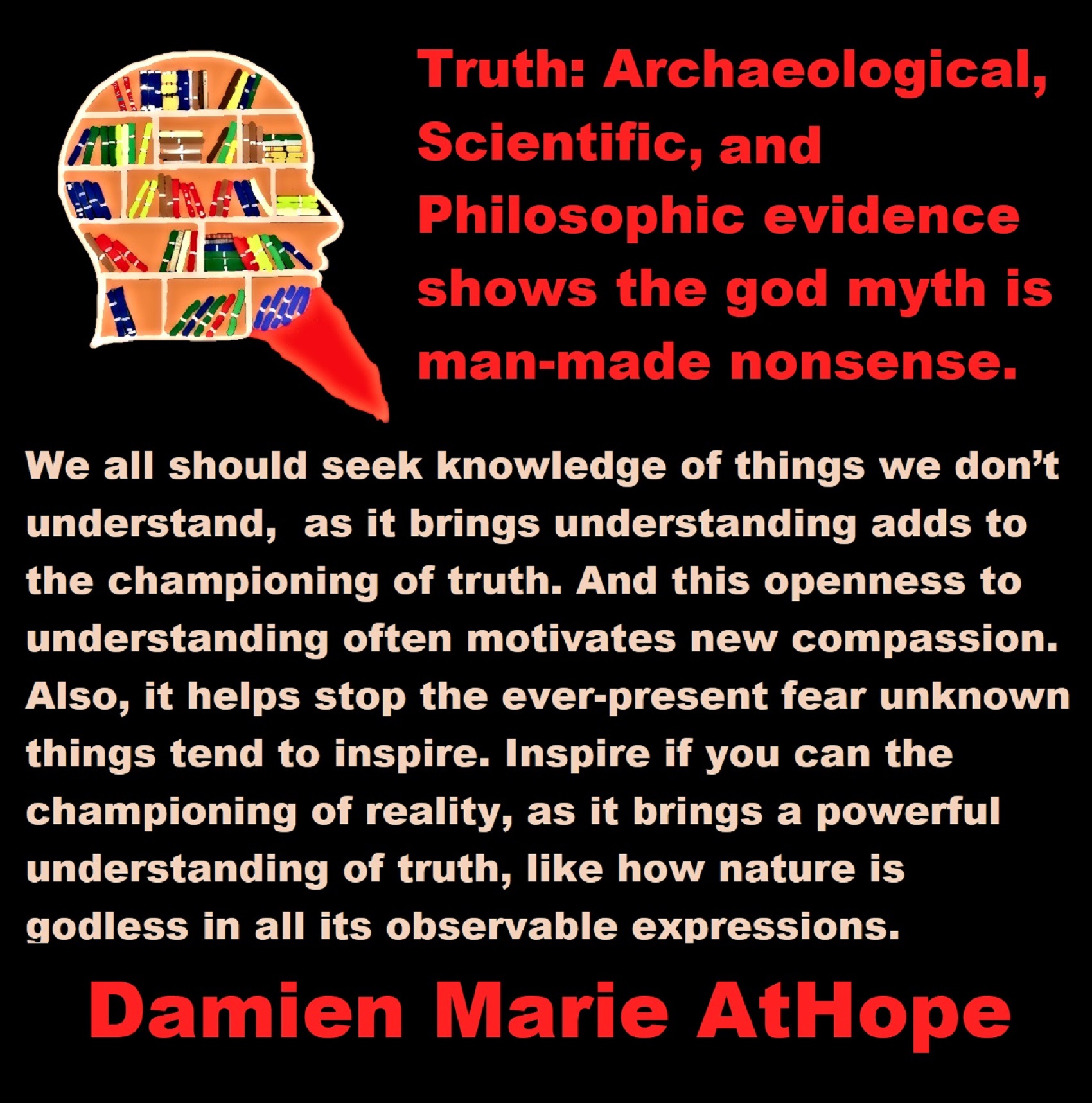
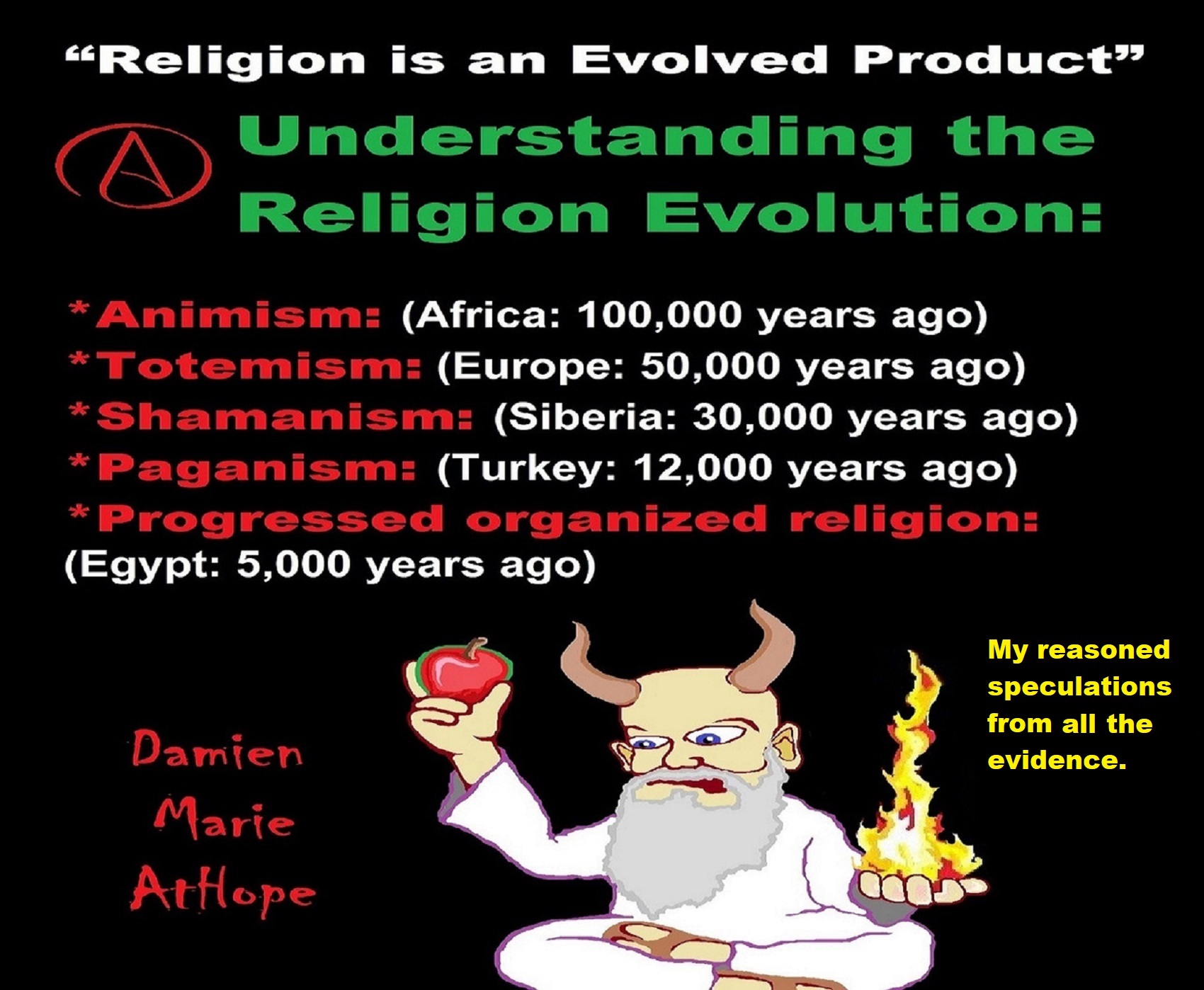
Not all “Religions” or “Religious Persuasions” have a god(s) but
All can be said to believe in some imaginary beings or imaginary things like spirits, afterlives, etc.
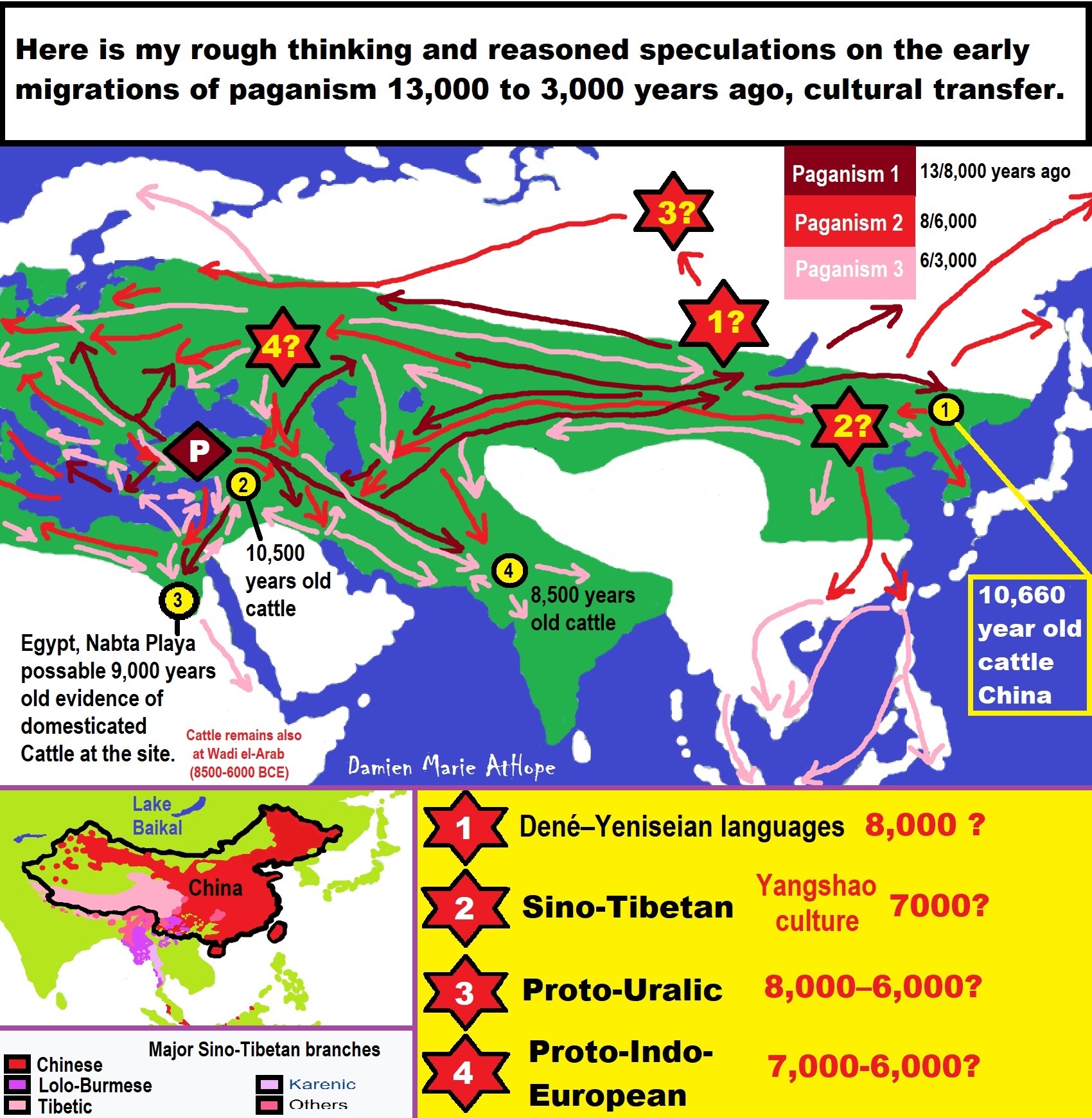
Paganism 12,000-4,000 years old
12,000-7,000 years old: related to (Pre-Capitalism)
7,000-5,000 years old: related to (Capitalism) (World War 0) Elite and their slaves!
5,000 years old: related to (Kings and the Rise of the State)
4,000 years old: related to (First Moralistic gods, then the Origin time of Monotheism)
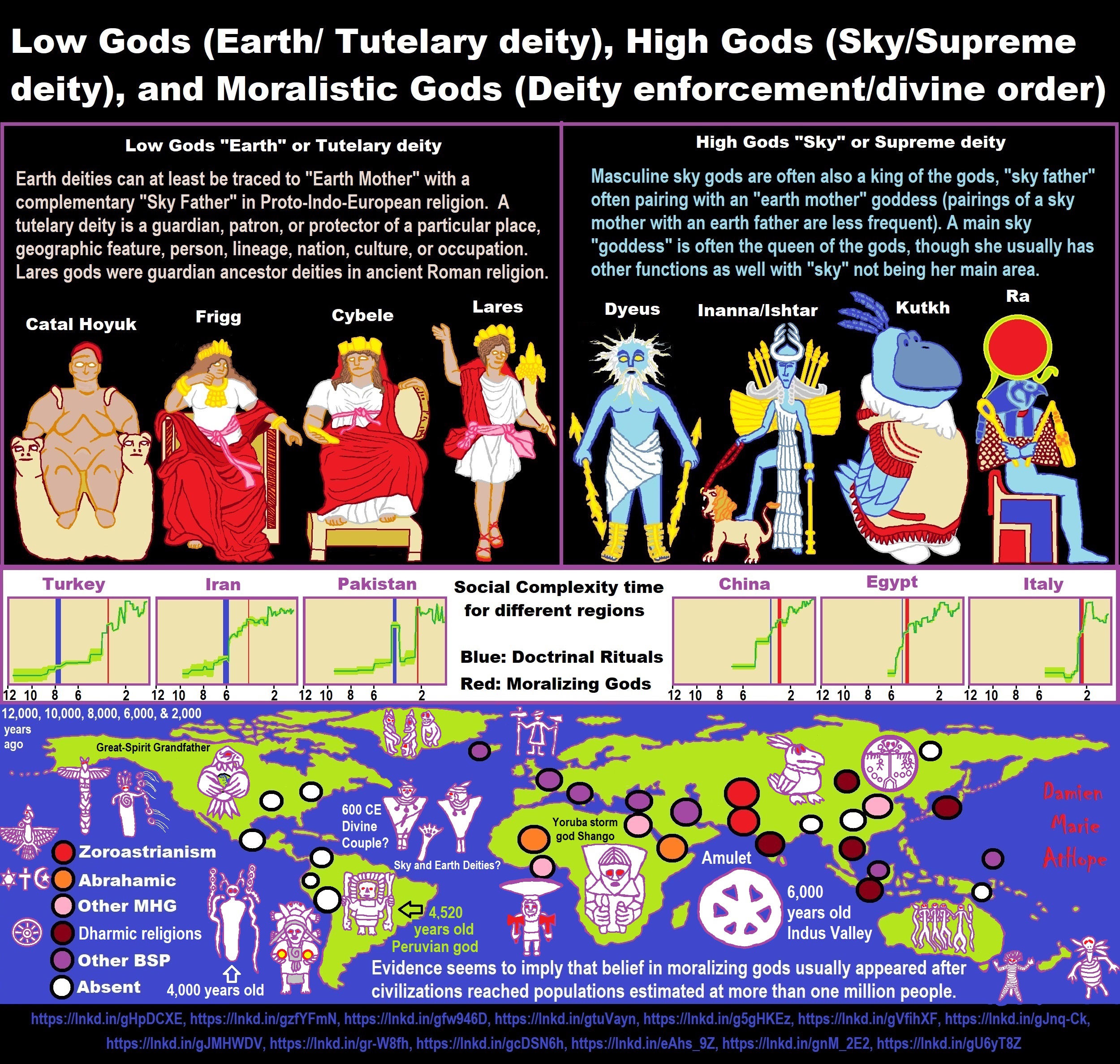
ref, ref, ref, ref, ref, ref, ref, ref, ref, ref, ref, ref, ref, ref, ref, ref, ref, ref, ref, ref, ref
Low Gods “Earth” or Tutelary deity and High Gods “Sky” or Supreme deity
“An Earth goddess is a deification of the Earth. Earth goddesses are often associated with the “chthonic” deities of the underworld. Ki and Ninhursag are Mesopotamian earth goddesses. In Greek mythology, the Earth is personified as Gaia, corresponding to Roman Terra, Indic Prithvi/Bhūmi, etc. traced to an “Earth Mother” complementary to the “Sky Father” in Proto-Indo-European religion. Egyptian mythology exceptionally has a sky goddess and an Earth god.” ref
“A mother goddess is a goddess who represents or is a personification of nature, motherhood, fertility, creation, destruction or who embodies the bounty of the Earth. When equated with the Earth or the natural world, such goddesses are sometimes referred to as Mother Earth or as the Earth Mother. In some religious traditions or movements, Heavenly Mother (also referred to as Mother in Heaven or Sky Mother) is the wife or feminine counterpart of the Sky father or God the Father.” ref
“Any masculine sky god is often also king of the gods, taking the position of patriarch within a pantheon. Such king gods are collectively categorized as “sky father” deities, with a polarity between sky and earth often being expressed by pairing a “sky father” god with an “earth mother” goddess (pairings of a sky mother with an earth father are less frequent). A main sky goddess is often the queen of the gods and may be an air/sky goddess in her own right, though she usually has other functions as well with “sky” not being her main. In antiquity, several sky goddesses in ancient Egypt, Mesopotamia, and the Near East were called Queen of Heaven. Neopagans often apply it with impunity to sky goddesses from other regions who were never associated with the term historically. The sky often has important religious significance. Many religions, both polytheistic and monotheistic, have deities associated with the sky.” ref
“In comparative mythology, sky father is a term for a recurring concept in polytheistic religions of a sky god who is addressed as a “father”, often the father of a pantheon and is often either a reigning or former King of the Gods. The concept of “sky father” may also be taken to include Sun gods with similar characteristics, such as Ra. The concept is complementary to an “earth mother“. “Sky Father” is a direct translation of the Vedic Dyaus Pita, etymologically descended from the same Proto-Indo-European deity name as the Greek Zeûs Pater and Roman Jupiter and Germanic Týr, Tir or Tiwaz, all of which are reflexes of the same Proto-Indo-European deity’s name, *Dyēus Ph₂tḗr. While there are numerous parallels adduced from outside of Indo-European mythology, there are exceptions (e.g. In Egyptian mythology, Nut is the sky mother and Geb is the earth father).” ref
Tutelary deity
“A tutelary (also tutelar) is a deity or spirit who is a guardian, patron, or protector of a particular place, geographic feature, person, lineage, nation, culture, or occupation. The etymology of “tutelary” expresses the concept of safety and thus of guardianship. In late Greek and Roman religion, one type of tutelary deity, the genius, functions as the personal deity or daimon of an individual from birth to death. Another form of personal tutelary spirit is the familiar spirit of European folklore.” ref
“A tutelary (also tutelar) in Korean shamanism, jangseung and sotdae were placed at the edge of villages to frighten off demons. They were also worshiped as deities. Seonangshin is the patron deity of the village in Korean tradition and was believed to embody the Seonangdang. In Philippine animism, Diwata or Lambana are deities or spirits that inhabit sacred places like mountains and mounds and serve as guardians. Such as: Maria Makiling is the deity who guards Mt. Makiling and Maria Cacao and Maria Sinukuan. In Shinto, the spirits, or kami, which give life to human bodies come from nature and return to it after death. Ancestors are therefore themselves tutelaries to be worshiped. And similarly, Native American beliefs such as Tonás, tutelary animal spirit among the Zapotec and Totems, familial or clan spirits among the Ojibwe, can be animals.” ref
“A tutelary (also tutelar) in Austronesian beliefs such as: Atua (gods and spirits of the Polynesian peoples such as the Māori or the Hawaiians), Hanitu (Bunun of Taiwan‘s term for spirit), Hyang (Kawi, Sundanese, Javanese, and Balinese Supreme Being, in ancient Java and Bali mythology and this spiritual entity, can be either divine or ancestral), Kaitiaki (New Zealand Māori term used for the concept of guardianship, for the sky, the sea, and the land), Kawas (mythology) (divided into 6 groups: gods, ancestors, souls of the living, spirits of living things, spirits of lifeless objects, and ghosts), Tiki (Māori mythology, Tiki is the first man created by either Tūmatauenga or Tāne and represents deified ancestors found in most Polynesian cultures). ” ref, ref, ref, ref, ref, ref, ref
Mesopotamian Tutelary Deities can be seen as ones related to City-States
“Historical city-states included Sumerian cities such as Uruk and Ur; Ancient Egyptian city-states, such as Thebes and Memphis; the Phoenician cities (such as Tyre and Sidon); the five Philistine city-states; the Berber city-states of the Garamantes; the city-states of ancient Greece (the poleis such as Athens, Sparta, Thebes, and Corinth); the Roman Republic (which grew from a city-state into a vast empire); the Italian city-states from the Middle Ages to the early modern period, such as Florence, Siena, Ferrara, Milan (which as they grew in power began to dominate neighboring cities) and Genoa and Venice, which became powerful thalassocracies; the Mayan and other cultures of pre-Columbian Mesoamerica (including cities such as Chichen Itza, Tikal, Copán and Monte Albán); the central Asian cities along the Silk Road; the city-states of the Swahili coast; Ragusa; states of the medieval Russian lands such as Novgorod and Pskov; and many others.” ref
“The Uruk period (ca. 4000 to 3100 BCE; also known as Protoliterate period) of Mesopotamia, named after the Sumerian city of Uruk, this period saw the emergence of urban life in Mesopotamia and the Sumerian civilization. City-States like Uruk and others had a patron tutelary City Deity along with a Priest-King.” ref
“Chinese folk religion, both past, and present, includes myriad tutelary deities. Exceptional individuals, highly cultivated sages, and prominent ancestors can be deified and honored after death. Lord Guan is the patron of military personnel and police, while Mazu is the patron of fishermen and sailors. Such as Tu Di Gong (Earth Deity) is the tutelary deity of a locality, and each individual locality has its own Earth Deity and Cheng Huang Gong (City God) is the guardian deity of an individual city, worshipped by local officials and locals since imperial times.” ref
“A tutelary (also tutelar) in Hinduism, personal tutelary deities are known as ishta-devata, while family tutelary deities are known as Kuladevata. Gramadevata are guardian deities of villages. Devas can also be seen as tutelary. Shiva is the patron of yogis and renunciants. City goddesses include: Mumbadevi (Mumbai), Sachchika (Osian); Kuladevis include: Ambika (Porwad), and Mahalakshmi. In NorthEast India Meitei mythology and religion (Sanamahism) of Manipur, there are various types of tutelary deities, among which Lam Lais are the most predominant ones. Tibetan Buddhism has Yidam as a tutelary deity. Dakini is the patron of those who seek knowledge.” ref
“A tutelary (also tutelar) The Greeks also thought deities guarded specific places: for instance, Athena was the patron goddess of the city of Athens. Socrates spoke of hearing the voice of his personal spirit or daimonion:
You have often heard me speak of an oracle or sign which comes to me … . This sign I have had ever since I was a child. The sign is a voice which comes to me and always forbids me to do something which I am going to do, but never commands me to do anything, and this is what stands in the way of my being a politician.” ref
“Tutelary deities who guard and preserve a place or a person are fundamental to ancient Roman religion. The tutelary deity of a man was his Genius, that of a woman her Juno. In the Imperial era, the Genius of the Emperor was a focus of Imperial cult. An emperor might also adopt a major deity as his personal patron or tutelary, as Augustus did Apollo. Precedents for claiming the personal protection of a deity were established in the Republican era, when for instance the Roman dictator Sulla advertised the goddess Victory as his tutelary by holding public games (ludi) in her honor.” ref
“Each town or city had one or more tutelary deities, whose protection was considered particularly vital in time of war and siege. Rome itself was protected by a goddess whose name was to be kept ritually secret on pain of death (for a supposed case, see Quintus Valerius Soranus). The Capitoline Triad of Juno, Jupiter, and Minerva were also tutelaries of Rome. The Italic towns had their own tutelary deities. Juno often had this function, as at the Latin town of Lanuvium and the Etruscan city of Veii, and was often housed in an especially grand temple on the arx (citadel) or other prominent or central location. The tutelary deity of Praeneste was Fortuna, whose oracle was renowned.” ref
“The Roman ritual of evocatio was premised on the belief that a town could be made vulnerable to military defeat if the power of its tutelary deity were diverted outside the city, perhaps by the offer of superior cult at Rome. The depiction of some goddesses such as the Magna Mater (Great Mother, or Cybele) as “tower-crowned” represents their capacity to preserve the city. A town in the provinces might adopt a deity from within the Roman religious sphere to serve as its guardian, or syncretize its own tutelary with such; for instance, a community within the civitas of the Remi in Gaul adopted Apollo as its tutelary, and at the capital of the Remi (present-day Rheims), the tutelary was Mars Camulus.” ref
Household deity (a kind of or related to a Tutelary deity)
“A household deity is a deity or spirit that protects the home, looking after the entire household or certain key members. It has been a common belief in paganism as well as in folklore across many parts of the world. Household deities fit into two types; firstly, a specific deity – typically a goddess – often referred to as a hearth goddess or domestic goddess who is associated with the home and hearth, such as the ancient Greek Hestia.” ref
“The second type of household deities are those that are not one singular deity, but a type, or species of animistic deity, who usually have lesser powers than major deities. This type was common in the religions of antiquity, such as the Lares of ancient Roman religion, the Gashin of Korean shamanism, and Cofgodas of Anglo-Saxon paganism. These survived Christianisation as fairy-like creatures existing in folklore, such as the Anglo-Scottish Brownie and Slavic Domovoy.” ref
“Household deities were usually worshipped not in temples but in the home, where they would be represented by small idols (such as the teraphim of the Bible, often translated as “household gods” in Genesis 31:19 for example), amulets, paintings, or reliefs. They could also be found on domestic objects, such as cosmetic articles in the case of Tawaret. The more prosperous houses might have a small shrine to the household god(s); the lararium served this purpose in the case of the Romans. The gods would be treated as members of the family and invited to join in meals, or be given offerings of food and drink.” ref
“In many religions, both ancient and modern, a god would preside over the home. Certain species, or types, of household deities, existed. An example of this was the Roman Lares. Many European cultures retained house spirits into the modern period. Some examples of these include:
- Brownie (Scotland and England) or Hob (England) / Kobold (Germany) / Goblin / Hobgoblin
- Domovoy (Slavic)
- Nisse (Norwegian or Danish) / Tomte (Swedish) / Tonttu (Finnish)
- Húsvættir (Norse)” ref
“Although the cosmic status of household deities was not as lofty as that of the Twelve Olympians or the Aesir, they were also jealous of their dignity and also had to be appeased with shrines and offerings, however humble. Because of their immediacy they had arguably more influence on the day-to-day affairs of men than the remote gods did. Vestiges of their worship persisted long after Christianity and other major religions extirpated nearly every trace of the major pagan pantheons. Elements of the practice can be seen even today, with Christian accretions, where statues to various saints (such as St. Francis) protect gardens and grottos. Even the gargoyles found on older churches, could be viewed as guardians partitioning a sacred space.” ref
“For centuries, Christianity fought a mop-up war against these lingering minor pagan deities, but they proved tenacious. For example, Martin Luther‘s Tischreden have numerous – quite serious – references to dealing with kobolds. Eventually, rationalism and the Industrial Revolution threatened to erase most of these minor deities, until the advent of romantic nationalism rehabilitated them and embellished them into objects of literary curiosity in the 19th century. Since the 20th century this literature has been mined for characters for role-playing games, video games, and other fantasy personae, not infrequently invested with invented traits and hierarchies somewhat different from their mythological and folkloric roots.” ref
“In contradistinction to both Herbert Spencer and Edward Burnett Tylor, who defended theories of animistic origins of ancestor worship, Émile Durkheim saw its origin in totemism. In reality, this distinction is somewhat academic, since totemism may be regarded as a particularized manifestation of animism, and something of a synthesis of the two positions was attempted by Sigmund Freud. In Freud’s Totem and Taboo, both totem and taboo are outward expressions or manifestations of the same psychological tendency, a concept which is complementary to, or which rather reconciles, the apparent conflict. Freud preferred to emphasize the psychoanalytic implications of the reification of metaphysical forces, but with particular emphasis on its familial nature. This emphasis underscores, rather than weakens, the ancestral component.” ref
“William Edward Hearn, a noted classicist, and jurist, traced the origin of domestic deities from the earliest stages as an expression of animism, a belief system thought to have existed also in the neolithic, and the forerunner of Indo-European religion. In his analysis of the Indo-European household, in Chapter II “The House Spirit”, Section 1, he states:
The belief which guided the conduct of our forefathers was … the spirit rule of dead ancestors.” ref
“In Section 2 he proceeds to elaborate:
It is thus certain that the worship of deceased ancestors is a vera causa, and not a mere hypothesis. …
In the other European nations, the Slavs, the Teutons, and the Kelts, the House Spirit appears with no less distinctness. … [T]he existence of that worship does not admit of doubt. … The House Spirits had a multitude of other names which it is needless here to enumerate, but all of which are more or less expressive of their friendly relations with man. … In [England] … [h]e is the Brownie. … In Scotland this same Brownie is well known. He is usually described as attached to particular families, with whom he has been known to reside for centuries, threshing the corn, cleaning the house, and performing similar household tasks. His favorite gratification was milk and honey.” ref
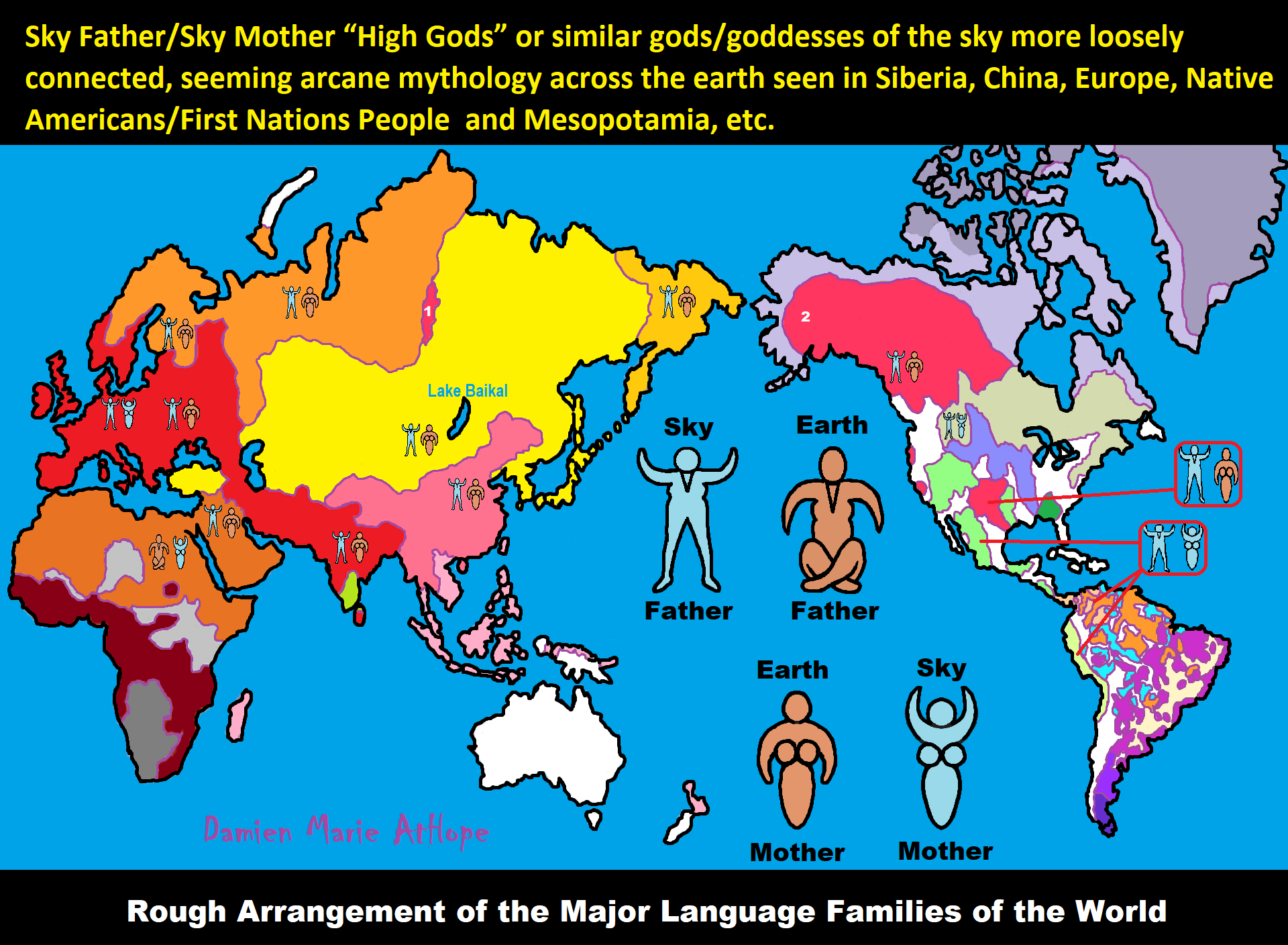
ref, ref, ref, ref, ref, ref, ref, ref, ref, ref, ref, ref, ref, ref, ref, ref, ref
“These ideas are my speculations from the evidence.”
I am still researching the “god‘s origins” all over the world. So you know, it is very complicated but I am smart and willing to look, DEEP, if necessary, which going very deep does seem to be needed here, when trying to actually understand the evolution of gods and goddesses. I am sure of a few things and less sure of others, but even in stuff I am not fully grasping I still am slowly figuring it out, to explain it to others. But as I research more I am understanding things a little better, though I am still working on understanding it all or something close and thus always figuring out more.
Sky Father/Sky God?
“Egyptian: (Nut) Sky Mother and (Geb) Earth Father” (Egypt is different but similar)
Turkic/Mongolic: (Tengri/Tenger Etseg) Sky Father and (Eje/Gazar Eej) Earth Mother *Transeurasian*
Hawaiian: (Wākea) Sky Father and (Papahānaumoku) Earth Mother *Austronesian*
New Zealand/ Māori: (Ranginui) Sky Father and (Papatūānuku) Earth Mother *Austronesian*
Proto-Indo-European: (Dyḗus/Dyḗus ph₂tḗr) Sky Father and (Dʰéǵʰōm/Pleth₂wih₁) Earth Mother
Indo-Aryan: (Dyaus Pita) Sky Father and (Prithvi Mata) Earth Mother *Indo-European*
Italic: (Jupiter) Sky Father and (Juno) Sky Mother *Indo-European*
Etruscan: (Tinia) Sky Father and (Uni) Sky Mother *Tyrsenian/Italy Pre–Indo-European*
Hellenic/Greek: (Zeus) Sky Father and (Hera) Sky Mother who started as an “Earth Goddess” *Indo-European*
Nordic: (Dagr) Sky Father and (Nótt) Sky Mother *Indo-European*
Slavic: (Perun) Sky Father and (Mokosh) Earth Mother *Indo-European*
Illyrian: (Deipaturos) Sky Father and (Messapic Damatura’s “earth-mother” maybe) Earth Mother *Indo-European*
Albanian: (Zojz) Sky Father and (?) *Indo-European*
Baltic: (Perkūnas) Sky Father and (Saulė) Sky Mother *Indo-European*
Germanic: (Týr) Sky Father and (?) *Indo-European*
Colombian-Muisca: (Bochica) Sky Father and (Huythaca) Sky Mother *Chibchan*
Aztec: (Quetzalcoatl) Sky Father and (Xochiquetzal) Sky Mother *Uto-Aztecan*
Incan: (Viracocha) Sky Father and (Mama Runtucaya) Sky Mother *Quechuan*
China: (Tian/Shangdi) Sky Father and (Dì) Earth Mother *Sino-Tibetan*
Sumerian, Assyrian and Babylonian: (An/Anu) Sky Father and (Ki) Earth Mother
Finnish: (Ukko) Sky Father and (Akka) Earth Mother *Finno-Ugric*
Sami: (Horagalles) Sky Father and (Ravdna) Earth Mother *Finno-Ugric*
Puebloan-Zuni: (Ápoyan Ta’chu) Sky Father and (Áwitelin Tsíta) Earth Mother
Puebloan-Hopi: (Tawa) Sky Father and (Kokyangwuti/Spider Woman/Grandmother) Earth Mother *Uto-Aztecan*
Puebloan-Navajo: (Tsohanoai) Sky Father and (Estsanatlehi) Earth Mother *Na-Dene*
ref, ref, ref, ref, ref, ref, ref, ref, ref, ref, ref, ref, ref, ref, ref, ref, ref, ref, ref, ref, ref, ref, ref, ref, ref, ref, ref
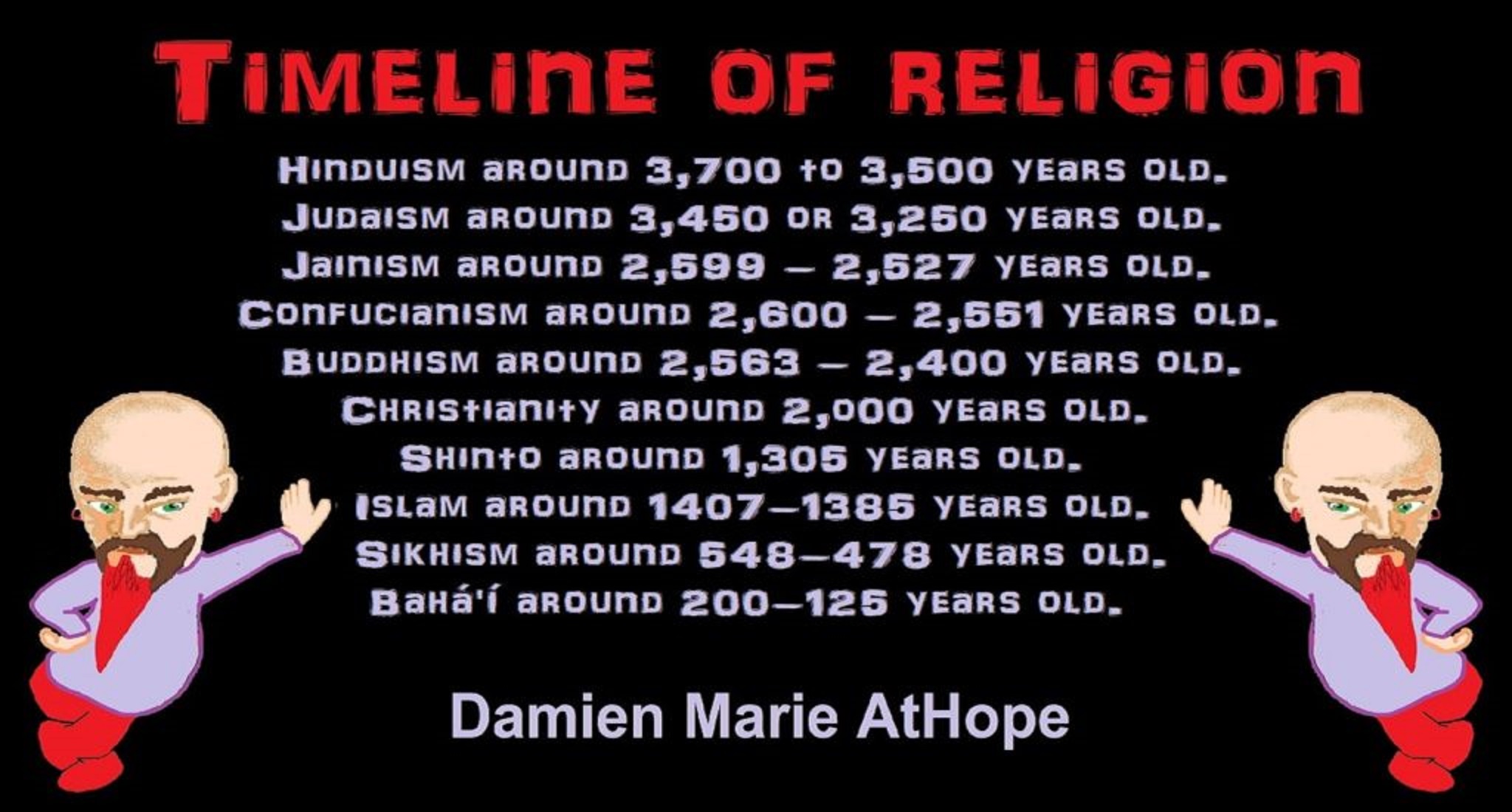
Hinduism around 3,700 to 3,500 years old. ref
Judaism around 3,450 or 3,250 years old. (The first writing in the bible was “Paleo-Hebrew” dated to around 3,000 years ago Khirbet Qeiyafa is the site of an ancient fortress city overlooking the Elah Valley. And many believe the religious Jewish texts were completed around 2,500) ref, ref
Judaism is around 3,450 or 3,250 years old. (“Paleo-Hebrew” 3,000 years ago and Torah 2,500 years ago)
“Judaism is an Abrahamic, its roots as an organized religion in the Middle East during the Bronze Age. Some scholars argue that modern Judaism evolved from Yahwism, the religion of ancient Israel and Judah, by the late 6th century BCE, and is thus considered to be one of the oldest monotheistic religions.” ref
“Yahwism is the name given by modern scholars to the religion of ancient Israel, essentially polytheistic, with a plethora of gods and goddesses. Heading the pantheon was Yahweh, the national god of the Israelite kingdoms of Israel and Judah, with his consort, the goddess Asherah; below them were second-tier gods and goddesses such as Baal, Shamash, Yarikh, Mot, and Astarte, all of whom had their own priests and prophets and numbered royalty among their devotees, and a third and fourth tier of minor divine beings, including the mal’ak, the messengers of the higher gods, who in later times became the angels of Judaism, Christianity and Islam. Yahweh, however, was not the ‘original’ god of Israel “Isra-El”; it is El, the head of the Canaanite pantheon, whose name forms the basis of the name “Israel”, and none of the Old Testament patriarchs, the tribes of Israel, the Judges, or the earliest monarchs, have a Yahwistic theophoric name (i.e., one incorporating the name of Yahweh).” ref
“El is a Northwest Semitic word meaning “god” or “deity“, or referring (as a proper name) to any one of multiple major ancient Near Eastern deities. A rarer form, ‘ila, represents the predicate form in Old Akkadian and in Amorite. The word is derived from the Proto-Semitic *ʔil-, meaning “god”. Specific deities known as ‘El or ‘Il include the supreme god of the ancient Canaanite religion and the supreme god of East Semitic speakers in Mesopotamia’s Early Dynastic Period. ʼĒl is listed at the head of many pantheons. In some Canaanite and Ugaritic sources, ʼĒl played a role as father of the gods, of creation, or both. For example, in the Ugaritic texts, ʾil mlk is understood to mean “ʼĒl the King” but ʾil hd as “the god Hadad“. The Semitic root ʾlh (Arabic ʾilāh, Aramaic ʾAlāh, ʾElāh, Hebrew ʾelōah) may be ʾl with a parasitic h, and ʾl may be an abbreviated form of ʾlh. In Ugaritic the plural form meaning “gods” is ʾilhm, equivalent to Hebrew ʾelōhîm “powers”. In the Hebrew texts this word is interpreted as being semantically singular for “god” by biblical commentators. However the documentary hypothesis for the Old Testament (corresponds to the Jewish Torah) developed originally in the 1870s, identifies these that different authors – the Jahwist, Elohist, Deuteronomist, and the Priestly source – were responsible for editing stories from a polytheistic religion into those of a monotheistic religion. Inconsistencies that arise between monotheism and polytheism in the texts are reflective of this hypothesis.” ref
Jainism around 2,599 – 2,527 years old. ref
Confucianism around 2,600 – 2,551 years old. ref
Buddhism around 2,563/2,480 – 2,483/2,400 years old. ref
Christianity around 2,o00 years old. ref
Shinto around 1,305 years old. ref
Islam around 1407–1385 years old. ref

Knowledge to Ponder:
Stars/Astrology:
- Possibly, around 30,000 years ago (in simpler form) to 6,000 years ago, Stars/Astrology are connected to Ancestors, Spirit Animals, and Deities.
- The star also seems to be a possible proto-star for Star of Ishtar, Star of Inanna, or Star of Venus.
- Around 7,000 to 6,000 years ago, Star Constellations/Astrology have connections to the “Kurgan phenomenon” of below-ground “mound” stone/wood burial structures and “Dolmen phenomenon” of above-ground stone burial structures.
- Around 6,500–5,800 years ago, The Northern Levant migrations into Jordon and Israel in the Southern Levant brought new cultural and religious transfer from Turkey and Iran.
- “The Ghassulian Star,” a mysterious 6,000-year-old mural from Jordan may have connections to the European paganstic kurgan/dolmens phenomenon.
“Astrology is a range of divinatory practices, recognized as pseudoscientific since the 18th century, that claim to discern information about human affairs and terrestrial events by studying the apparent positions of celestial objects. Different cultures have employed forms of astrology since at least the 2nd millennium BCE, these practices having originated in calendrical systems used to predict seasonal shifts and to interpret celestial cycles as signs of divine communications. Most, if not all, cultures have attached importance to what they observed in the sky, and some—such as the Hindus, Chinese, and the Maya—developed elaborate systems for predicting terrestrial events from celestial observations. Western astrology, one of the oldest astrological systems still in use, can trace its roots to 19th–17th century BCE Mesopotamia, from where it spread to Ancient Greece, Rome, the Islamicate world and eventually Central and Western Europe. Contemporary Western astrology is often associated with systems of horoscopes that purport to explain aspects of a person’s personality and predict significant events in their lives based on the positions of celestial objects; the majority of professional astrologers rely on such systems.” ref
Around 5,500 years ago, Science evolves, The first evidence of science was 5,500 years ago and was demonstrated by a body of empirical, theoretical, and practical knowledge about the natural world. ref
Around 5,000 years ago, Origin of Logics is a Naturalistic Observation (principles of valid reasoning, inference, & demonstration) ref
Around 4,150 to 4,000 years ago: The earliest surviving versions of the Sumerian Epic of Gilgamesh, which was originally titled “He who Saw the Deep” (Sha naqba īmuru) or “Surpassing All Other Kings” (Shūtur eli sharrī) were written. ref
Hinduism:
- 3,700 years ago or so, the oldest of the Hindu Vedas (scriptures), the Rig Veda was composed.
- 3,500 years ago or so, the Vedic Age began in India after the collapse of the Indus Valley Civilization.
Judaism:
- around 3,000 years ago, the first writing in the bible was “Paleo-Hebrew”
- around 2,500 years ago, many believe the religious Jewish texts were completed
Myths: The bible inspired religion is not just one religion or one myth but a grouping of several religions and myths
- Around 3,450 or 3,250 years ago, according to legend, is the traditionally accepted period in which the Israelite lawgiver, Moses, provided the Ten Commandments.
- Around 2,500 to 2,400 years ago, a collection of ancient religious writings by the Israelites based primarily upon the Hebrew Bible, Tanakh, or Old Testament is the first part of Christianity’s bible.
- Around 2,400 years ago, the most accepted hypothesis is that the canon was formed in stages, first the Pentateuch (Torah).
- Around 2,140 to 2,116 years ago, the Prophets was written during the Hasmonean dynasty, and finally the remaining books.
- Christians traditionally divide the Old Testament into four sections:
- The first five books or Pentateuch (Torah).
- The proposed history books telling the history of the Israelites from their conquest of Canaan to their defeat and exile in Babylon.
- The poetic and proposed “Wisdom books” dealing, in various forms, with questions of good and evil in the world.
- The books of the biblical prophets, warning of the consequences of turning away from God:
- Henotheism:
- Exodus 20:23 “You shall not make other gods besides Me (not saying there are no other gods just not to worship them); gods of silver or gods of gold, you shall not make for yourselves.”
- Polytheism:
- Judges 10:6 “Then the sons of Israel again did evil in the sight of the LORD, served the Baals and the Ashtaroth, the gods of Aram, the gods of Sidon, the gods of Moab, the gods of the sons of Ammon, and the gods of the Philistines; thus they forsook the LORD and did not serve Him.”
- 1 Corinthians 8:5 “For even if there are so-called gods whether in heaven or on earth, as indeed there are many gods and many lords.”
- Monotheism:
- Isaiah 43:10 “You are my witnesses,” declares the LORD, “and my servant whom I have chosen, so that you may know and believe me and understand that I am he. Before me no god was formed, nor will there be one after me.
Around 2,570 to 2,270 Years Ago, there is a confirmation of atheistic doubting as well as atheistic thinking, mainly by Greek philosophers. However, doubting gods is likely as old as the invention of gods and should destroy the thinking that belief in god(s) is the “default belief”. The Greek word is apistos (a “not” and pistos “faithful,”), thus not faithful or faithless because one is unpersuaded and unconvinced by a god(s) claim. Short Definition: unbelieving, unbeliever, or unbelief.
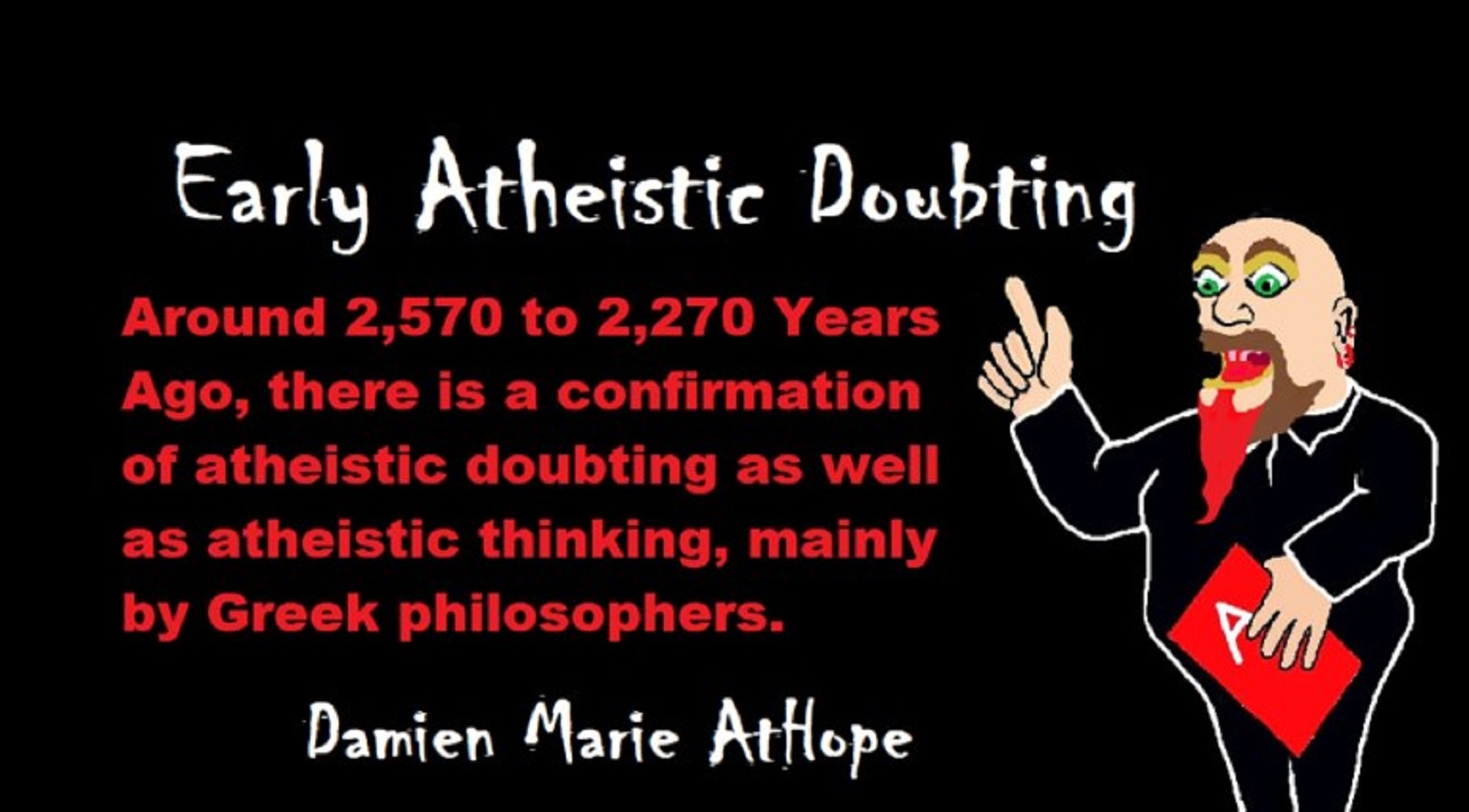
Expressions of Atheistic Thinking:
- Around 2,600 years ago, Ajita Kesakambali, ancient Indian philosopher, who is the first known proponent of Indian materialism. ref
- Around 2,535 to 2,475 years ago, Heraclitus, Greek pre-Socratic philosopher, a native of the Greek city Ephesus, Ionia, on the coast of Anatolia, also known as Asia Minor or modern Turkey. ref
- Around 2,500 to 2,400 years ago, according to The Story of Civilization book series certain African pygmy tribes have no identifiable gods, spirits, or religious beliefs or rituals, and even what burials accrue are without ceremony. ref
- Around 2,490 to 2,430 years ago, Empedocles, Greek pre-Socratic philosopher and a citizen of Agrigentum, a Greek city in Sicily. ref
- Around 2,460 to 2,370 years ago, Democritus, Greek pre-Socratic philosopher considered to be the “father of modern science” possibly had some disbelief amounting to atheism. ref
- Around 2,399 years ago or so, Socrates, a famous Greek philosopher was tried for sinfulness by teaching doubt of state gods. ref
- Around 2,341 to 2,270 years ago, Epicurus, a Greek philosopher known for composing atheistic critics and famously stated, “Is God willing to prevent evil, but not able? Then he is not omnipotent. Is he able, but not willing? Then he is malevolent. Is he both able and willing? Then whence cometh evil? Is he neither able nor willing? Then why call him god?” ref
This last expression by Epicurus, seems to be an expression of Axiological Atheism. To understand and utilize value or actually possess “Value Conscious/Consciousness” to both give a strong moral “axiological” argument (the problem of evil) as well as use it to fortify humanism and positive ethical persuasion of human helping and care responsibilities. Because value-blindness gives rise to sociopathic/psychopathic evil.
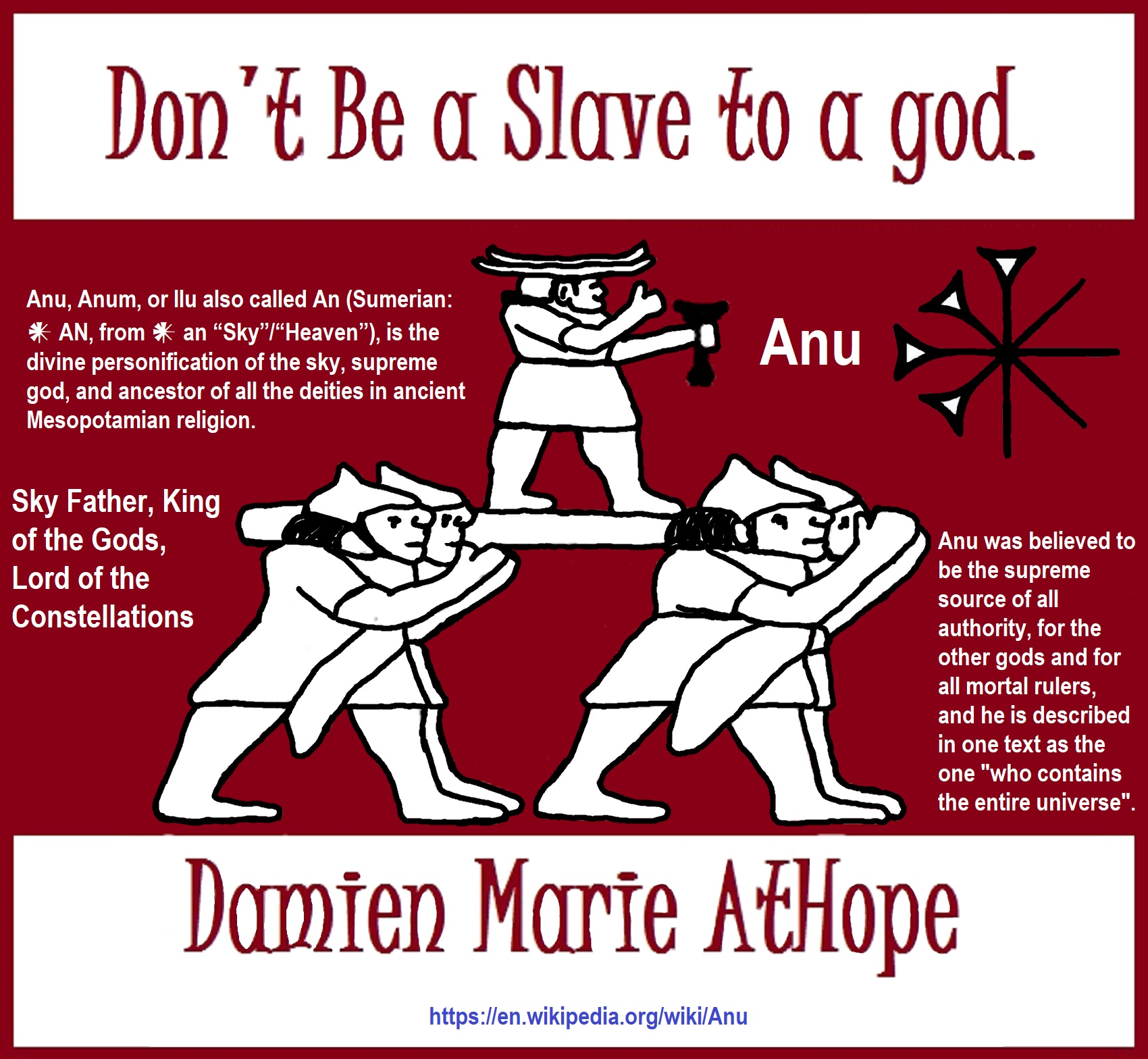
“Theists, there has to be a god, as something can not come from nothing.”
Well, thus something (unknown) happened and then there was something. This does not tell us what the something that may have been involved with something coming from nothing. A supposed first cause, thus something (unknown) happened and then there was something is not an open invitation to claim it as known, neither is it justified to call or label such an unknown as anything, especially an unsubstantiated magical thinking belief born of mythology and religious storytelling.
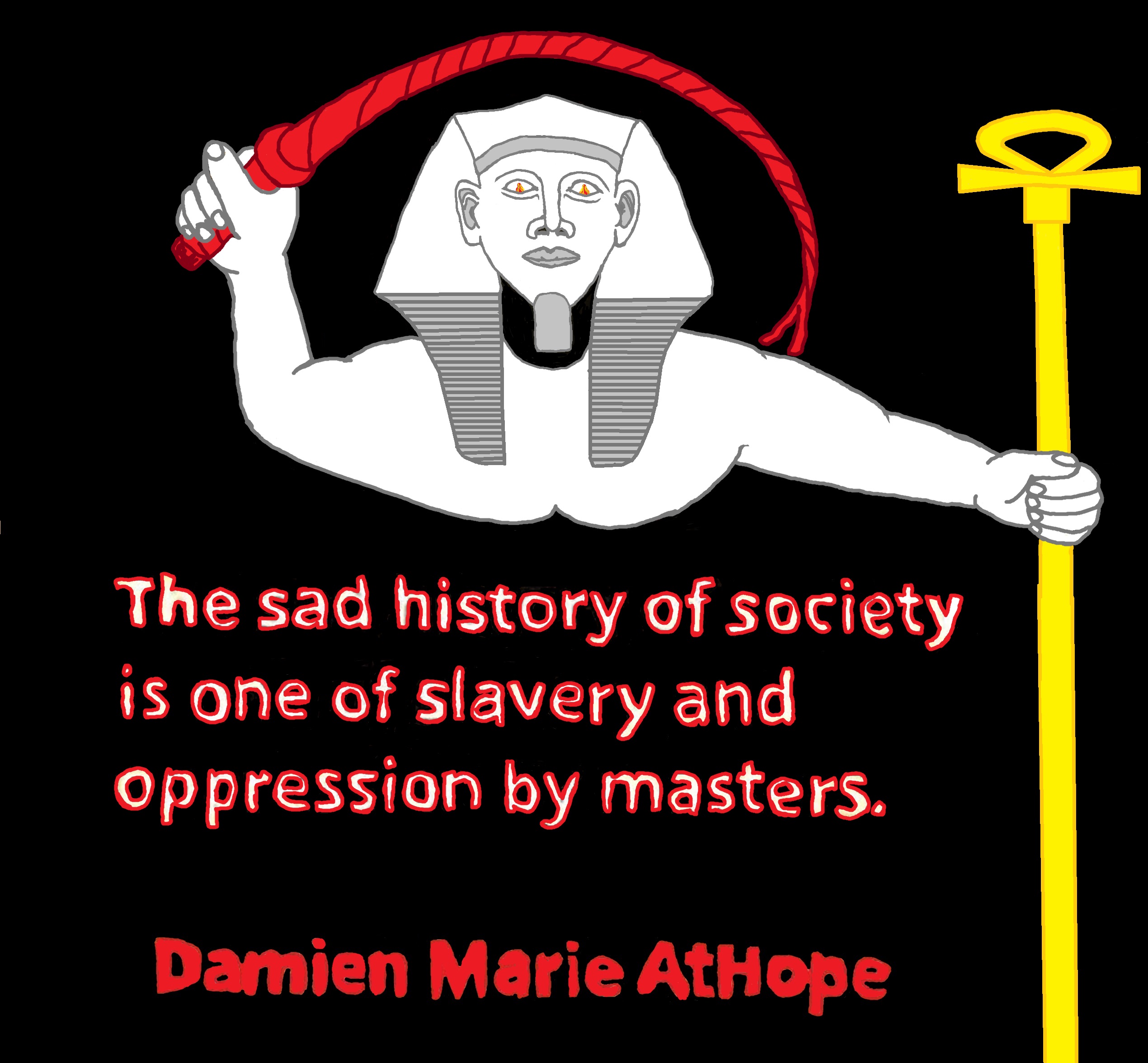
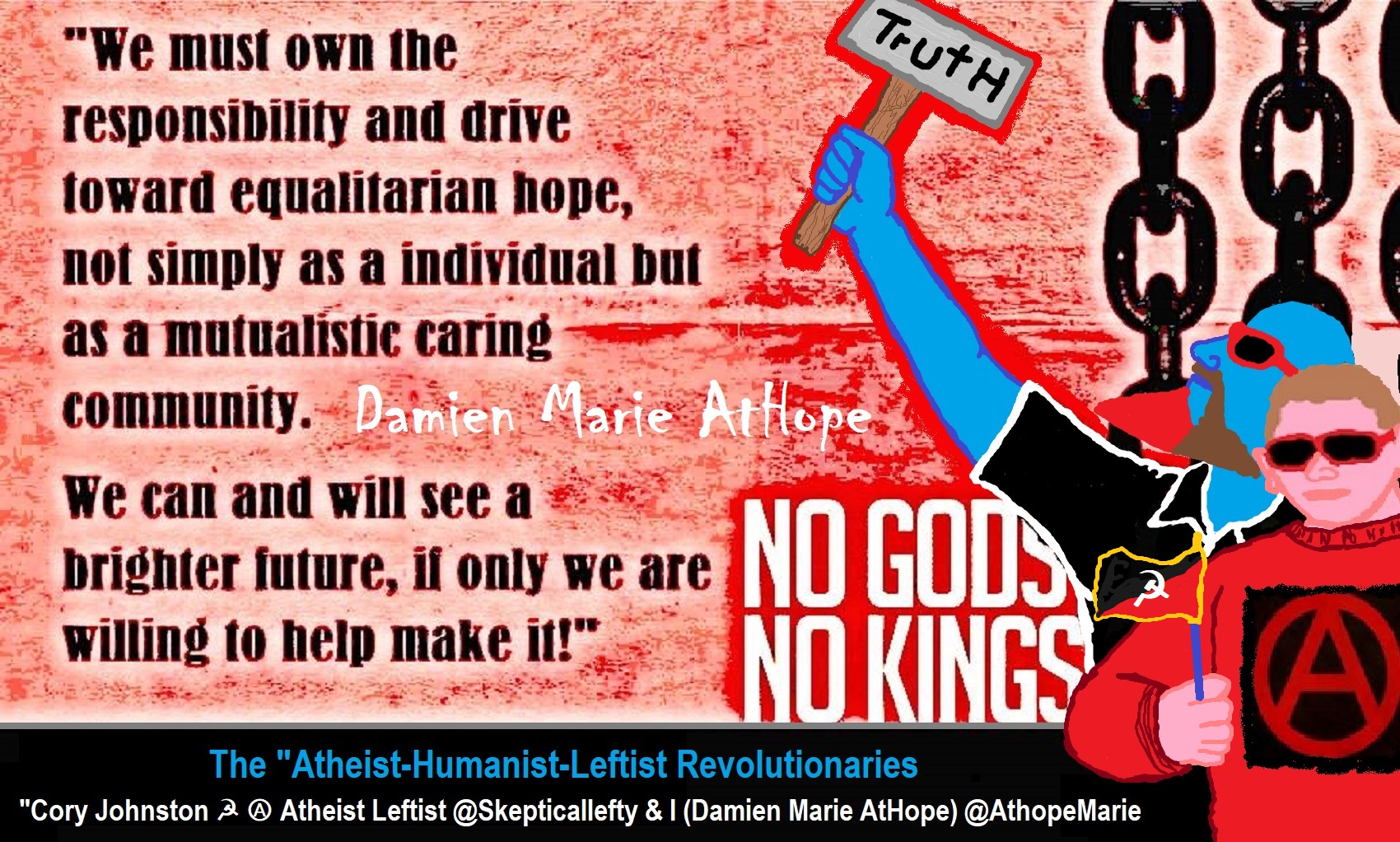
While hallucinogens are associated with shamanism, it is alcohol that is associated with paganism.
The Atheist-Humanist-Leftist Revolutionaries Shows in the prehistory series:
Show two: Pre-animism 300,000 years old and animism 100,000 years old: related to “Anarchism and Socialism”
Show tree: Totemism 50,000 years old: related to “Anarchism and Socialism”
Show four: Shamanism 30,000 years old: related to “Anarchism and Socialism”
Show five: Paganism 12,000 years old: related to “Anarchism and Socialism”
Show six: Emergence of hierarchy, sexism, slavery, and the new male god dominance: Paganism 7,000-5,000 years old: related to “Anarchism and Socialism” (Capitalism) (World War 0) Elite and their slaves!
Prehistory: related to “Anarchism and Socialism” the division of labor, power, rights, and recourses: VIDEO
Pre-animism 300,000 years old and animism 100,000 years old: related to “Anarchism and Socialism”: VIDEO
Totemism 50,000 years old: related to “Anarchism and Socialism”: VIDEO
Shamanism 30,000 years old: related to “Anarchism and Socialism”: VIDEO
Paganism 12,000 years old: related to “Anarchism and Socialism” (Pre-Capitalism): VIDEO
Paganism 7,000-5,000 years old: related to “Anarchism and Socialism” (Capitalism) (World War 0) Elite and their slaves: VIEDO
Paganism 5,000 years old: progressed organized religion and the state: related to “Anarchism and Socialism” (Kings and the Rise of the State): VIEDO
Paganism 4,000 years old: related to “Anarchism and Socialism” (First Moralistic gods, then the Origin time of Monotheism): VIEDO
I do not hate simply because I challenge and expose myths or lies any more than others being thought of as loving simply because of the protection and hiding from challenge their favored myths or lies.
The truth is best championed in the sunlight of challenge.
An archaeologist once said to me “Damien religion and culture are very different”
My response, So are you saying that was always that way, such as would you say Native Americans’ cultures are separate from their religions? And do you think it always was the way you believe?
I had said that religion was a cultural product. That is still how I see it and there are other archaeologists that think close to me as well. Gods too are the myths of cultures that did not understand science or the world around them, seeing magic/supernatural everywhere.
I personally think there is a goddess and not enough evidence to support a male god at Çatalhöyük but if there was both a male and female god and goddess then I know the kind of gods they were like Proto-Indo-European mythology.
This series idea was addressed in, Anarchist Teaching as Free Public Education or Free Education in the Public: VIDEO
Our 12 video series: Organized Oppression: Mesopotamian State Force and the Politics of power (9,000-4,000 years ago), is adapted from: The Complete and Concise History of the Sumerians and Early Bronze Age Mesopotamia (7000-2000 BC): https://www.youtube.com/watch?v=szFjxmY7jQA by “History with Cy“
Show #1: Mesopotamian State Force and the Politics of Power (Samarra, Halaf, Ubaid)
Show #2: Mesopotamian State Force and the Politics of Power
Show #3: Mesopotamian State Force and the Politics of Power (Uruk and the First Cities)
Show #4: Mesopotamian State Force and the Politics of Power (First Kings)
Show #5: Mesopotamian State Force and the Politics of Power (Early Dynastic Period)
Show #6: Mesopotamian State Force and the Politics of Power
Show #7: Mesopotamian State Force and the Politics of Power (Sargon and Akkadian Rule)
Show #9: Mesopotamian State Force and the Politics of Power (Gudea of Lagash and Utu-hegal)
Show #12: Mesopotamian State Force and the Politics of Power (Aftermath and Legacy of Sumer)
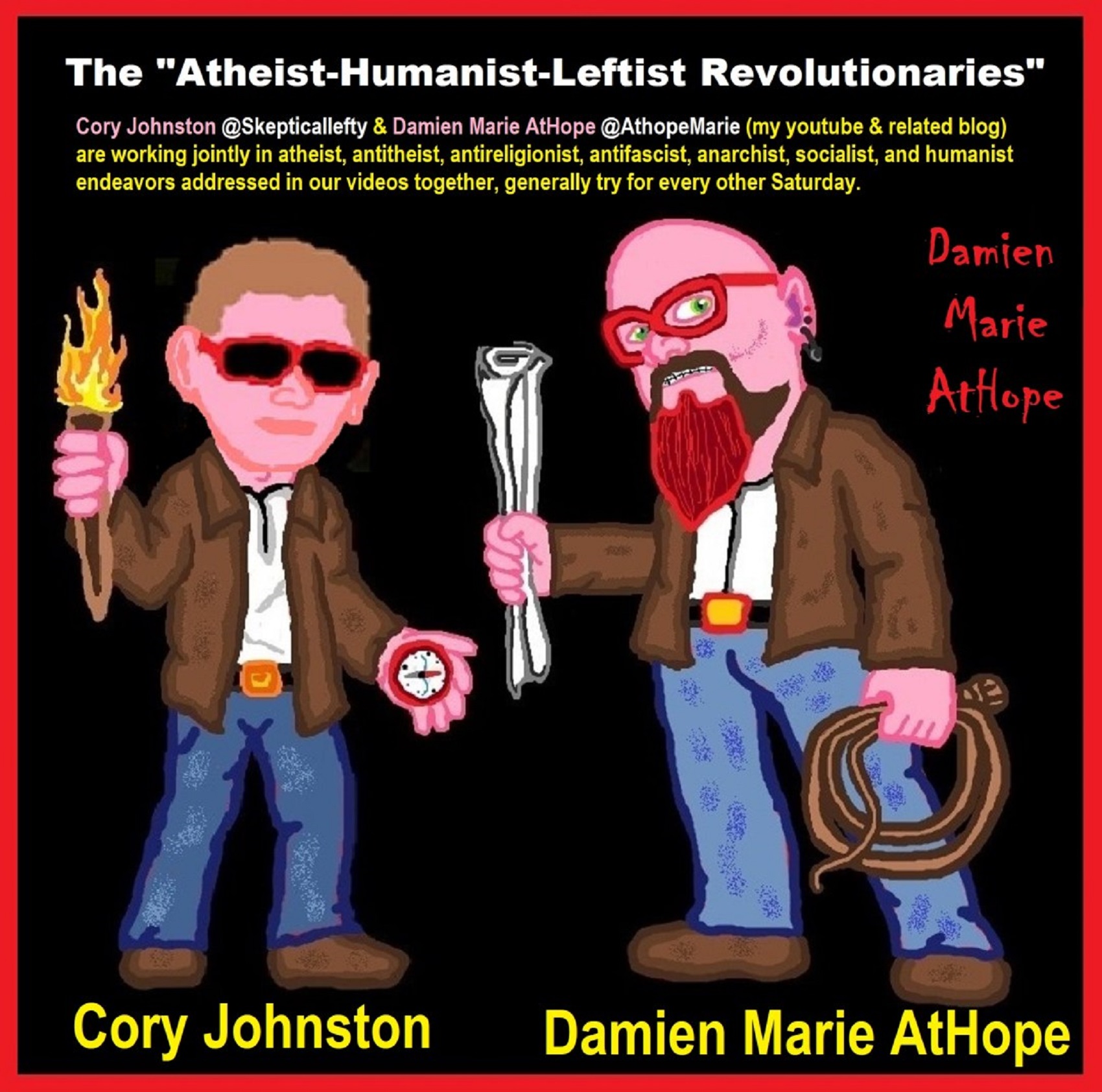
The “Atheist-Humanist-Leftist Revolutionaries”
Cory Johnston ☭ Ⓐ Atheist Leftist @Skepticallefty & I (Damien Marie AtHope) @AthopeMarie (my YouTube & related blog) are working jointly in atheist, antitheist, antireligionist, antifascist, anarchist, socialist, and humanist endeavors in our videos together, generally, every other Saturday.
Why Does Power Bring Responsibility?
Think, how often is it the powerless that start wars, oppress others, or commit genocide? So, I guess the question is to us all, to ask, how can power not carry responsibility in a humanity concept? I know I see the deep ethical responsibility that if there is power their must be a humanistic responsibility of ethical and empathic stewardship of that power. Will I be brave enough to be kind? Will I possess enough courage to be compassionate? Will my valor reach its height of empathy? I as everyone, earns our justified respect by our actions, that are good, ethical, just, protecting, and kind. Do I have enough self-respect to put my love for humanity’s flushing, over being brought down by some of its bad actors? May we all be the ones doing good actions in the world, to help human flourishing.
I create the world I want to live in, striving for flourishing. Which is not a place but a positive potential involvement and promotion; a life of humanist goal precision. To master oneself, also means mastering positive prosocial behaviors needed for human flourishing. I may have lost a god myth as an atheist, but I am happy to tell you, my friend, it is exactly because of that, leaving the mental terrorizer, god belief, that I truly regained my connected ethical as well as kind humanity.
Cory and I will talk about prehistory and theism, addressing the relevance to atheism, anarchism, and socialism.
At the same time as the rise of the male god, 7,000 years ago, there was also the very time there was the rise of violence, war, and clans to kingdoms, then empires, then states. It is all connected back to 7,000 years ago, and it moved across the world.
Cory Johnston: https://damienmarieathope.com/2021/04/cory-johnston-mind-of-a-skeptical-leftist/?v=32aec8db952d
The Mind of a Skeptical Leftist (YouTube)
Cory Johnston: Mind of a Skeptical Leftist @Skepticallefty
The Mind of a Skeptical Leftist By Cory Johnston: “Promoting critical thinking, social justice, and left-wing politics by covering current events and talking to a variety of people. Cory Johnston has been thoughtfully talking to people and attempting to promote critical thinking, social justice, and left-wing politics.” http://anchor.fm/skepticalleft
Cory needs our support. We rise by helping each other.
Cory Johnston ☭ Ⓐ @Skepticallefty Evidence-based atheist leftist (he/him) Producer, host, and co-host of 4 podcasts @skeptarchy @skpoliticspod and @AthopeMarie
Damien Marie AtHope (“At Hope”) Axiological Atheist, Anti-theist, Anti-religionist, Secular Humanist. Rationalist, Writer, Artist, Poet, Philosopher, Advocate, Activist, Psychology, and Armchair Archaeology/Anthropology/Historian.
Damien is interested in: Freedom, Liberty, Justice, Equality, Ethics, Humanism, Science, Atheism, Antiteism, Antireligionism, Ignosticism, Left-Libertarianism, Anarchism, Socialism, Mutualism, Axiology, Metaphysics, LGBTQI, Philosophy, Advocacy, Activism, Mental Health, Psychology, Archaeology, Social Work, Sexual Rights, Marriage Rights, Woman’s Rights, Gender Rights, Child Rights, Secular Rights, Race Equality, Ageism/Disability Equality, Etc. And a far-leftist, “Anarcho-Humanist.”
I am not a good fit in the atheist movement that is mostly pro-capitalist, I am anti-capitalist. Mostly pro-skeptic, I am a rationalist not valuing skepticism. Mostly pro-agnostic, I am anti-agnostic. Mostly limited to anti-Abrahamic religions, I am an anti-religionist.
To me, the “male god” seems to have either emerged or become prominent around 7,000 years ago, whereas the now favored monotheism “male god” is more like 4,000 years ago or so. To me, the “female goddess” seems to have either emerged or become prominent around 11,000-10,000 years ago or so, losing the majority of its once prominence around 2,000 years ago due largely to the now favored monotheism “male god” that grow in prominence after 4,000 years ago or so.
My Thought on the Evolution of Gods?
Animal protector deities from old totems/spirit animal beliefs come first to me, 13,000/12,000 years ago, then women as deities 11,000/10,000 years ago, then male gods around 7,000/8,000 years ago. Moralistic gods around 5,000/4,000 years ago, and monotheistic gods around 4,000/3,000 years ago.
To me, animal gods were likely first related to totemism animals around 13,000 to 12,000 years ago or older. Female as goddesses was next to me, 11,000 to 10,000 years ago or so with the emergence of agriculture. Then male gods come about 8,000 to 7,000 years ago with clan wars. Many monotheism-themed religions started in henotheism, emerging out of polytheism/paganism.
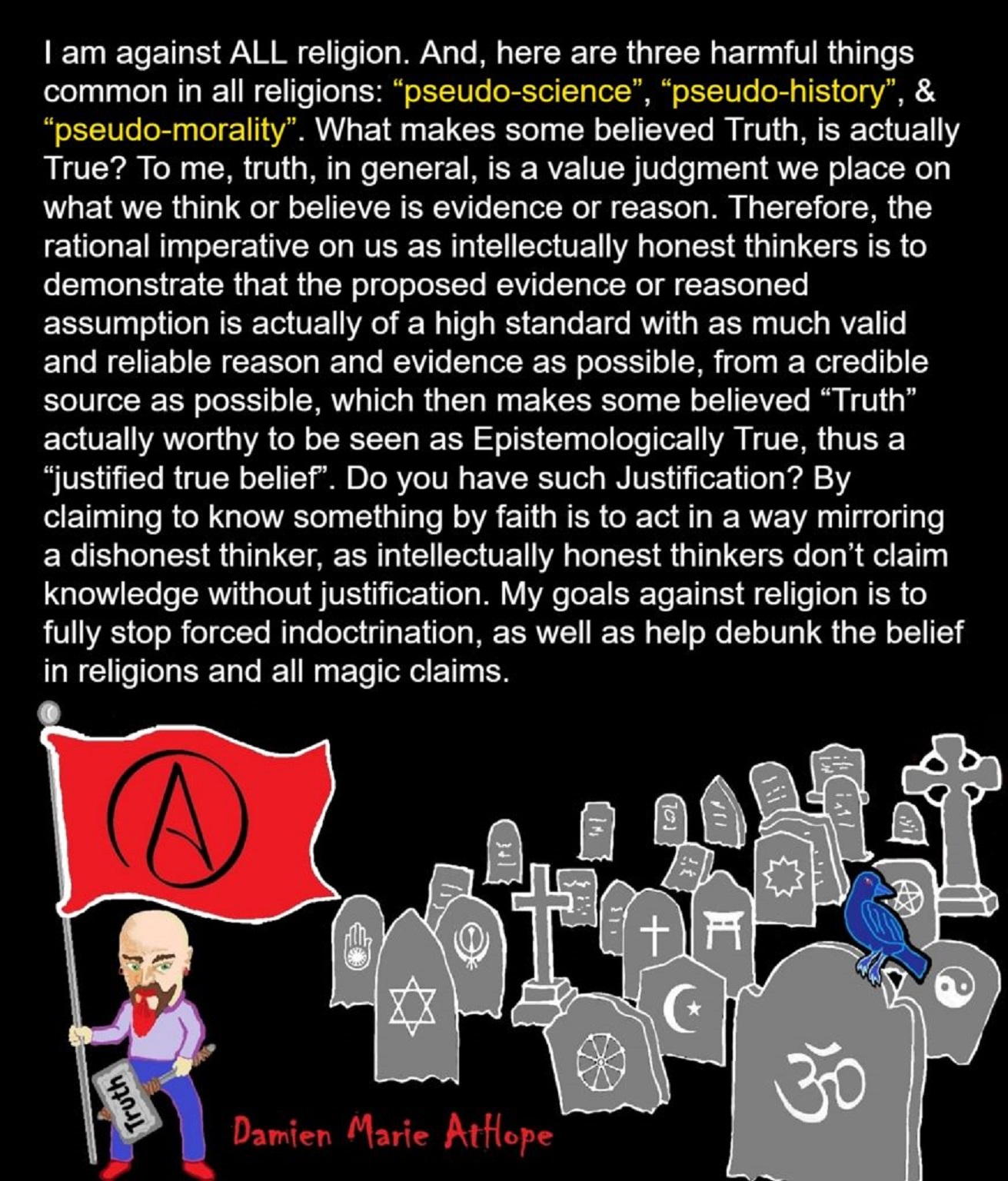

Damien Marie AtHope (Said as “At” “Hope”)/(Autodidact Polymath but not good at math):
Axiological Atheist, Anti-theist, Anti-religionist, Secular Humanist, Rationalist, Writer, Artist, Jeweler, Poet, “autodidact” Philosopher, schooled in Psychology, and “autodidact” Armchair Archaeology/Anthropology/Pre-Historian (Knowledgeable in the range of: 1 million to 5,000/4,000 years ago). I am an anarchist socialist politically. Reasons for or Types of Atheism
My Website, My Blog, & Short-writing or Quotes, My YouTube, Twitter: @AthopeMarie, and My Email: damien.marie.athope@gmail.com

